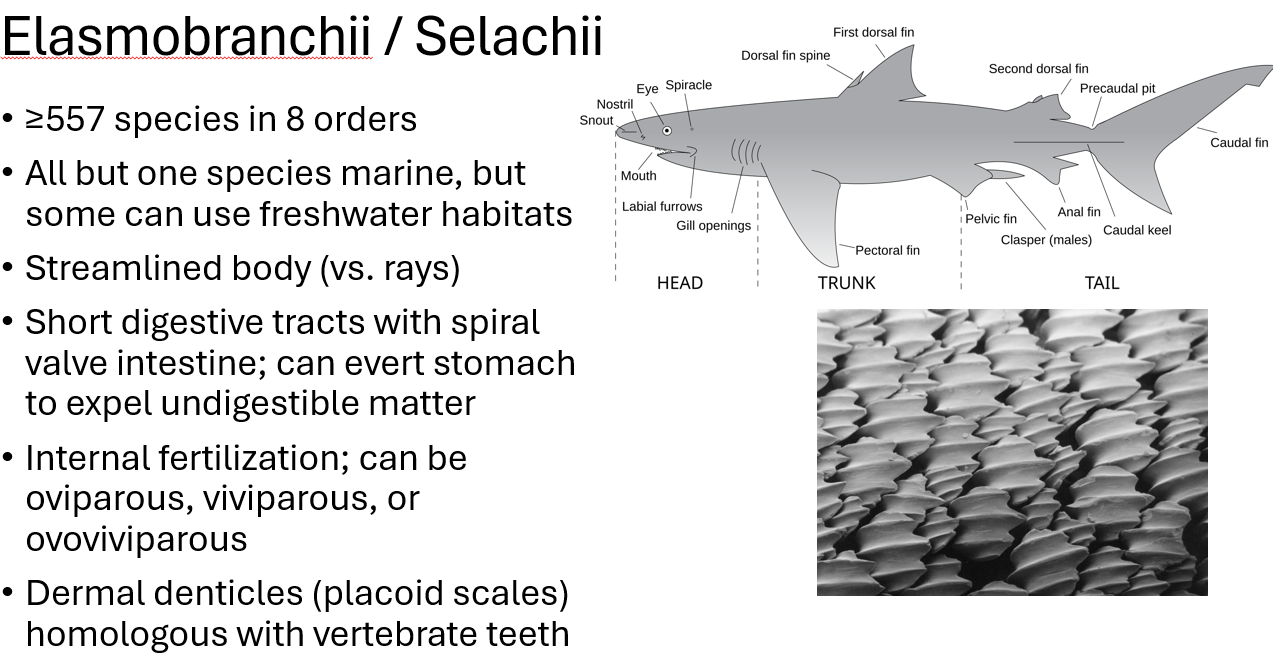Zoology Unit 3
1/192
There's no tags or description
Looks like no tags are added yet.
Name | Mastery | Learn | Test | Matching | Spaced |
|---|
No study sessions yet.
193 Terms
Lobe-finned fish are and appeared when
Sarcoptergyii; late Silurian (~425 Mya)
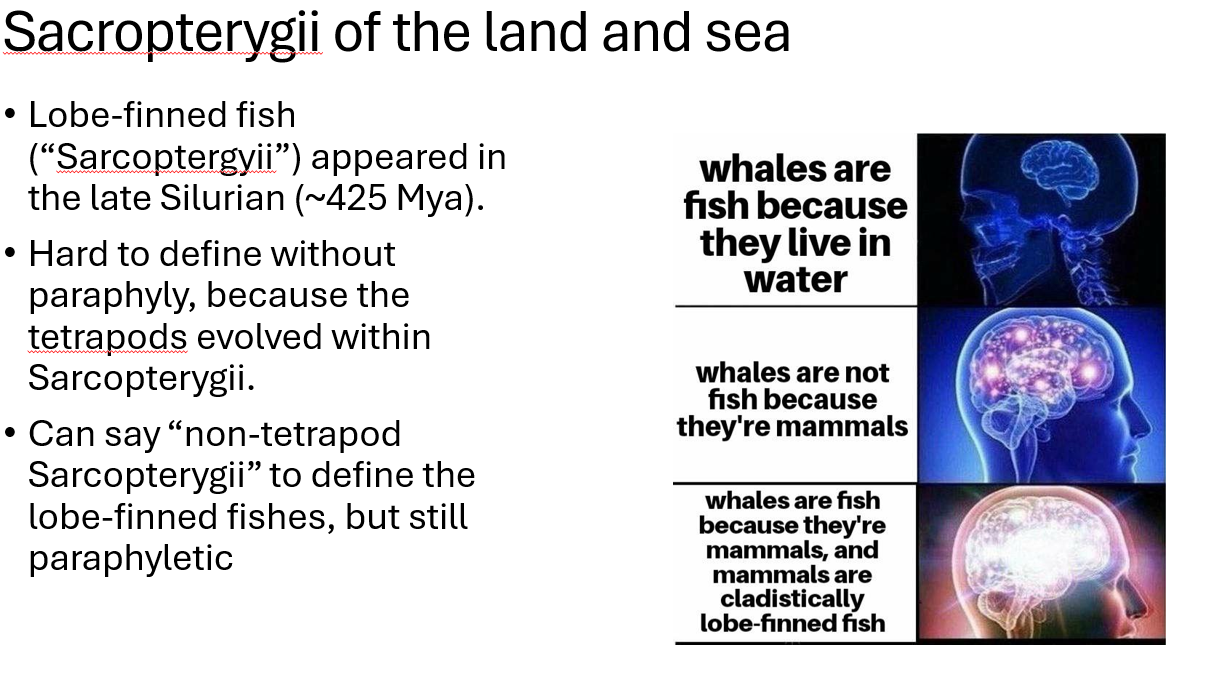
why is Sarcopterygii hard to define without paraphyly
because the tetrapods evolved within Sarcopterygii. Can say “non-tetrapod Sarcopterygii” to define the lobe-finned fishes, but still paraphyletic

What biologists who understand phylogenetics mean by “Sarcopterygii”
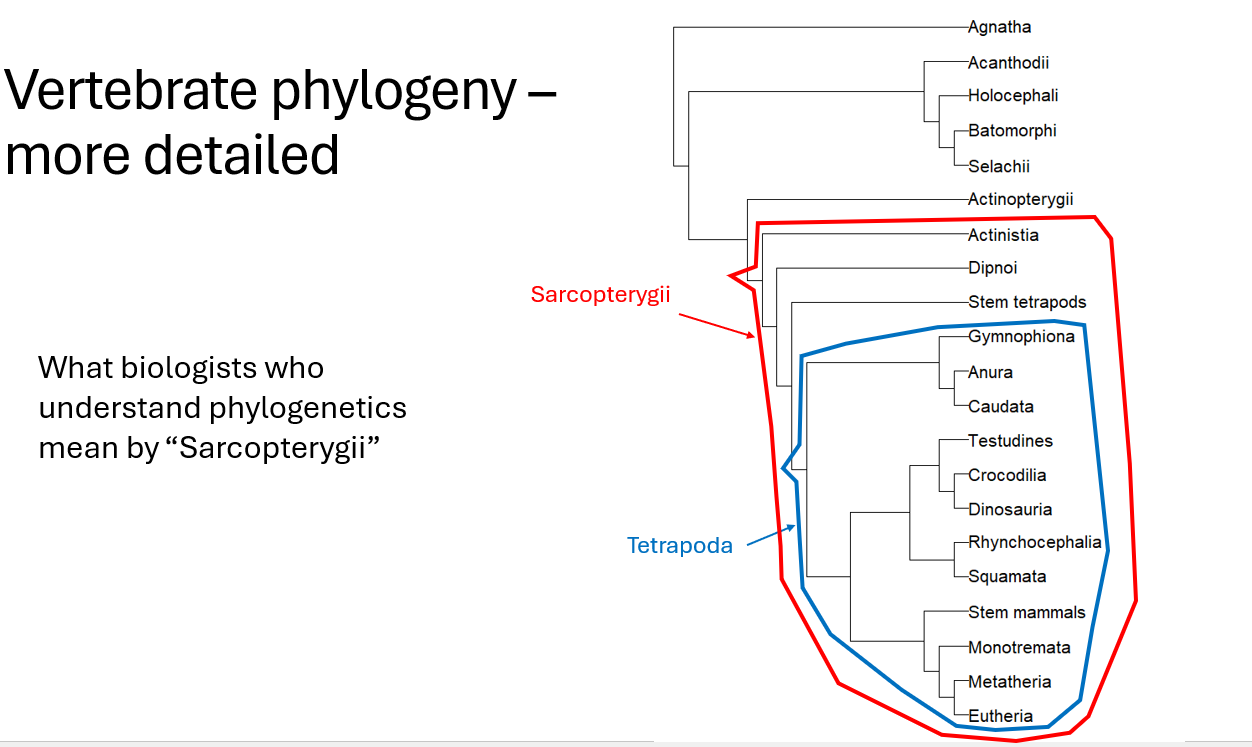
Total group Sarcopterygii includes (ARDT)
actinistia/coelacanths, rhipidistia=tetrapoda+dipnoi, dipnoi (modern lungfish),tetrapodamorpha=tetrapods and their stem group
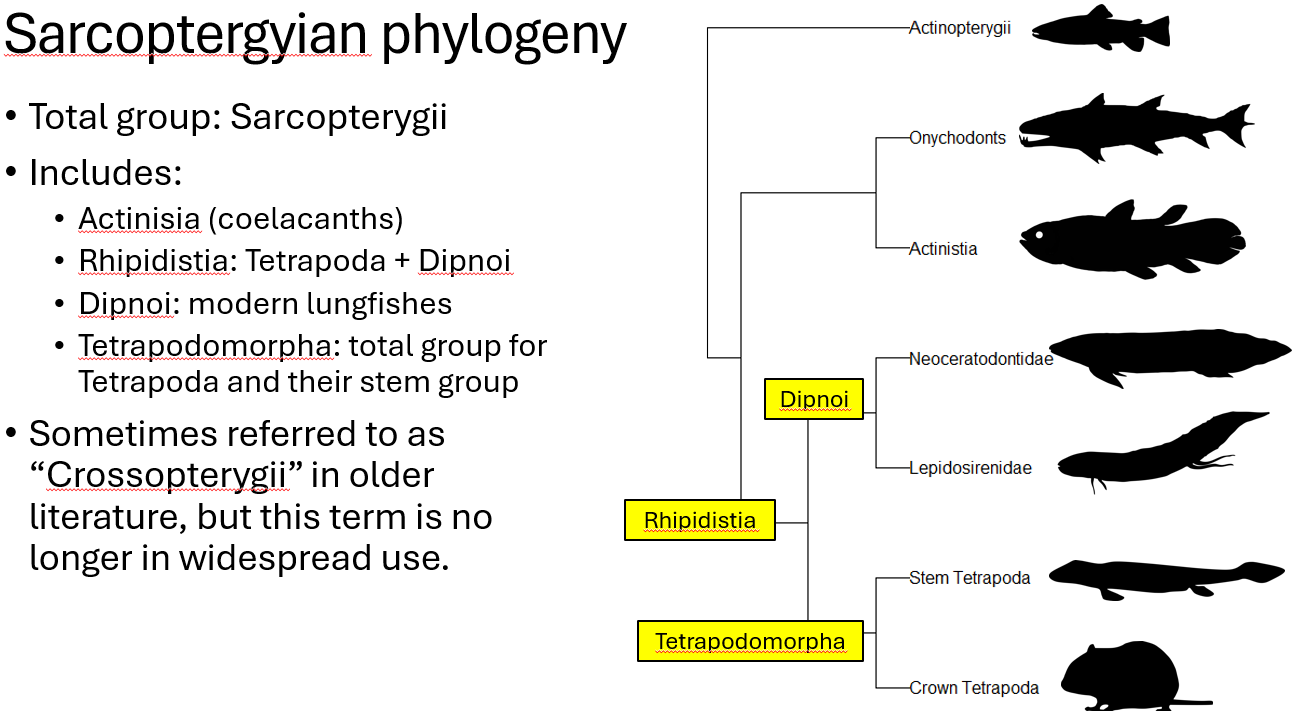

Sarcopterygii characteristics (PA2TCCI)
•Paired pectoral and pelvic fins with internal skeletal structure, joints, and muscles
•Appendicular skeletons to anchor fins (girdles)
•(Ancestrally) 2 dorsal fins
•Teeth coated in enamel
•(Ancestrally) Cosmoid scales: layers of lamellar, vascular bone; cosmine (similar to dentin), keratin or enamel layer outside.
Internal nares (convergent)
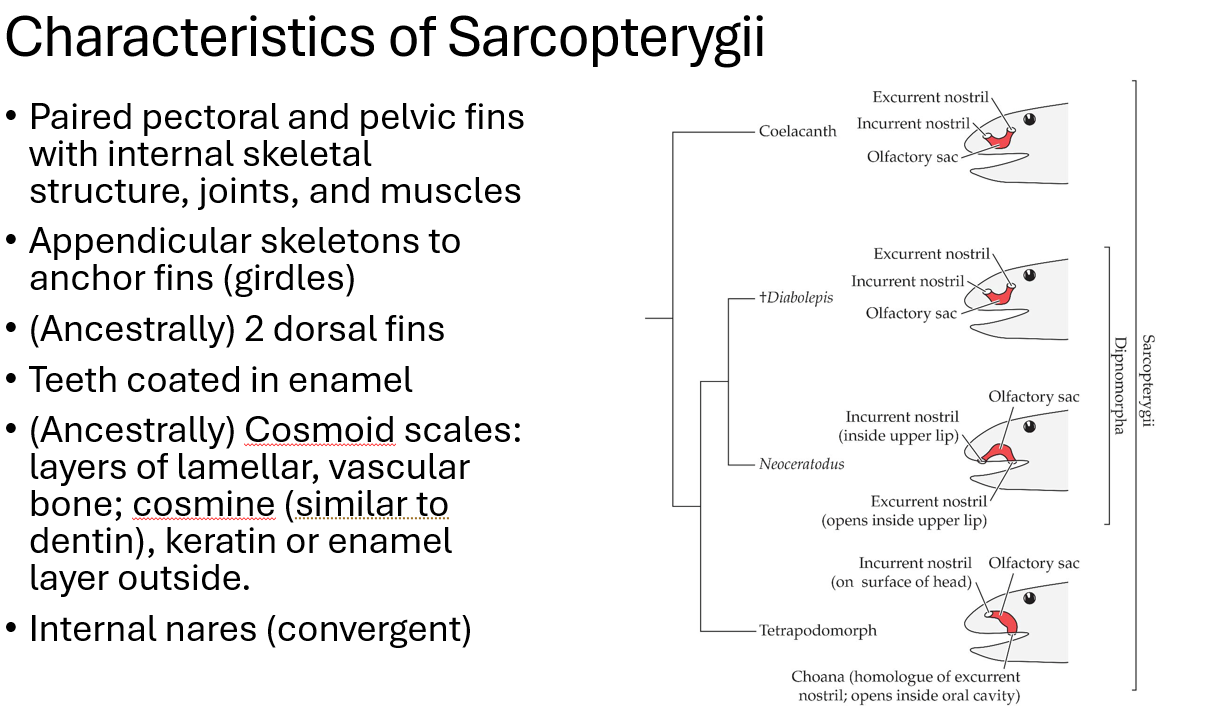
in modern day sarcopterygians some lungfishes have internal nares that don’t go from nostrils to throat but instead
front of mouth to back of the mouth
sarcopterygii vs actinopterygian meaning
fleshy, muscular fin vs ray finned fish
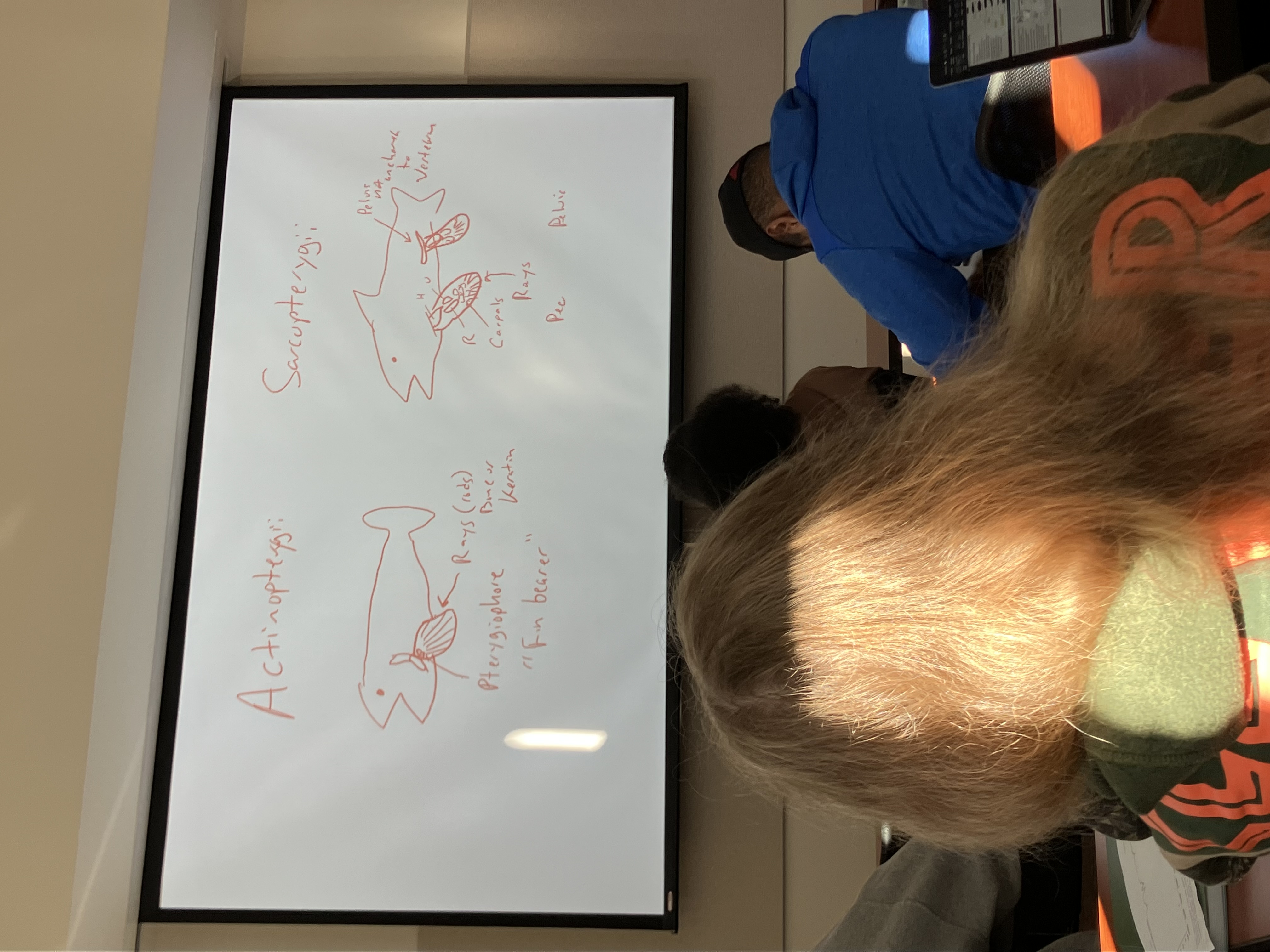
sarcopterygians have a pelvis but
it isn’t connected to their vertebral column
Are sarcopterygians extinct and what group overtook sarcopterygians in the early devonian and why
Excluding tetrapods, most sarcopterygians are extinct and sarcopterygians were most diverse group of fishes in the early Devonian, until overtaken by ray-finned fish (Actinopterygii). Very few survived Great Dying
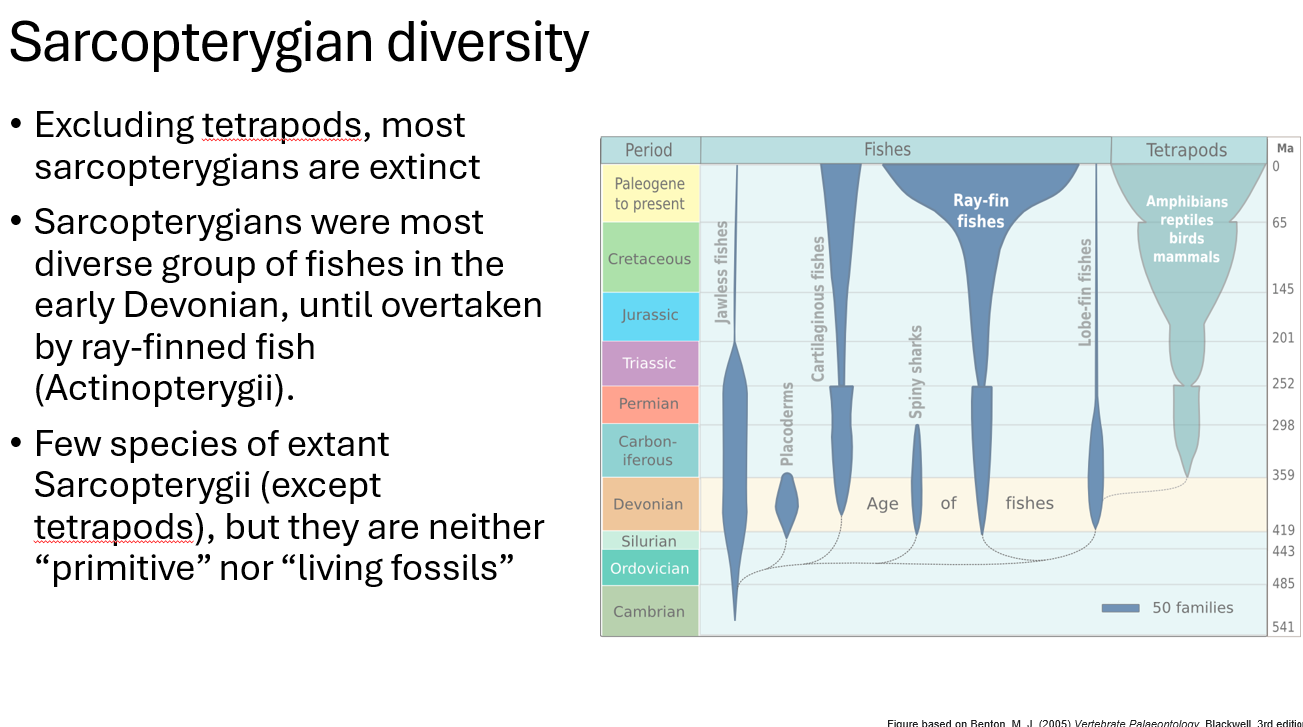
Second species rediscovered in 1990s in Indonesia in a fish market
coelocanths
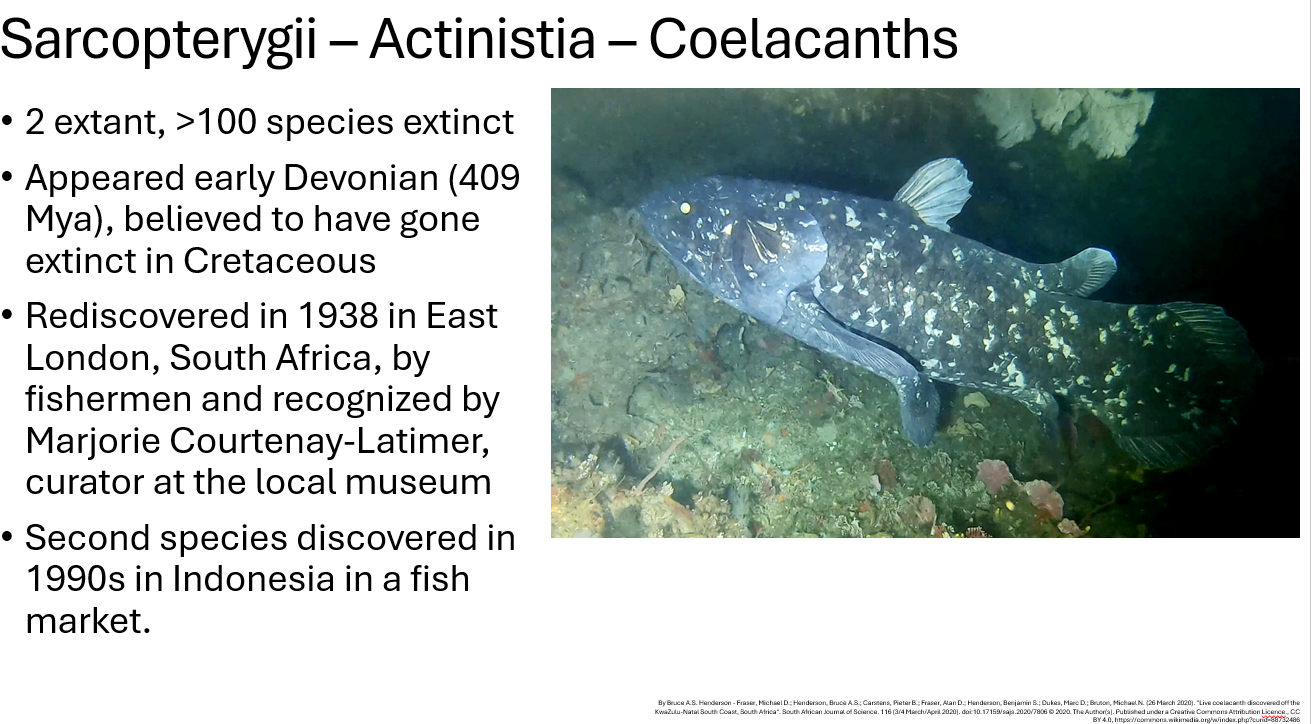
•2 extant >100 species extinct
•Appeared early Devonian (409 Mya), believed to have gone extinct in Cretaceous
•Rediscovered in 1938 in East London, South Africa, by fishermen and recognized by Marjorie Courtenay-Latimer, curator at the local museum
coelocanths
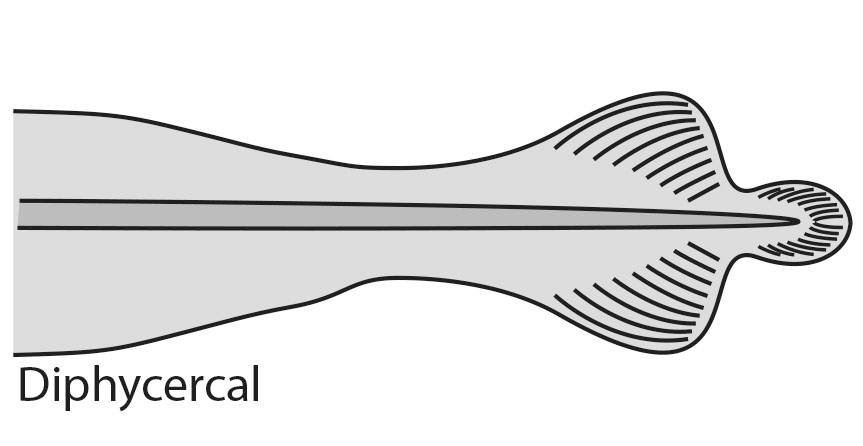
Coelocanths traits (LILNLCDOSVP)
•Large, long-lived lobe-finned fish (up to 100 years, mature around 55)
•Intracranial joint/hinge in the skull tht allows snout to lift independently of the back of the skull
•Notochord persists, little ossification of vertebral column
•Cosmoid scales
•Diphycercal tail/3 lobed fin
•Oil-filled swim bladder/sac used for buoyancy
•Spiral valve intestine (like sharks)
•Vestigial, nonfunctional lung
•Partial interatrial septum/partial divider in atrium
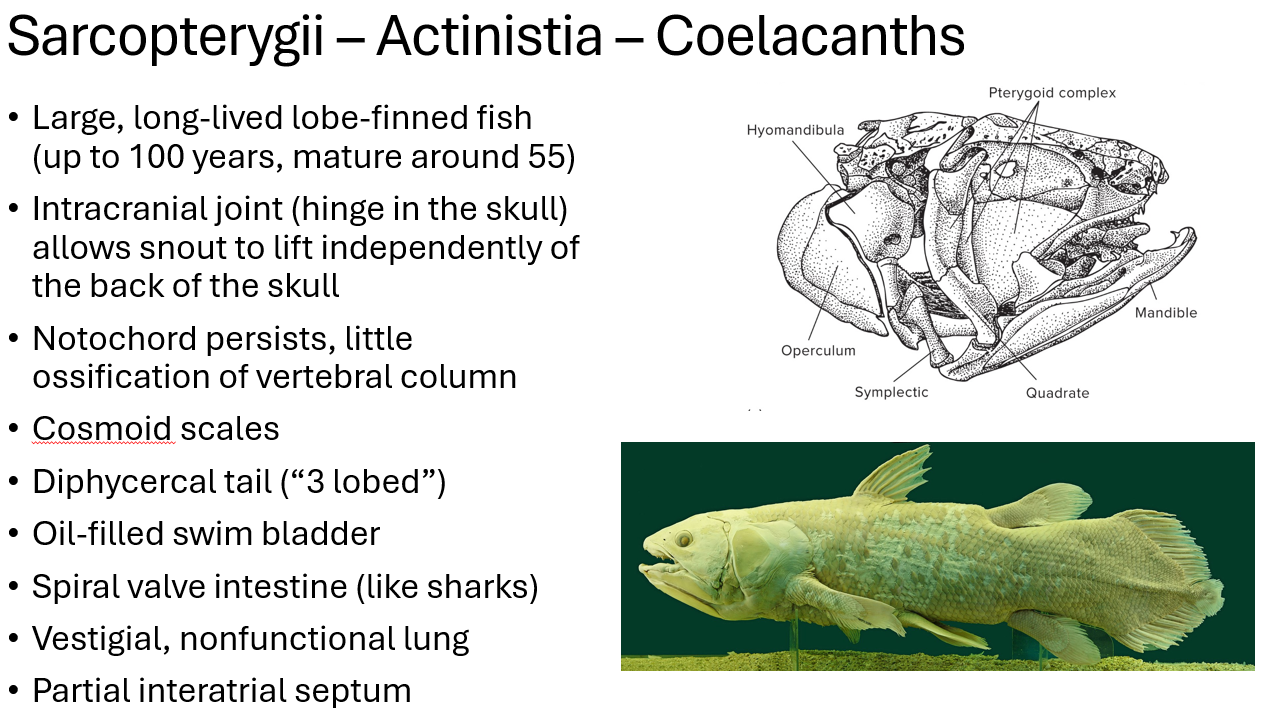
without an interatrial septum, what will happen to the blood
oxygen rich and oxygen poor blood will mix
spiral valve of coelocanths is for
so they have a large intenstine without it taking up too much space
swim bladder in coelocanths vs ray finned fish filled with
oil vs air
coelocanth meaning
coel- means cavity/space and canth means spiny, so hollow spines
modern coelocanths lost choanae because
mainly due to adapting to aquatic life
Clade that includes Dipnoi (lungfishes) and tetrapodomorphs
Rhipidistia
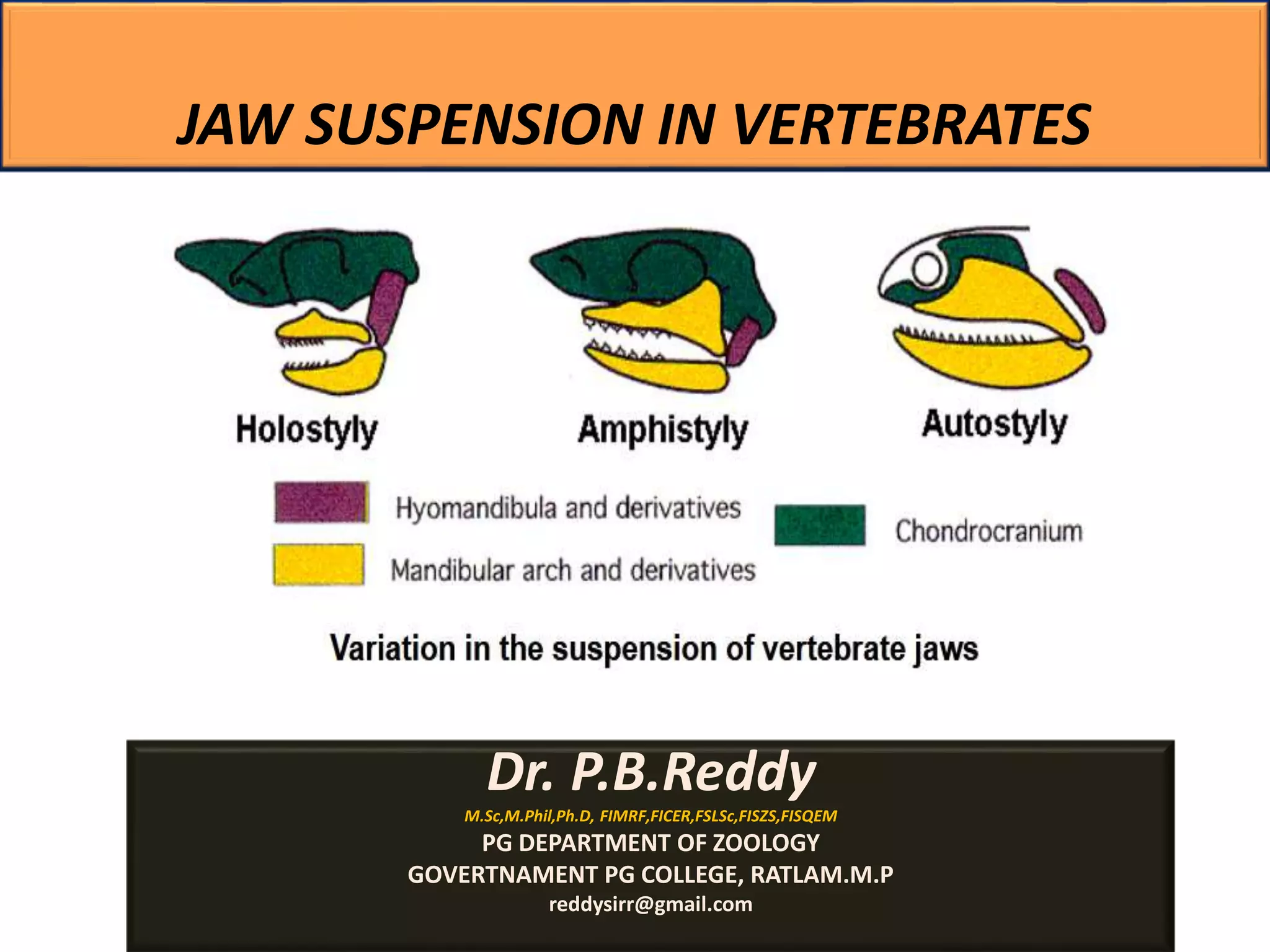
Rhipidistia traits (DLAC)
•Divided atrium in heart
•“Lymph heart”
•Autostylic jaw suspension (palatoquadrate fuses to cranium)
•Choanae evolved independently in Dipnoi and tetrapodomorphs
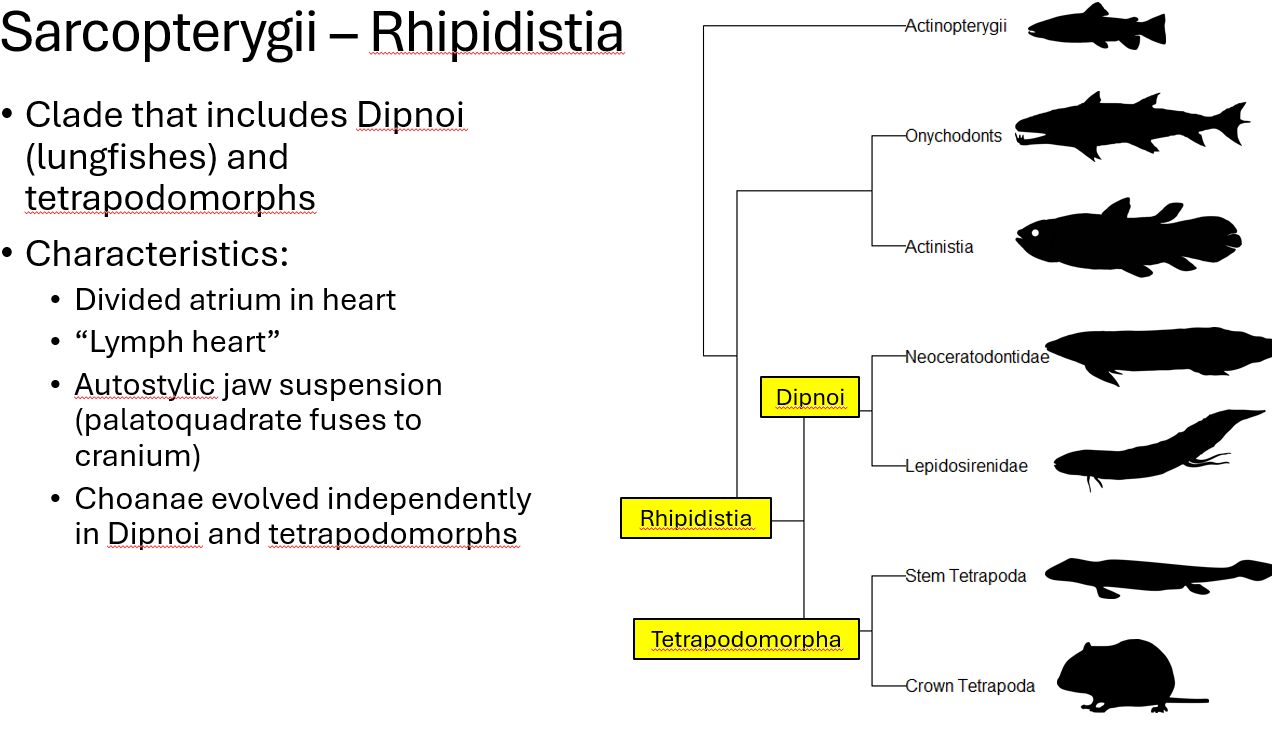
we have 2 ventricles and atria while ancestral vertebrates only have
1 of each
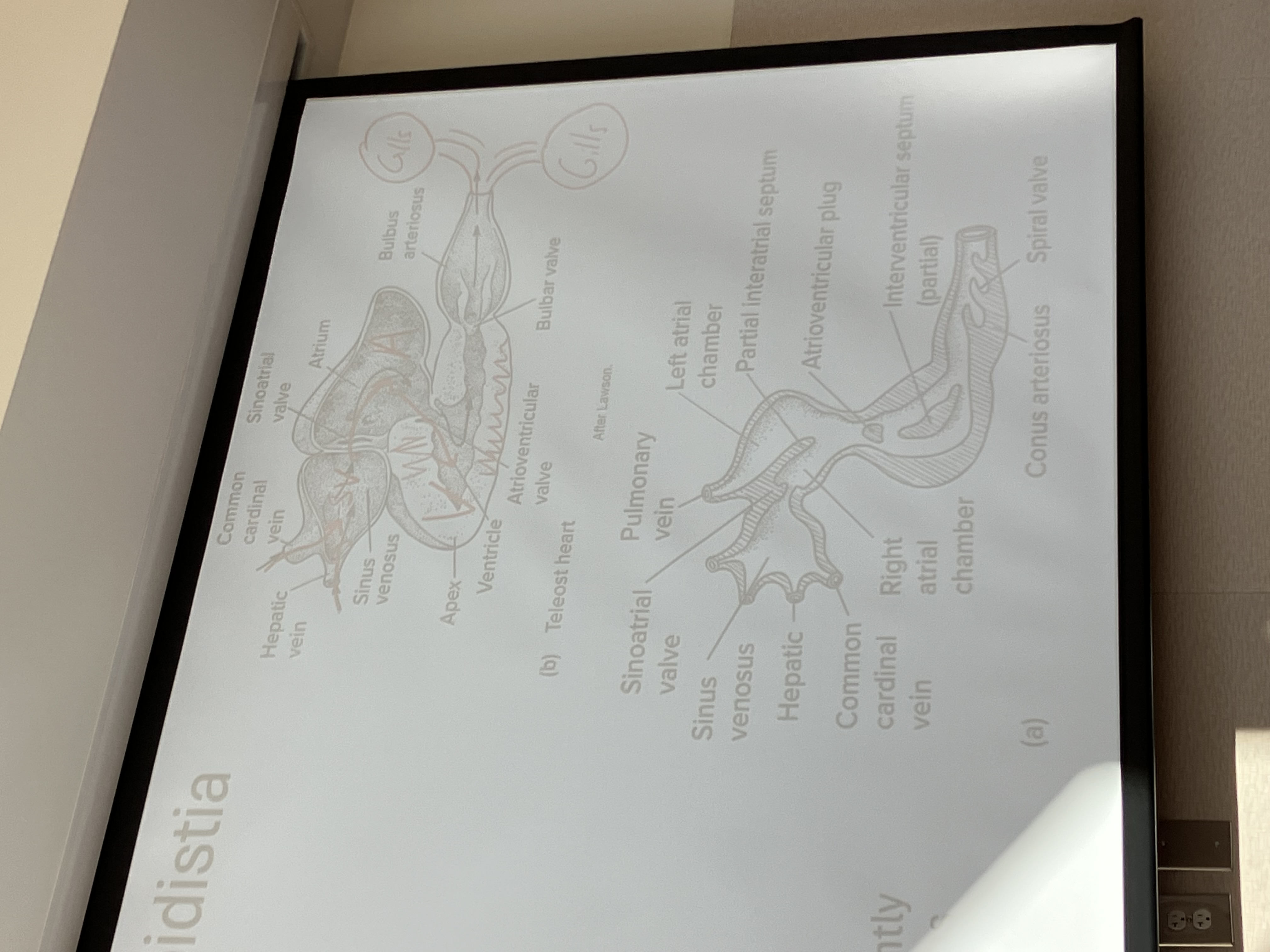
largest chamber of the heart in ancestral vertebrates
the ventricle
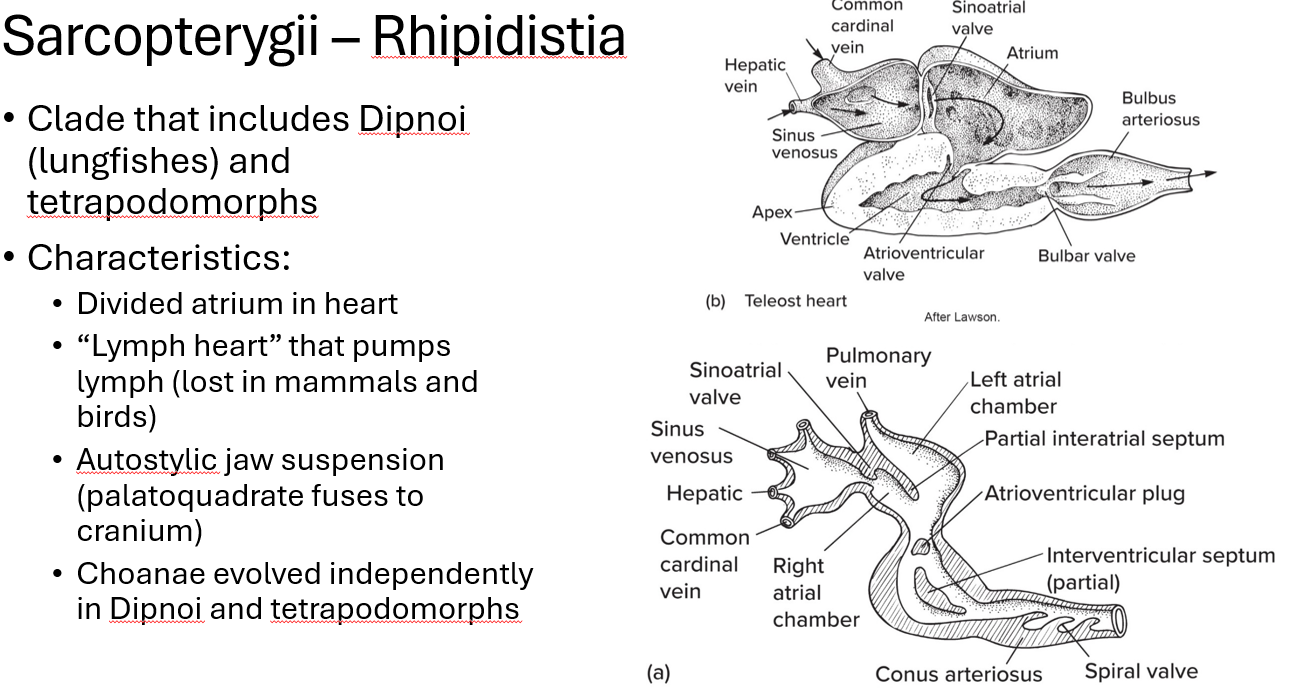
why do all the chambers have oxygen poor blood in a fish heart
the respiratory organ (the gills) is immediately after the heart

•6 species of them in Africa, Australia, South America
•Appear in Devonian (410 Mya)
•Originally marine, extant species mostly freshwater
dipnoi
dipnoi characteristics (CPCL)
•Cartilaginous notochord
•Palatal teeth in fan-shaped plates (odontodes)
•Convergently evolved choanae
•Lungs
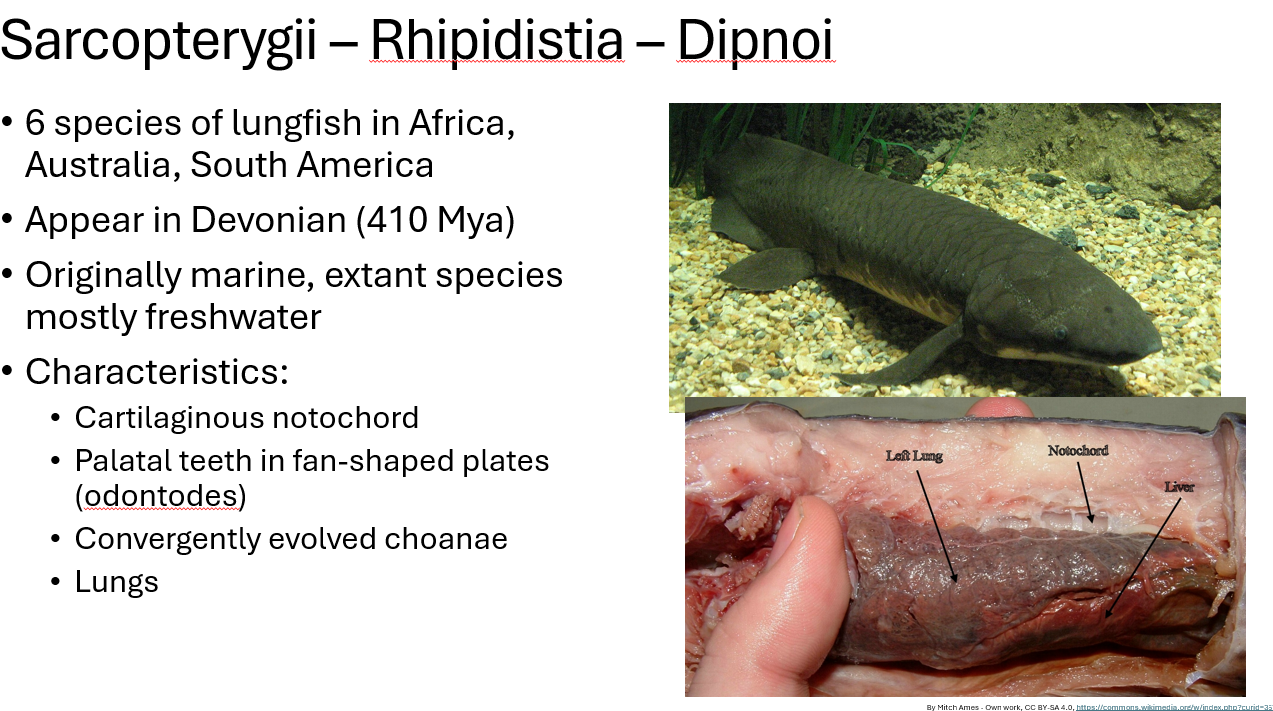
3 families of lungfish
neoceratodontidae/australian lungfish, south american, african
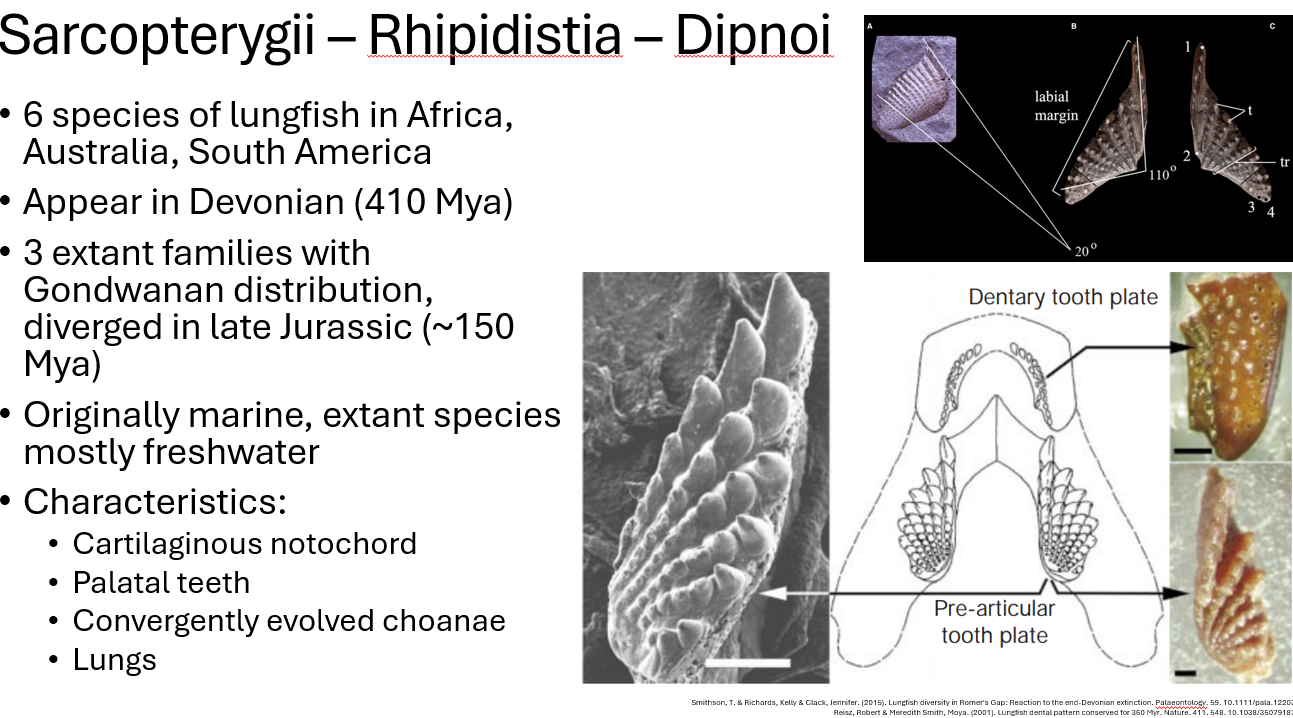
neoceratodontidae traits (SLEMD)
•Single unpaired lung
•Large, lobed fins
•External gills absent in adults
•More cranial bones retained
•Does NOT estivate
1 species of Australian lungfish, Neoceratodus forsteri
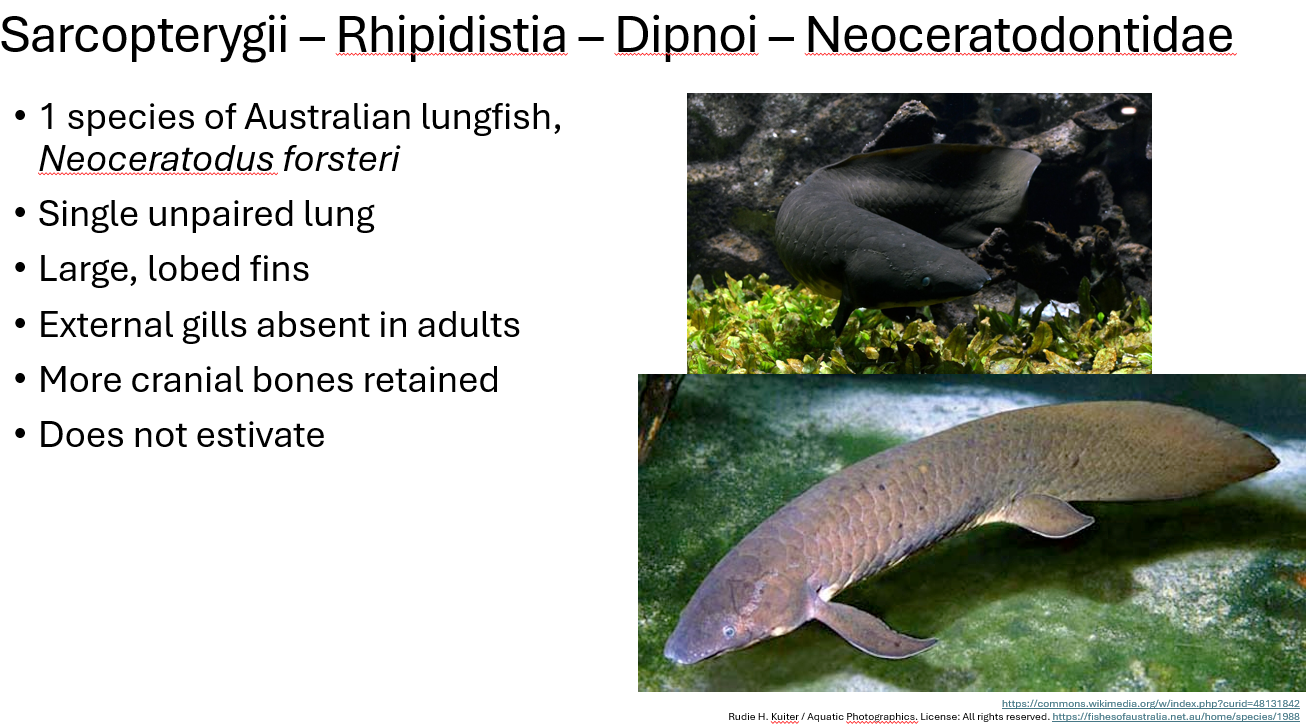
Lepidosirenidae (OPASPF)
•Obligate air breather
•Paired lungs
•Aestivates during dry season
•Skeleton weakly ossified with
premaxilla lost
fins reduced and filamentous
1 species of South American lungfish, Lepidosiren paradoxa
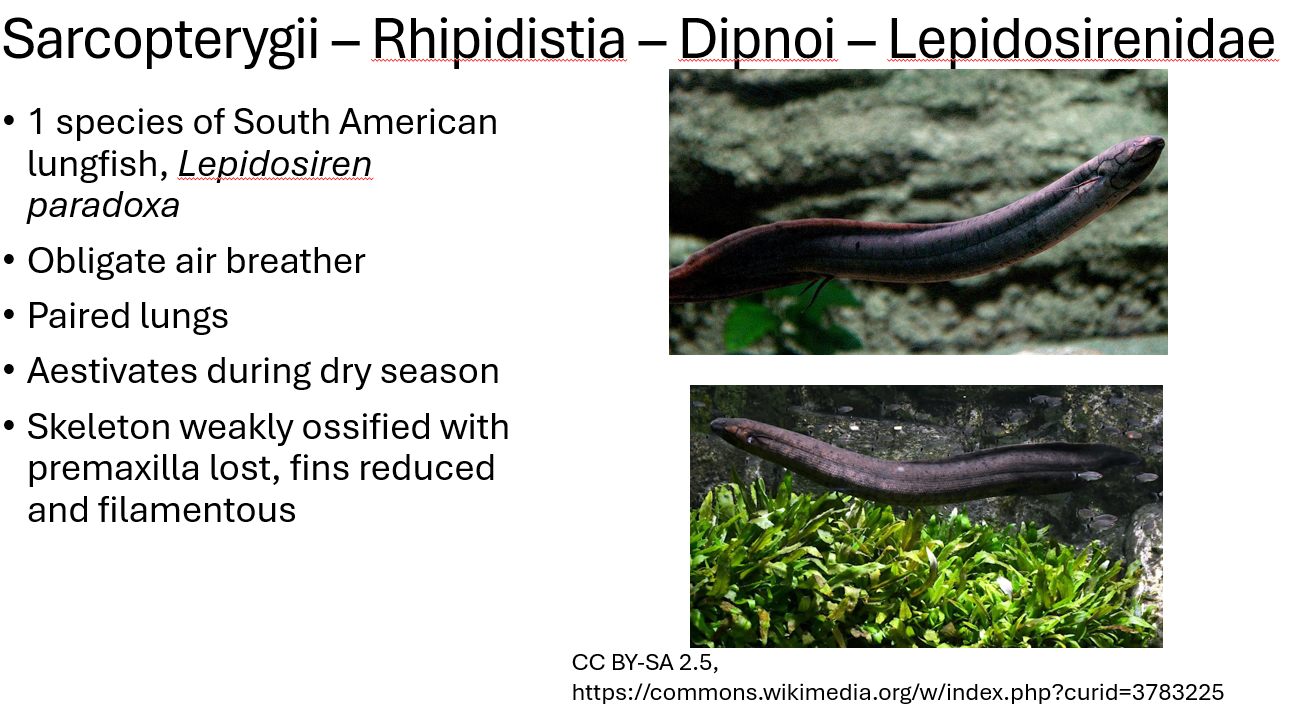
Protopteridae traits (PGAT)
•4 species of African lungfish, Protopterus
•Paired lungs
•Greatly reduced fins
•Aestivates during dry season
•Tooth plates fused into ridged crushing plates
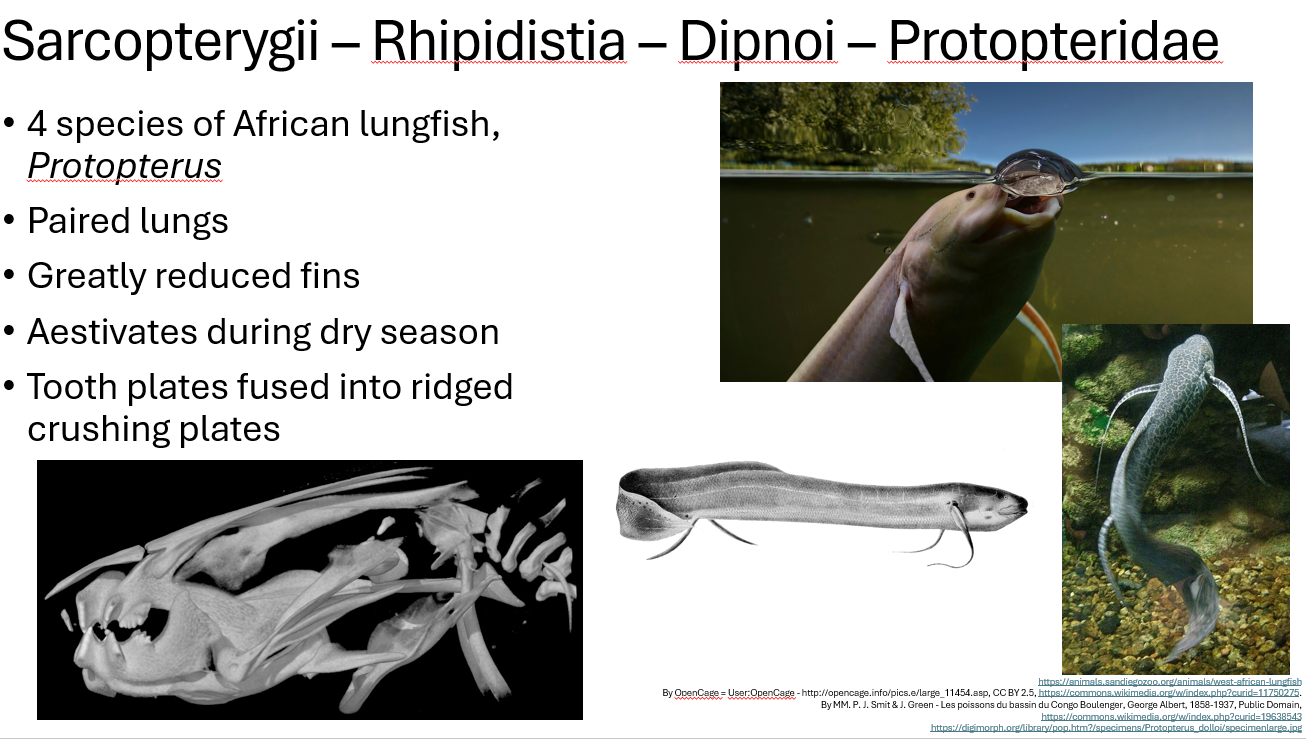
•Brownstein et al. (2023) correlated DNA sequences with geographic events to investigate the
diversification of lungfishes, found that splits between families mirror splits between parts of Gondwana
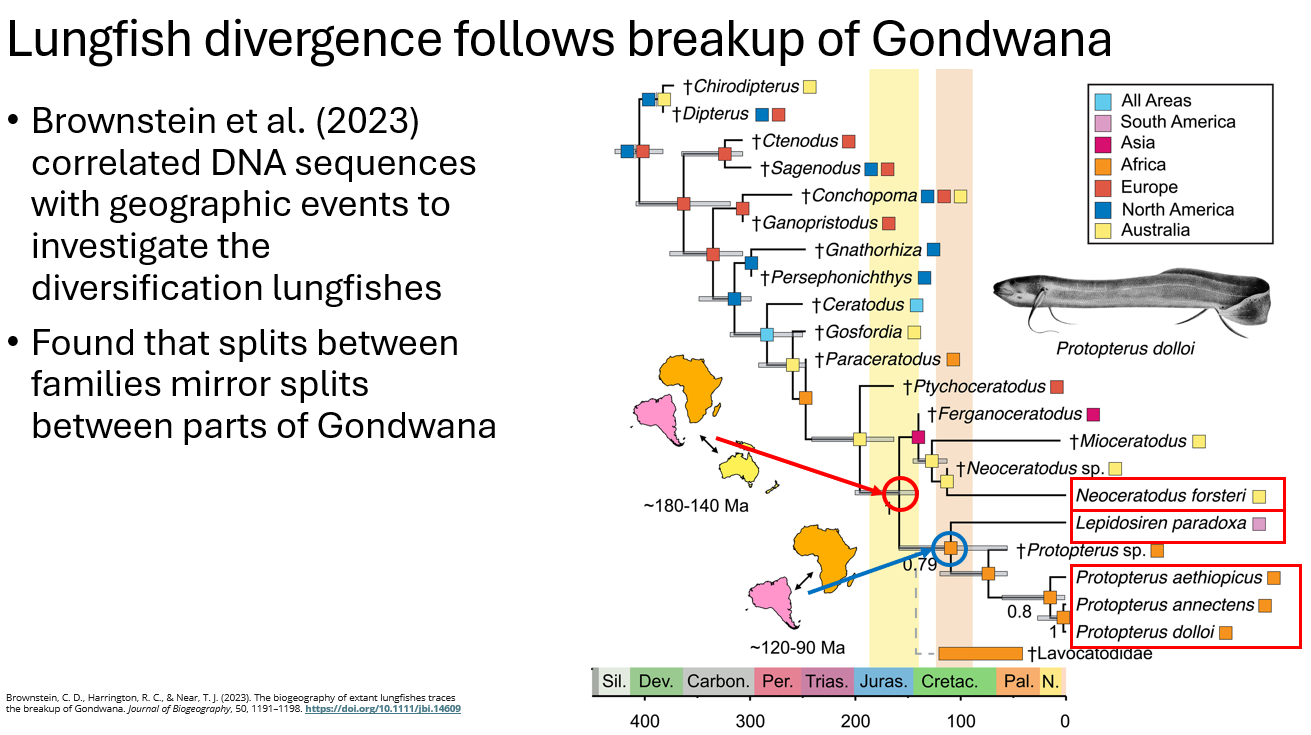
sarcopterygii + actinopterygii =
osteichthyes
Actinopterygii is monophyletic sister clade to
Sarcopterygii
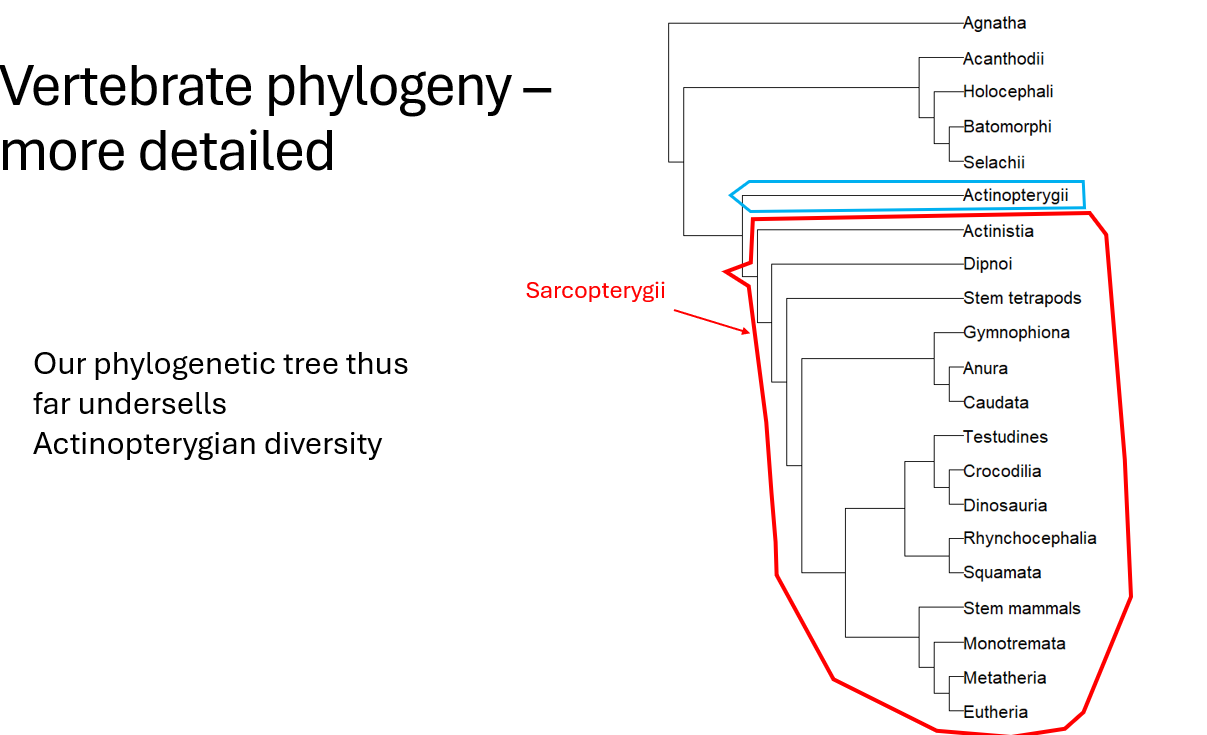
•Ray-finned fish split from lobe-finned fish in the late Silurian (~425 Mya).
•>50% of all extant Vertebrata species
actinopterygii
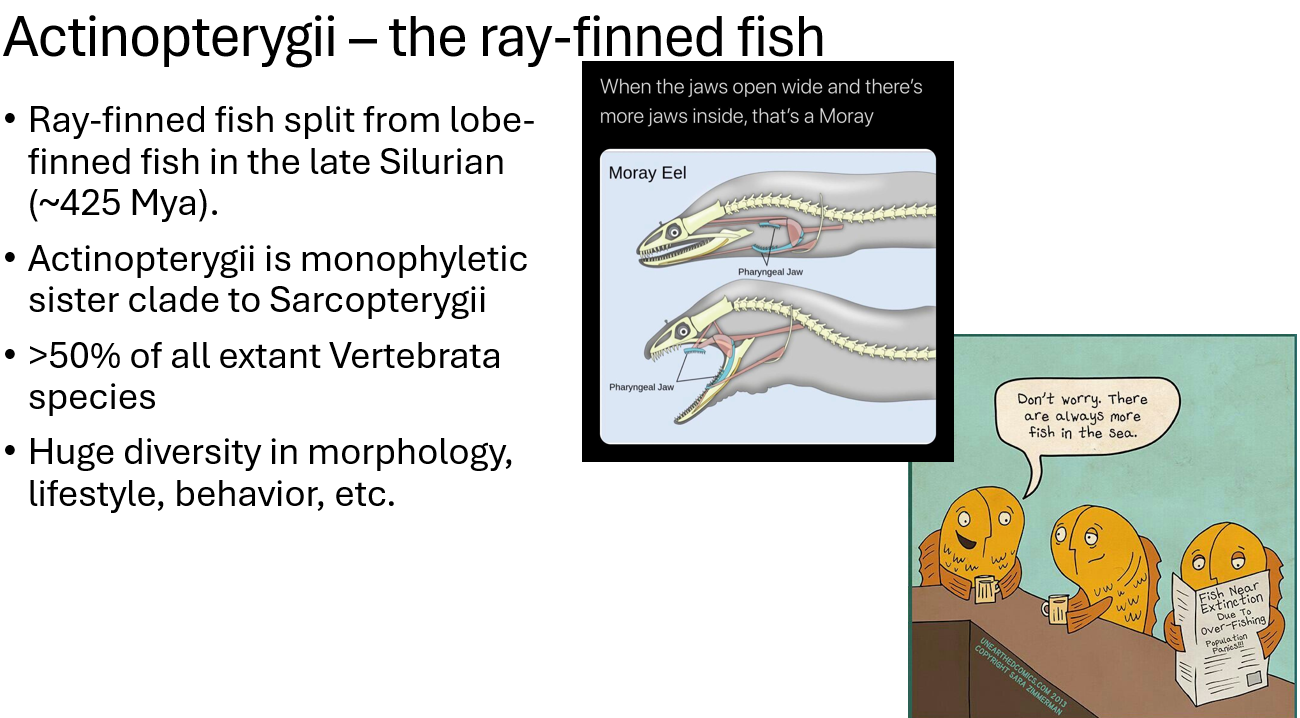
•Our phylogenetic tree thus far undersells Actinopterygian diversity.
•So, let’s collapse Sarcopterygii…
•…and expand Actinopterygii.
•…really expand it.
•Actinopterygii contains nearly 30,000 species in at least 50 orders.
•≥ 26,000 species and ≈ 40 orders are in clade Teleostei
•17,000 species and 26 of those orders are just in clade Percomorpha!
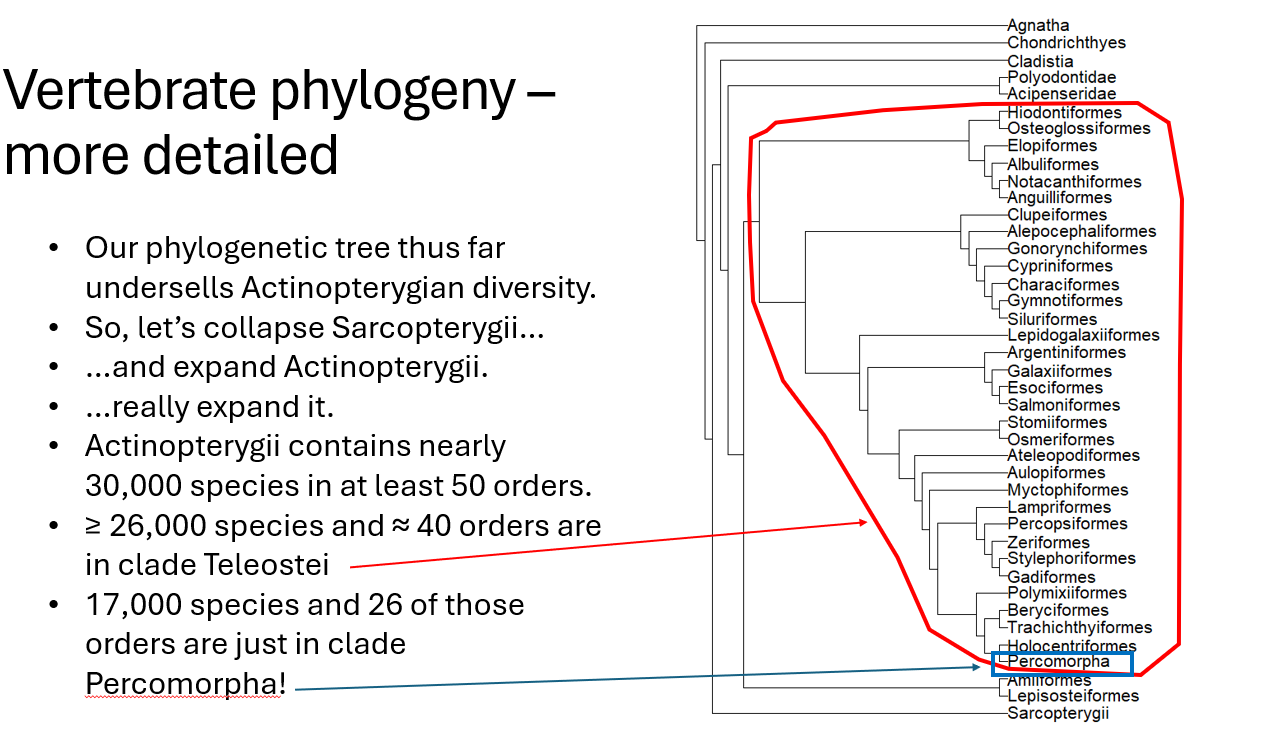
phylogenetic common names
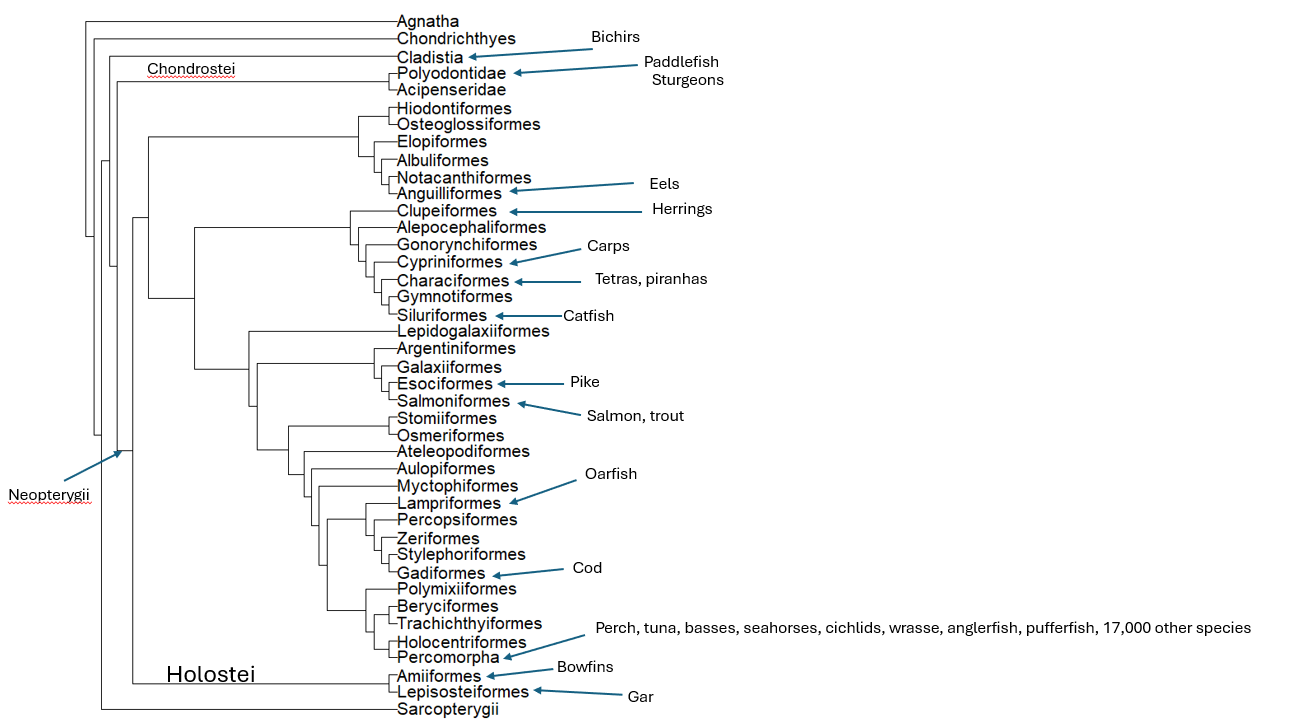
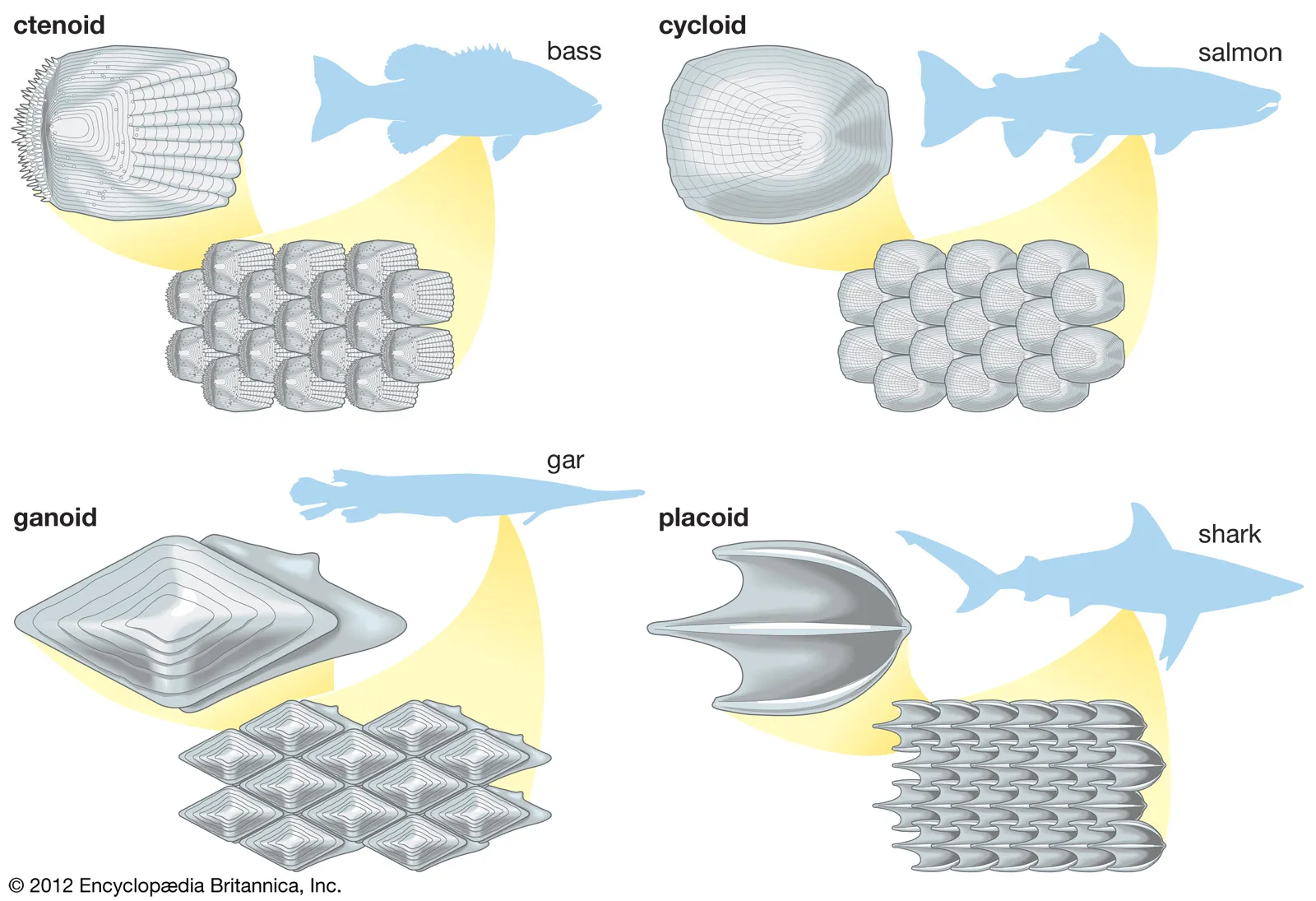
Actinopterygii traits (FSMSSMOT)
•Fin rays made of lepidotrichia (dermal bone or cartilage)
support fins; can be straight or branched, but never jointed; muscles extrinsic to/outside the fin itself
•Scales ganoid (ancestral) to cycloid/ctenoid (derived)
•Single dorsal fin (ancestral); duplicated in some groups
•Mobile premaxilla and maxilla (esp. Teleosts)
•Opercular bones cover gill arches
•Tail heterocercal/asymmetrical (ancestral) to homocercal/symmertrical (derived)
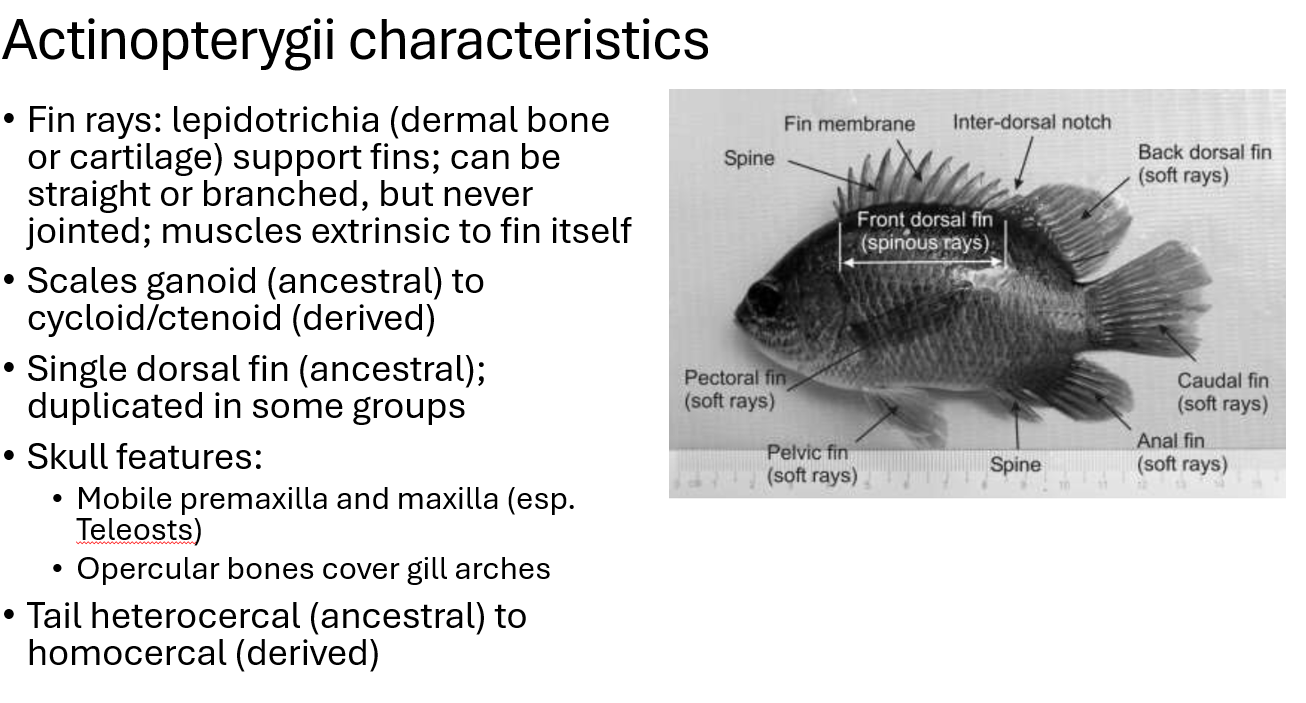
what helps Actinopterygii with suction feeding
the mobile premaxilla and maxilla allows it to snap its jaw open and closed really fast

pelvic fins can be anywhere in ray finned fishes because
their spine is not connected to pelvic girdle
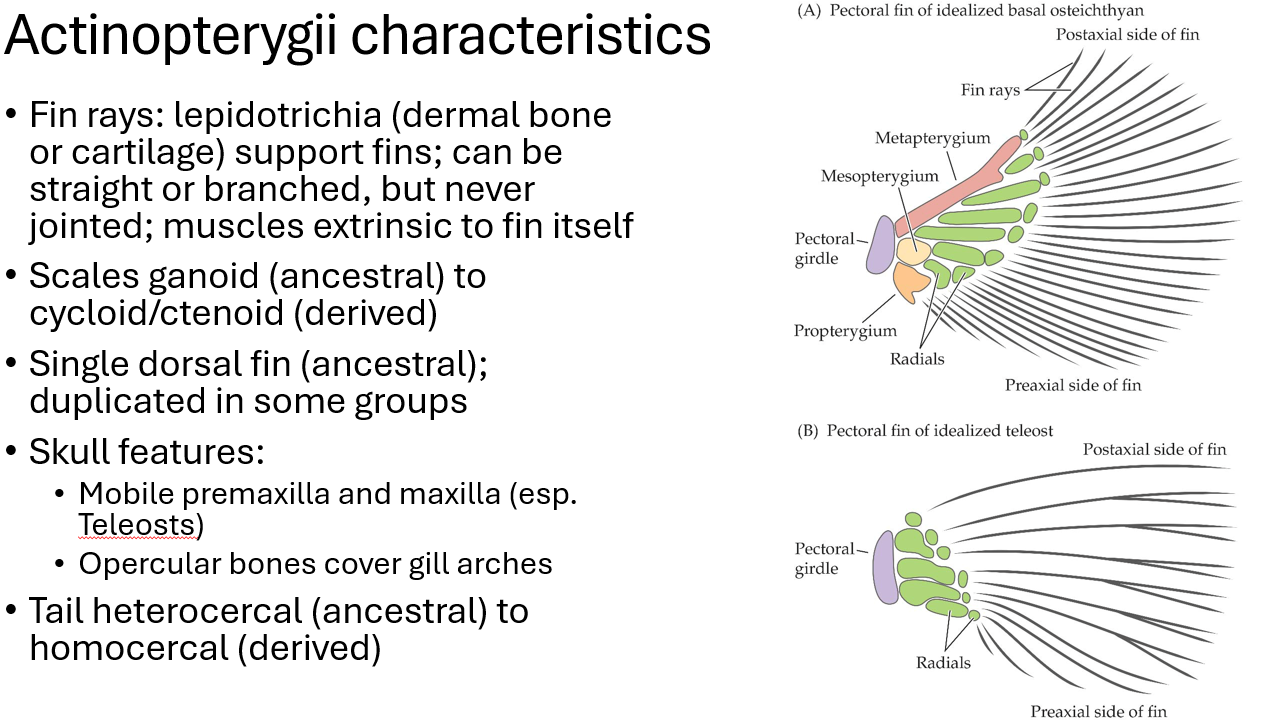
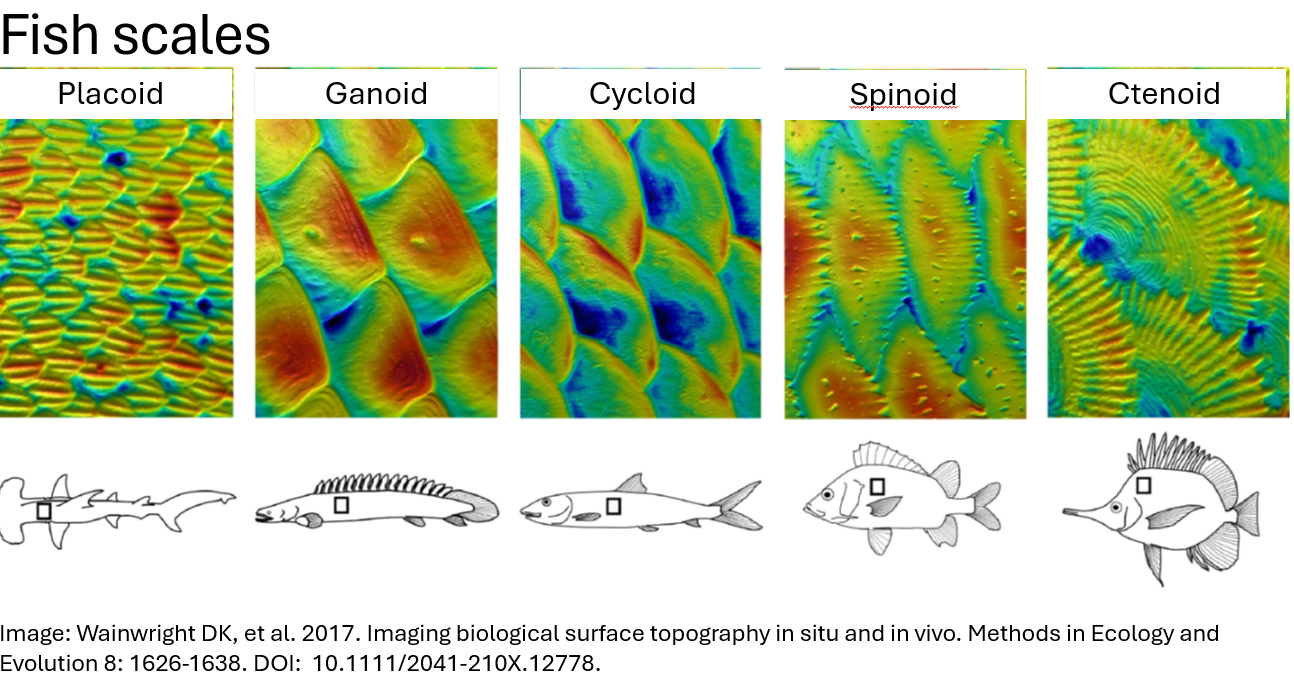
cycloid vs ctenoid scales
circles vs like fingerprint
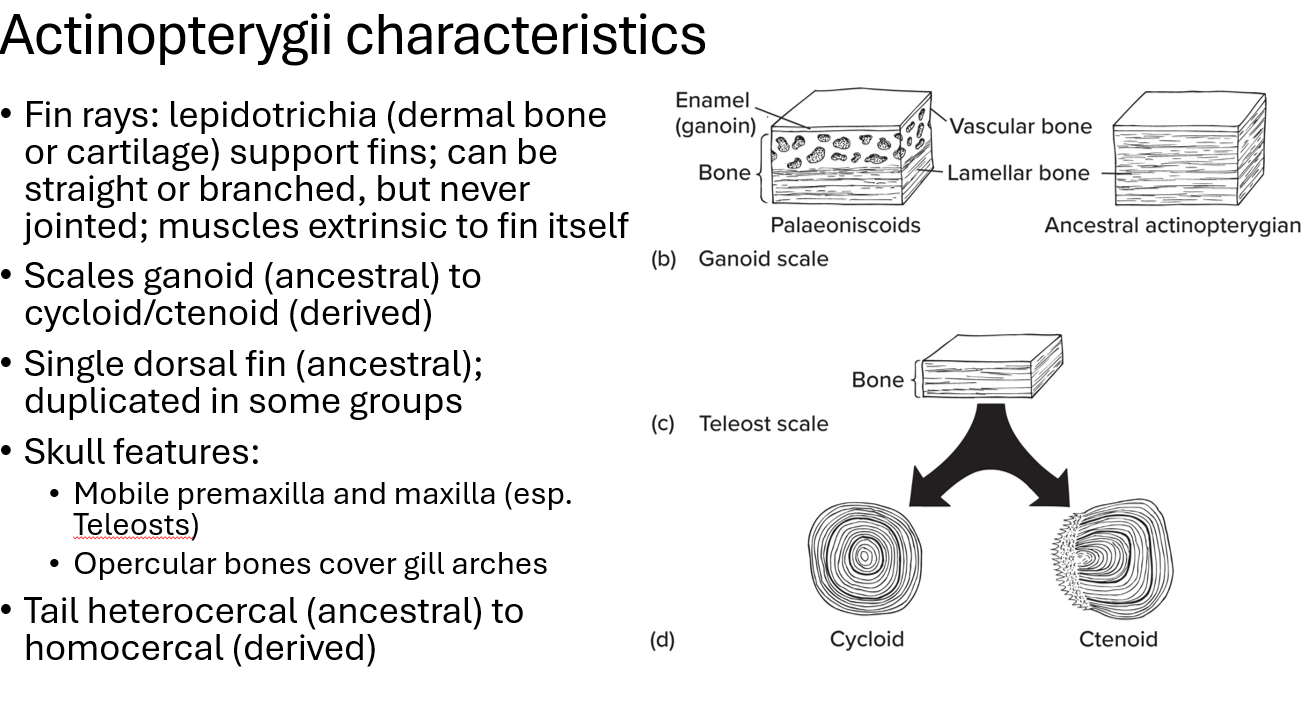
Major groups of Actinopterygians (CCAPHALT/CCHT)
•Cladistia: Polypteriformes: bichirs and reedfishes
•Chondrostei: Acipenseriformes=Acipenseridae: sturgeon/Polyodontidae: paddlefishes
•Holostei=Amiiformes: bowfins/Lepisosteiformes: gars
•Teleostei: >99% of extant Actinopterygians

Polypteriformes traits (14SGFS)
•≈14 species of bichirs and reedfishes, all in Africa
•Series of dorsal finlets/little fins instead of single dorsal fin
•Ganoid, rhomboid scales
•Fleshy pectoral fins
•Spiracles/little openings on head to breath air; 2 simple lungs
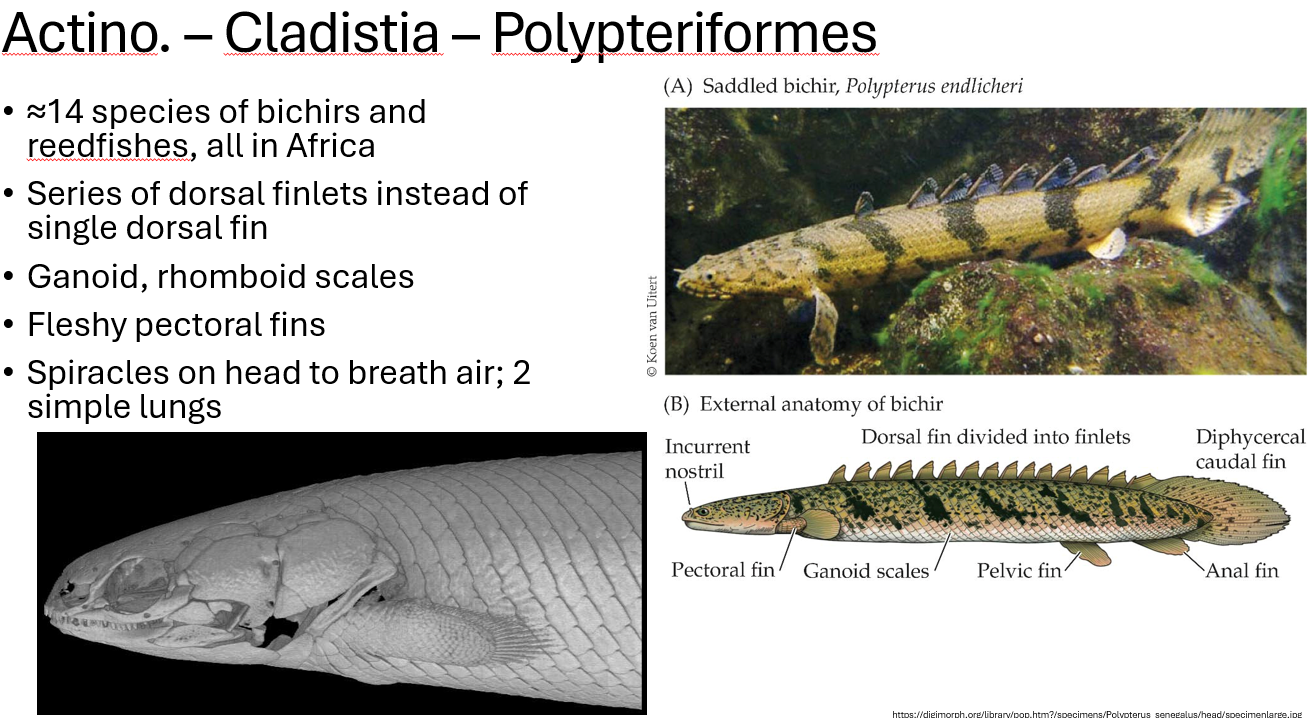
Acipenseriformes traits (SSNPCM)
•Sturgeons and paddlefishes
•Skeleton partially ossified; most of it secondarily cartilaginous
•Notochord not surrounded by vertebrae, retained throughout life
•Premaxilla and maxilla and teeth lost; adults edentulate (toothless)
•Can sense electric fields with gel-filled ampullae (electroreceptores) of Lorenzini. this is shared with sharks and probably ancestral in Gnathostomes but lost in Neopterygians
•Most extant species threatened, endangered, or critically endangered bc many are (over)harvested for roe to make caviar
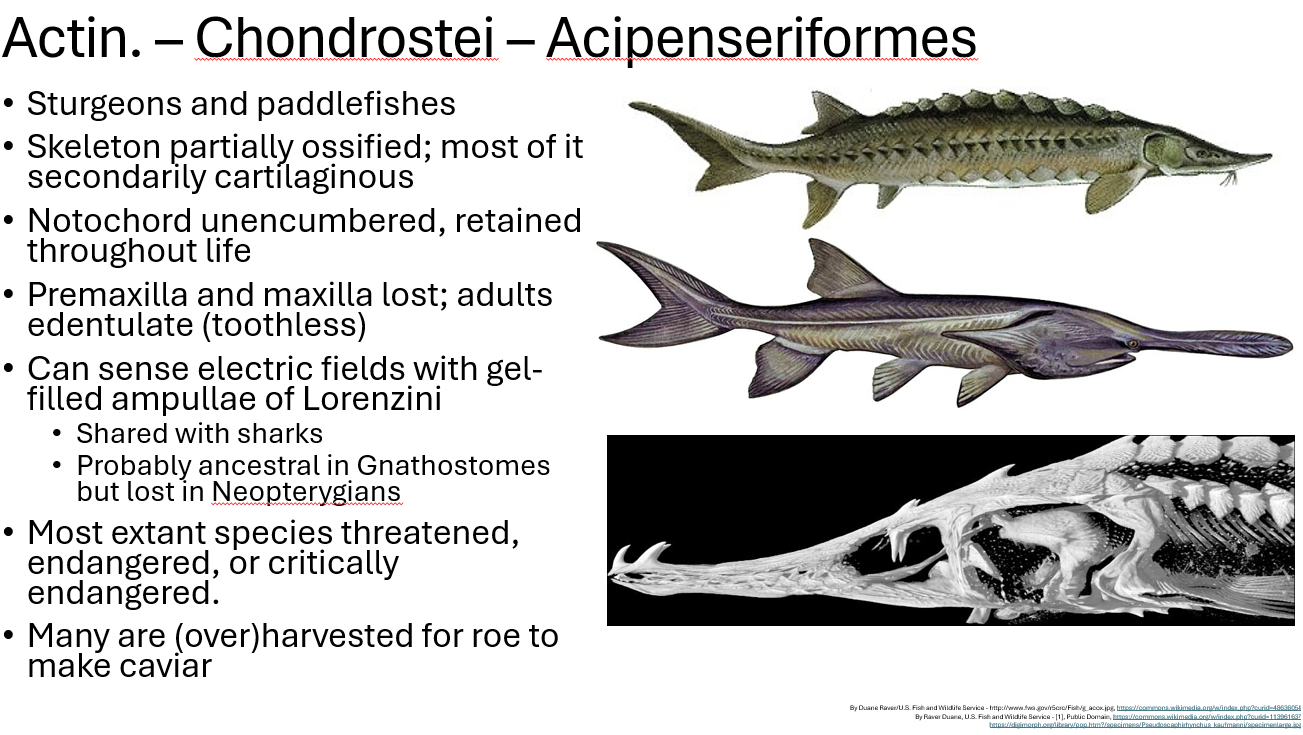
Acipenseridae traits (AHBSSV)
•27 species of sturgeons in 5 genera, most critically endangered (overharvest for roe; habitat loss)
•Appear in early Jurassic (among earliest known actinopterygians)
•Heterocercal tail
•Bony armor (scutes)
•Scaleless
•Secondarily cartilaginous (mostly)
•Very long-lived, slow reproducing

main endangered Acipenseridae
Pallid sturgeon (Scaphirhynchus albus) is critically endangered due to overfishing and habitat loss, and life history contributes to difficulty in recovery: ≥15 years to maturity; infrequent spawning (3-10 years)
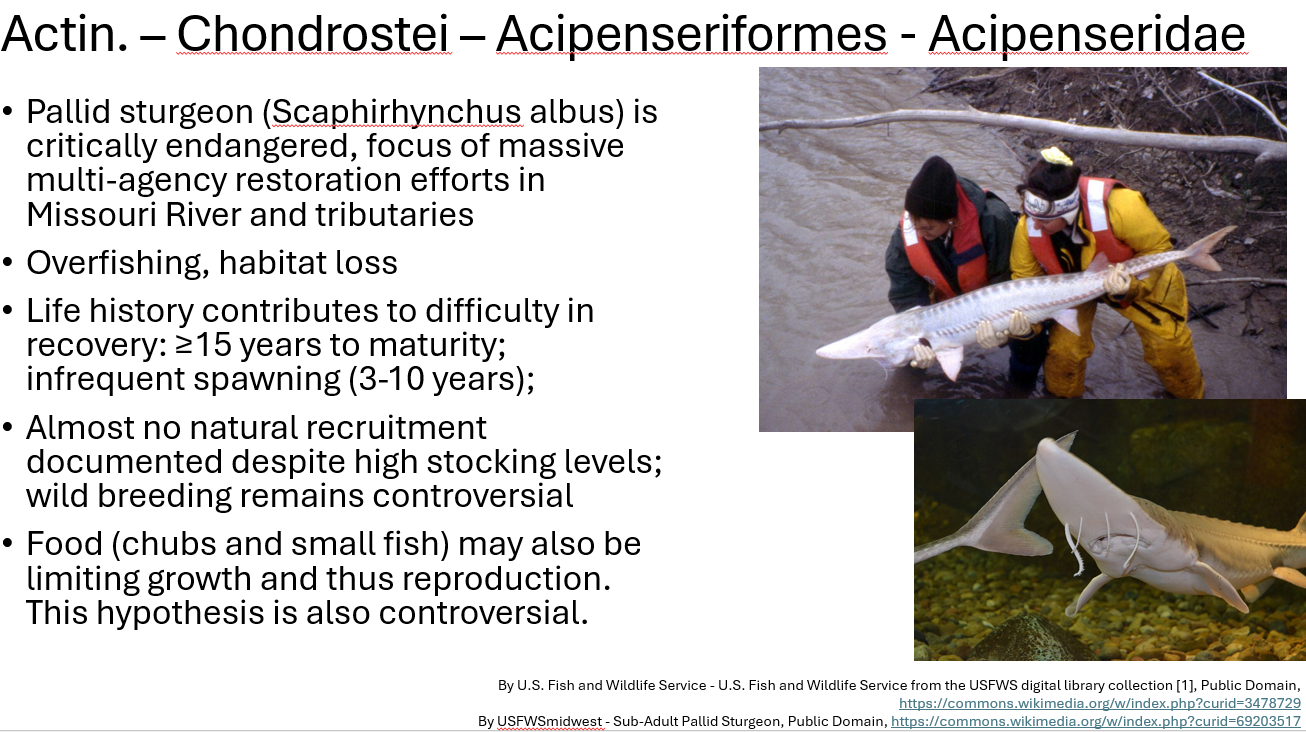
Polyodontidae traits (ES)
•1 (probably) species of extant paddlefish; second species declared extinct in 2022.
•Elongate, paddle-shaped snout used for finding prey using ampullae of Lorenzini
•Suspension feeders (similar to filter feeding)
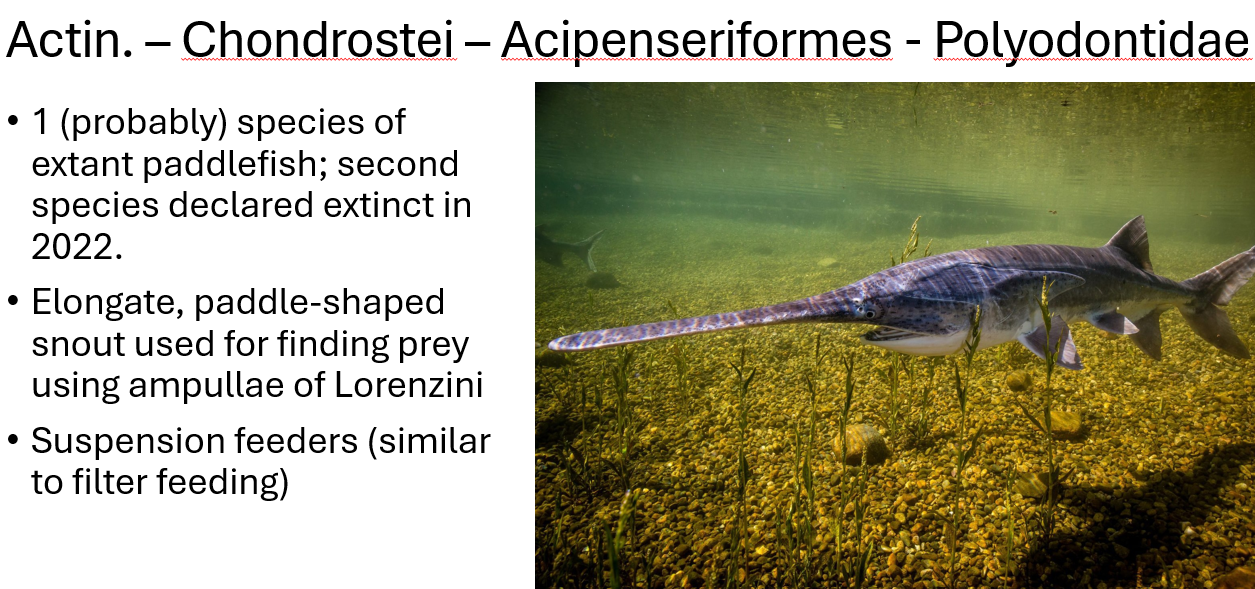
Holostei (STSSSIVF)
•Sister group to teleosts within Neopterygii
•Tail transitional between fully heterocercal tail of Chondrostei and homocercal tail of Teleostei
•Scales mixed: gars have ancestral ganoid scales; bowfins have cycloid-like scales (teleost-like)
•Skeleton mostly of fully ossified (unlike Chondrostei)
•Skull simplified compared to Chondrostei
•Intestinal spiral valve reduced; more similar to intestine of teleosts
•Vascularized swim bladder can help with respiration
•Fins more teleost-like; lepidotrichia form most fin support
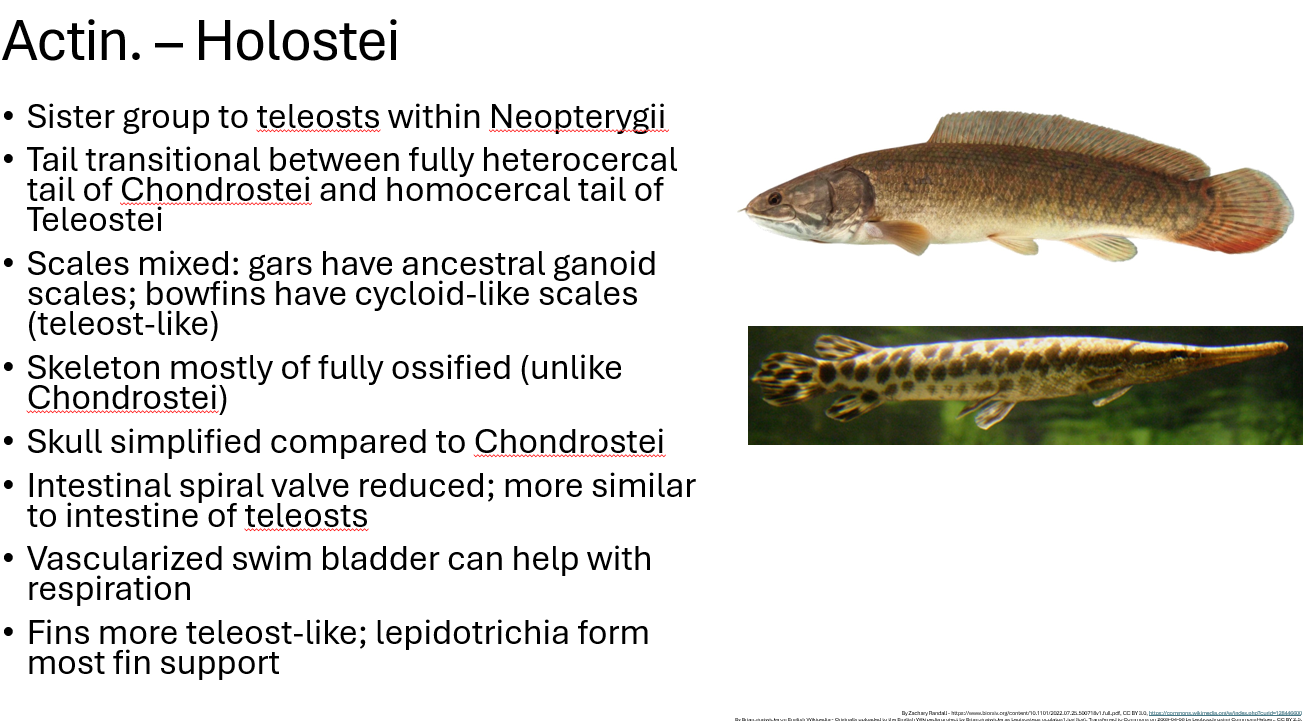
holostei pelvic fin being more back helps them
be more balanced/stable with movement
Amiiformes traits
•1 extant species: the bowfin Amia calva
•Single dorsal fin
•Swim bladder functions as a lung; bowfins gulp air in hypoxic waters
•Cycloid scales, lack ganoin (enamel); dermal bone only
•Caudal fin almost homocercal, but not quite (almost teleost-like)
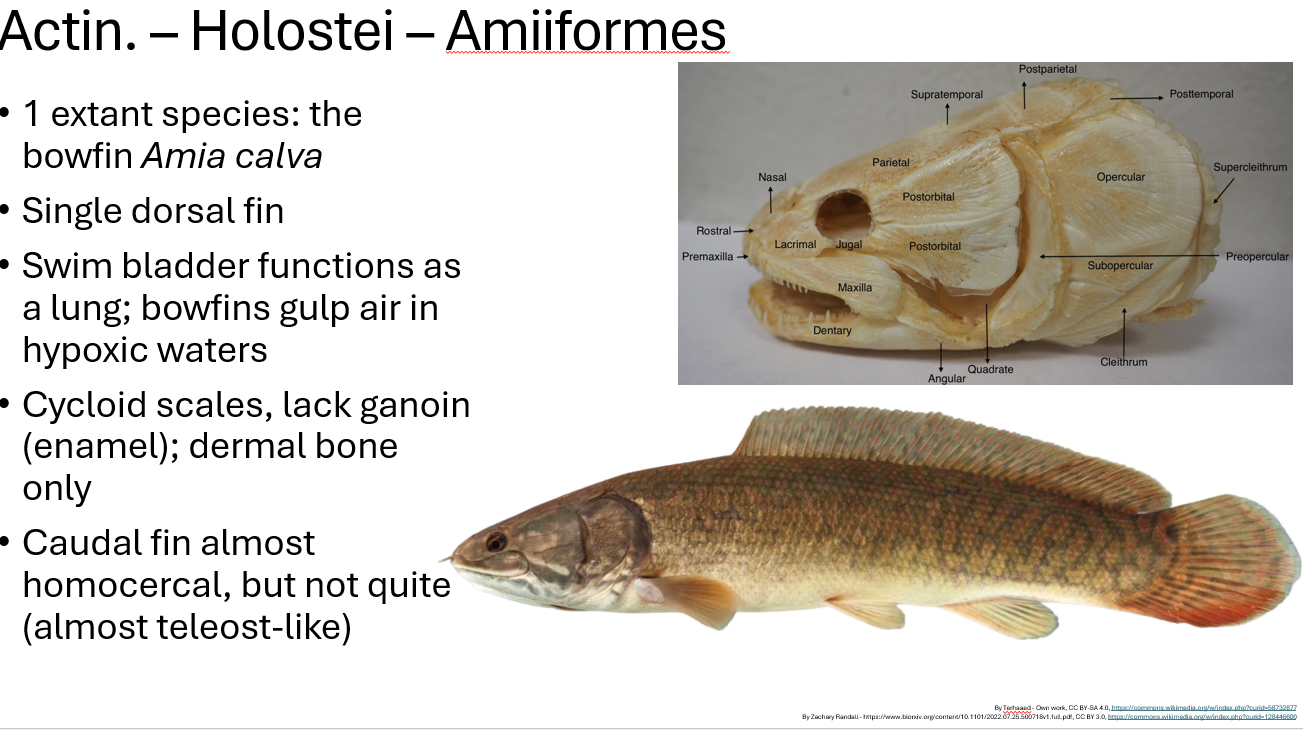
Lepisosteiformes traits (HLCM)
•7 extant species in 2 genera (Lepisosteus and Atractosteus)
•Heavy armor made of ganoid scales
•Long bodies and jaws→piscivorous predators (compare to gharials)
•Can breathe air with vascularized swim bladder
•Maxillae and premaxillae fused anteriorly
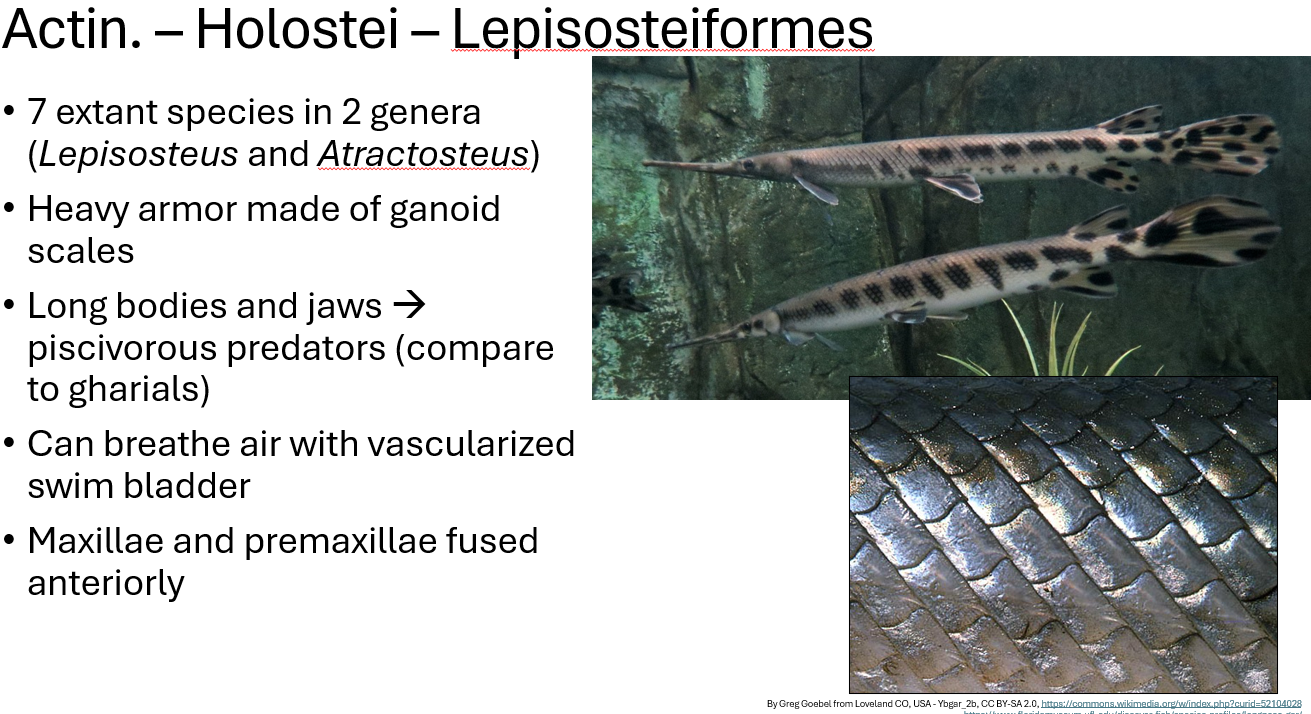
Teleosti traits (FHCS)
•Fossils appear in early Triassic, but likely diverged from Holostei in Carboniferous (310 Mya)
•Highly mobile premaxilla; enables jaw protrusion and often suction feeding
•Caudal tails homocercal (symmetrical)
•Scales consist of lamellar dermal bone only; cycloid or ctenoid
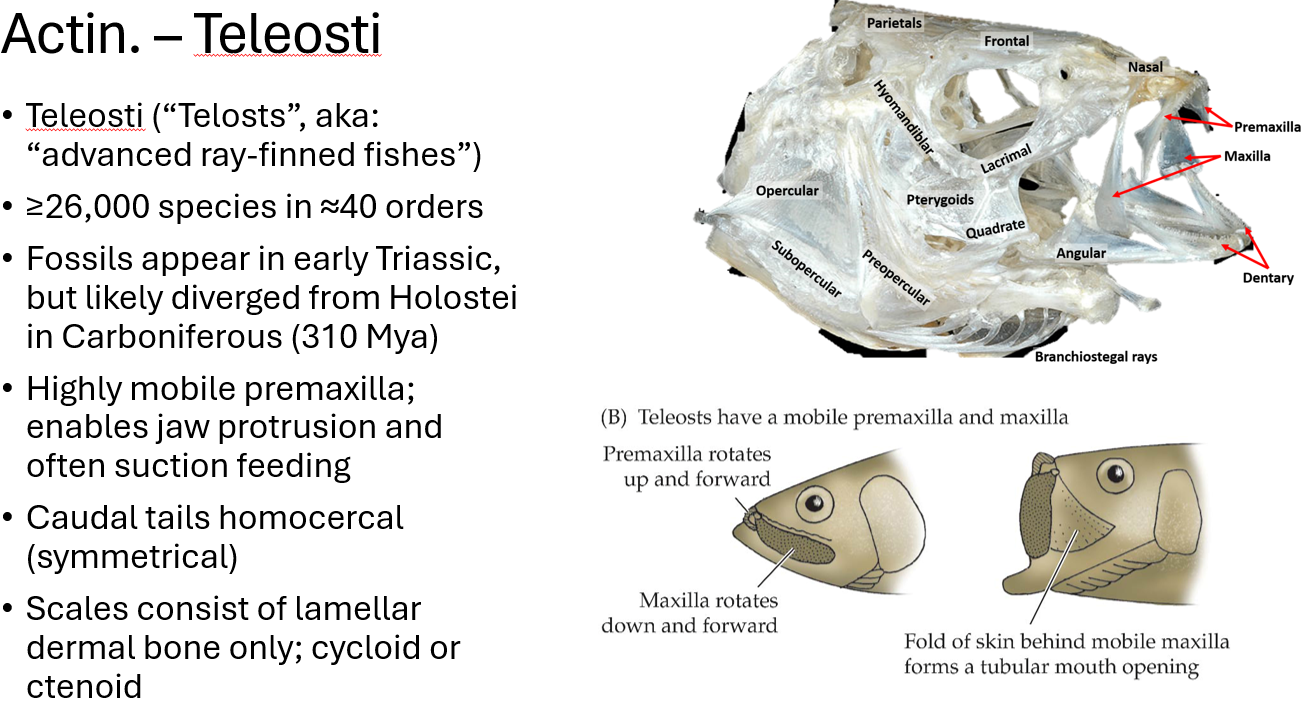
•“Telosts”, aka: “advanced ray-finned fishes”
•≥26,000 species in ≈40 orders
teleosti

the dermis of fish are wavy instead of random like tetrapods to
keep their skin smooth and non wrinkled to prevent water resistance
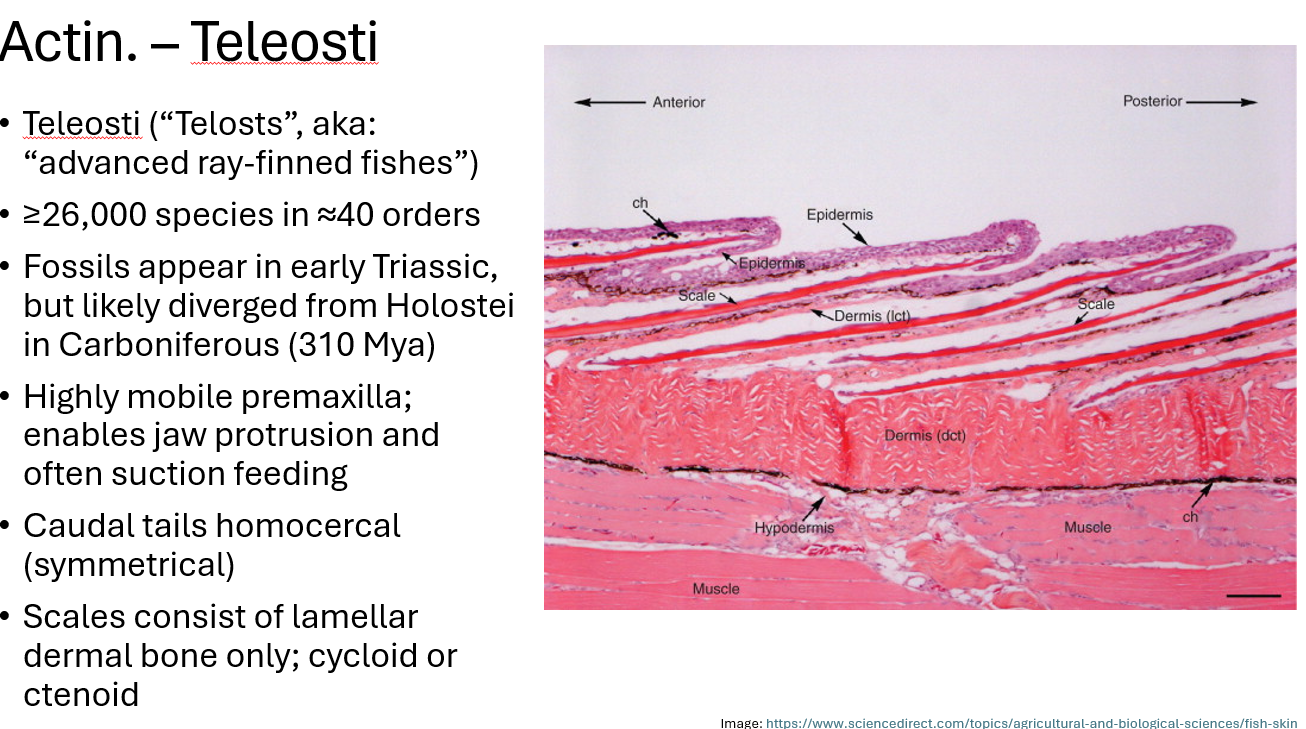
ctenii means
comb
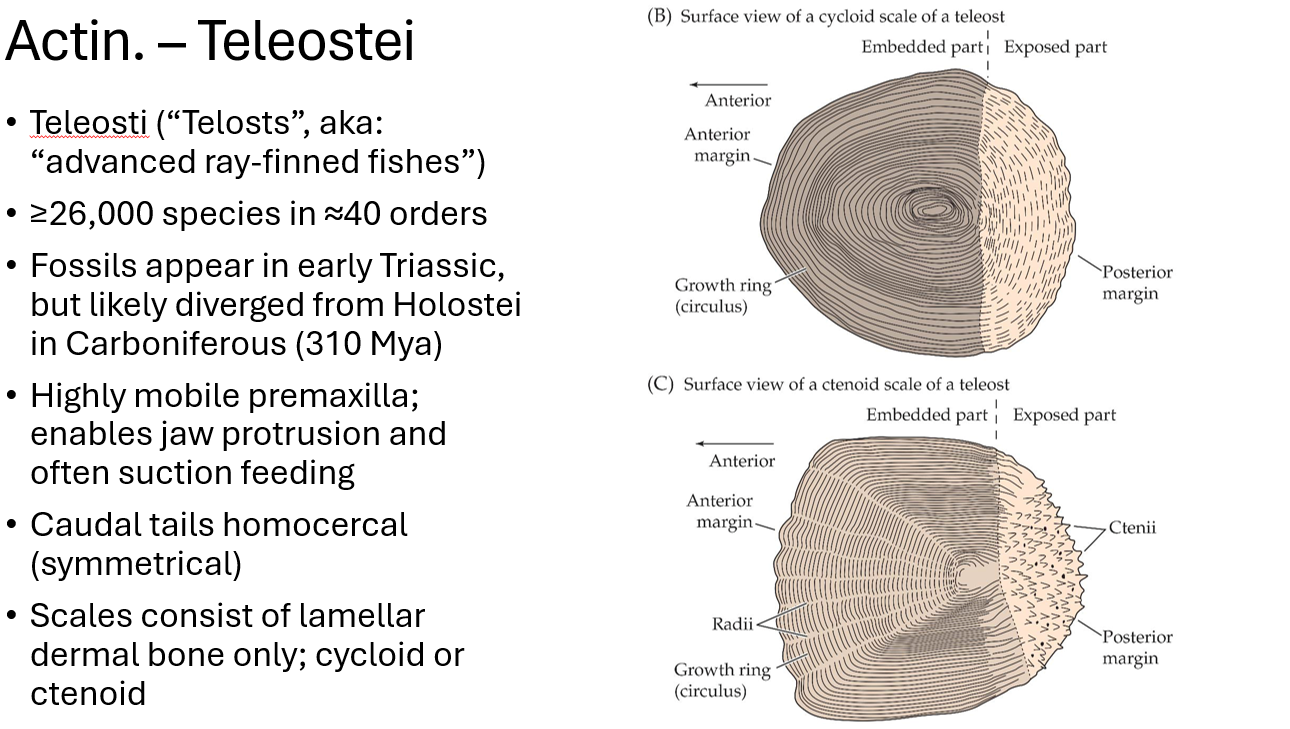
teleosti orders (FMMBE)
Freshwater diversity and dominance
•Cypriniformes
•Siluriformes
•Centrarchiformes
•Perciformes
Migratory and coldwater fishes
•Salmoniformes
•Esociformes
Marine pelagic predators
•Gadiformes
•Scombriformes
Benthic and deep-sea specialists
•Lophiifomes
•Pleuronectiformes
Evolutionary experiments in body plan and behavior
•Anguilliformes: major rearrangement of body plan
•Cichliformes: small-scale, rapid radiation
•Perciformes again: large-scale, ancient, global radiation
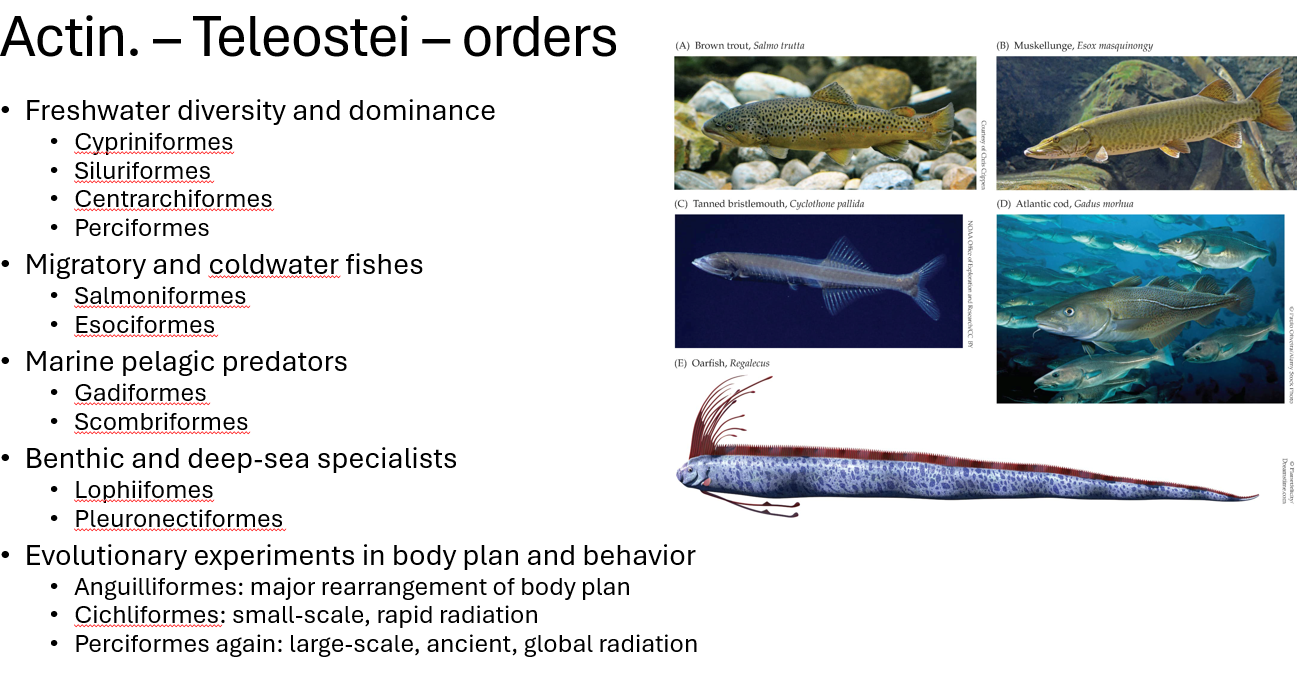
what type of water ecosystem is best for evolving fish diversity
Freshwater habitats host an outsized share of teleost diversity. There is extreme range of feeding and sensory adaptations — suction feeders, bottom browsers, visual and tactile specialists.
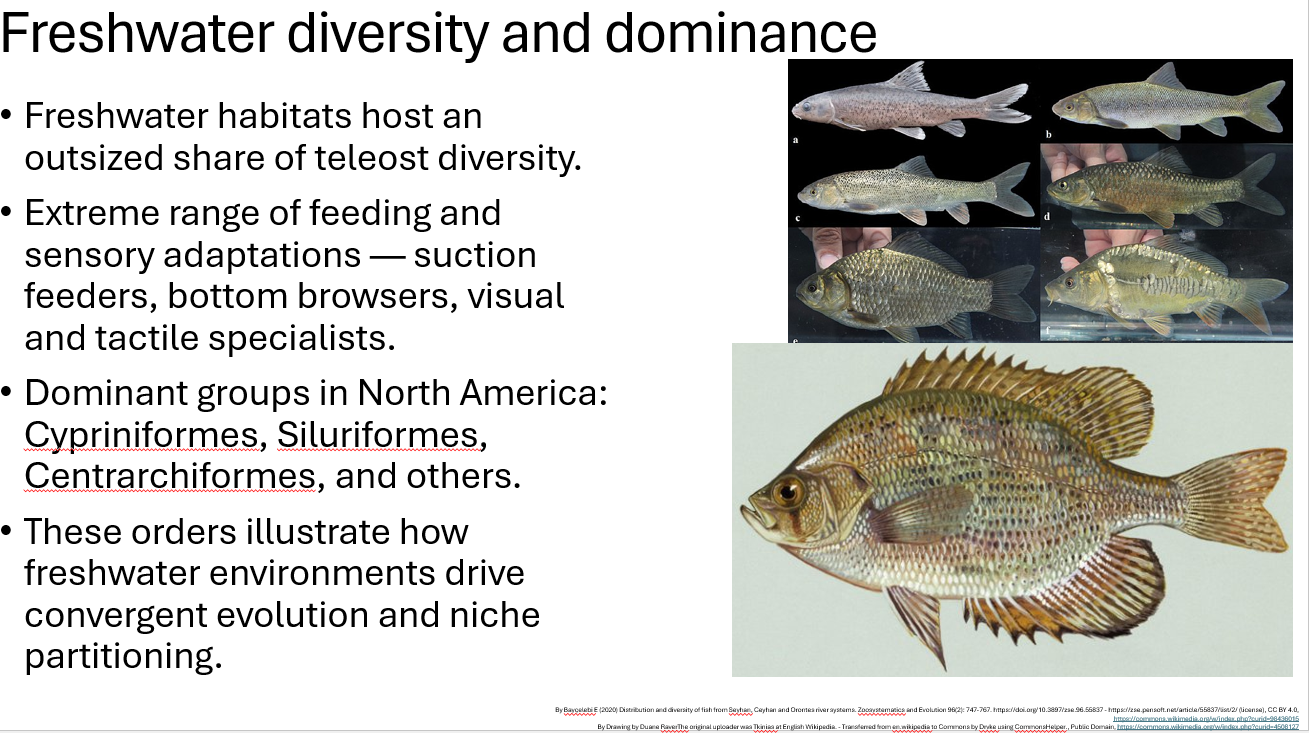

Cypriniformes traits (FLWP)
•~4,300 species of carps and minnows
•Defining traits
•Freshwater; no jaw teeth (have pharyngeal teeth)
•Lack a true stomach
•Weberian apparatus links swim bladder to inner ear
•Protractile mouth, soft-rayed fins
•Why important
•Dominant freshwater order in North America
•Asian carp (Cyprinus spp.) invasive in North America – massive impact on river ecosystems
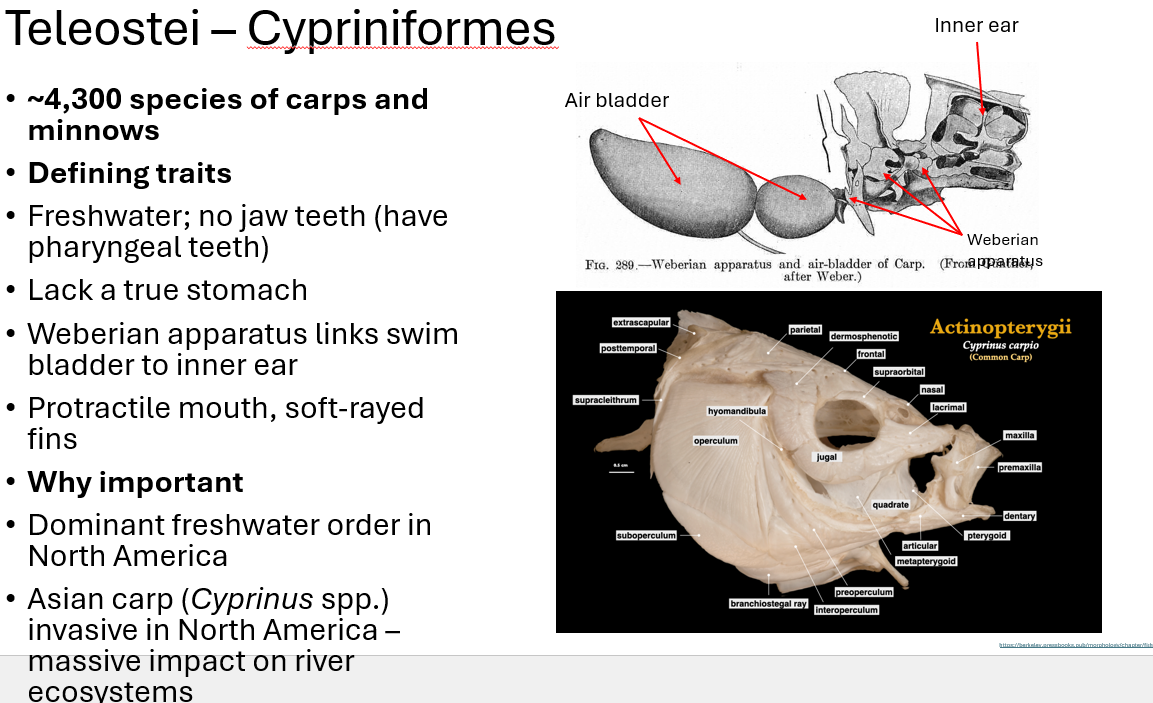
weberian aparatus and protractile mouth function of Cypriniformes
connects air bladder to inner ear allowing air bladder to be large ear vs protractile mouth can be extended or thrust forward from the face, allowing the animal to enlarge its mouth cavity to create a vacuum for sucking in prey or food particles
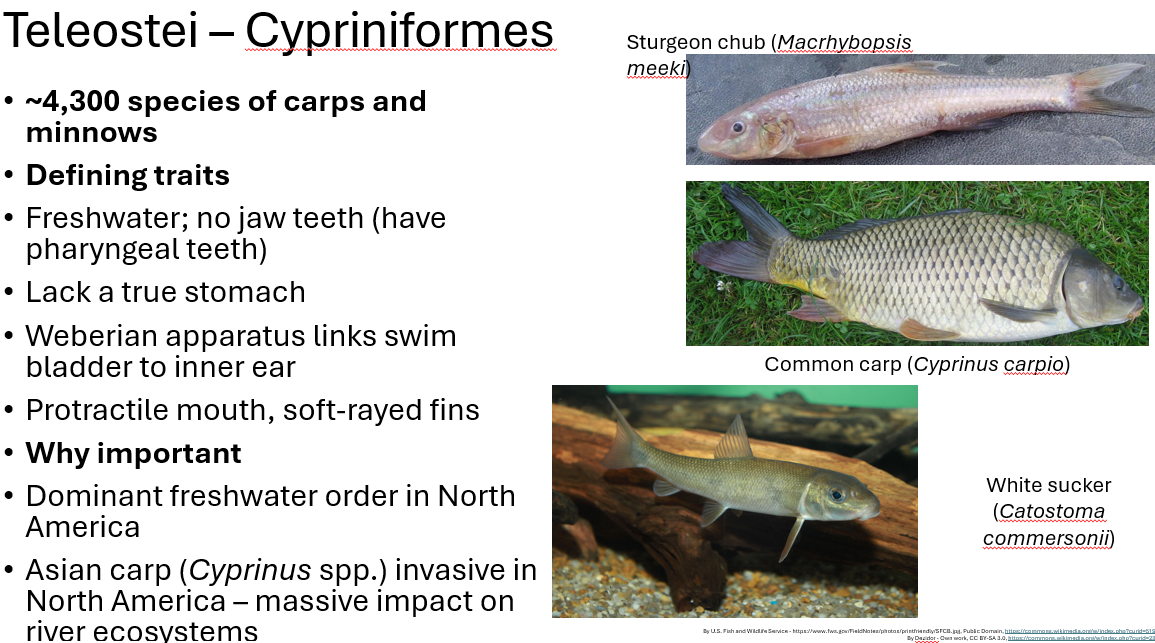
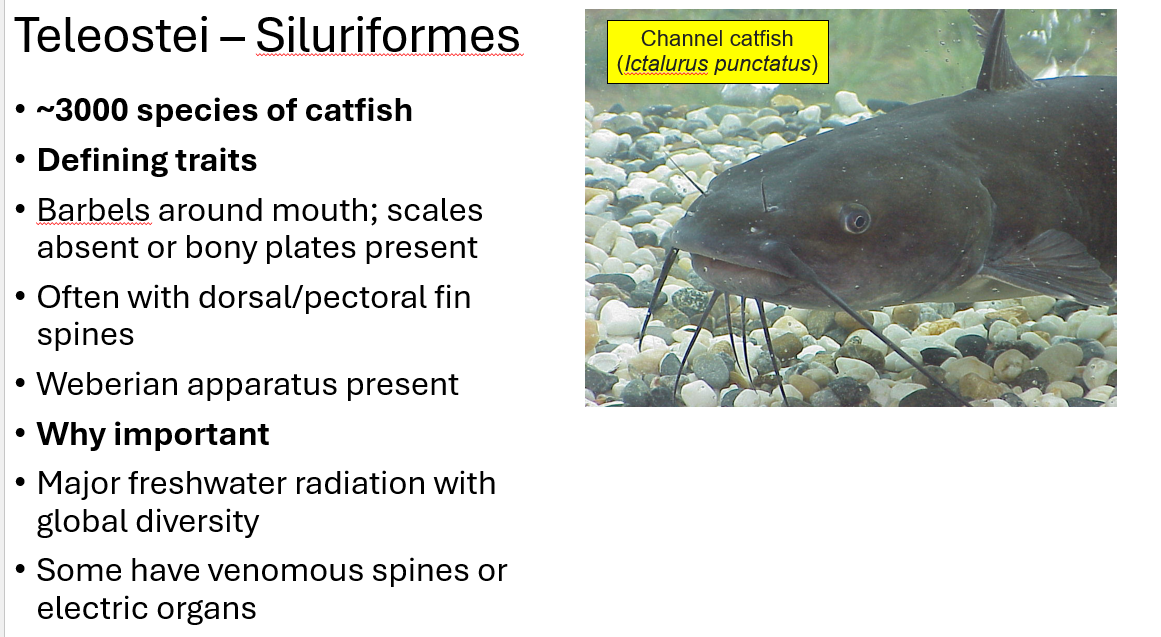
Siluriformes traits (BOWMS)
•~3000 species of catfish
•Defining traits
•Barbels around mouth; scales absent or bony plates present
•Often with dorsal/pectoral fin spines
•Weberian apparatus present
•Why important
•Major freshwater radiation with global diversity
•Some have venomous spines or electric organs
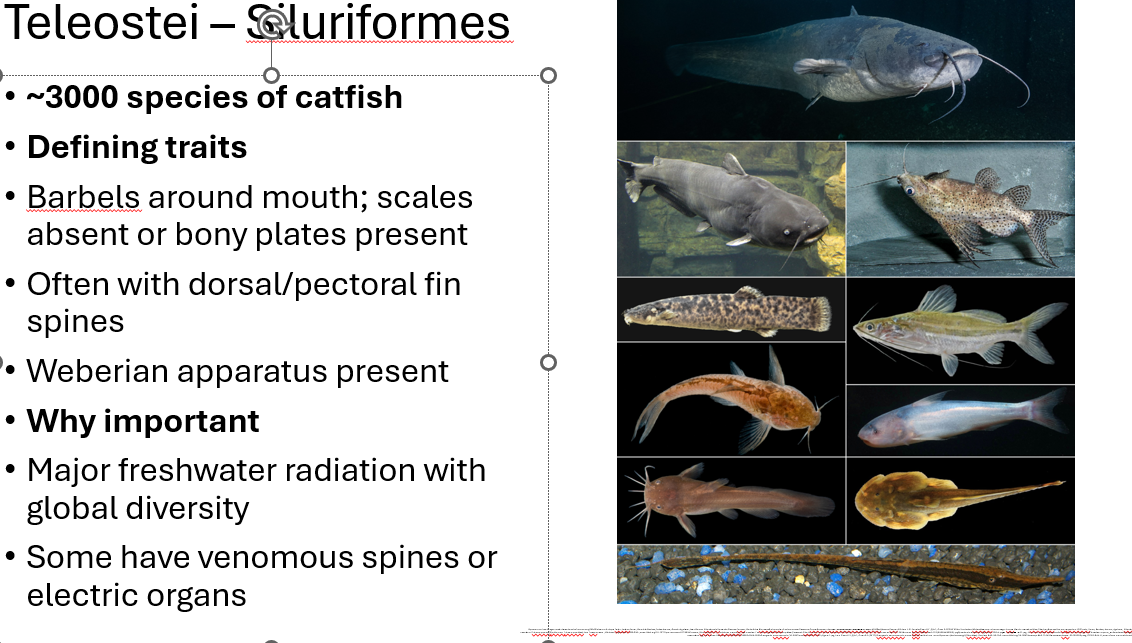
most common siluriformes
channel catfish
largest group of teleosti
perciformes
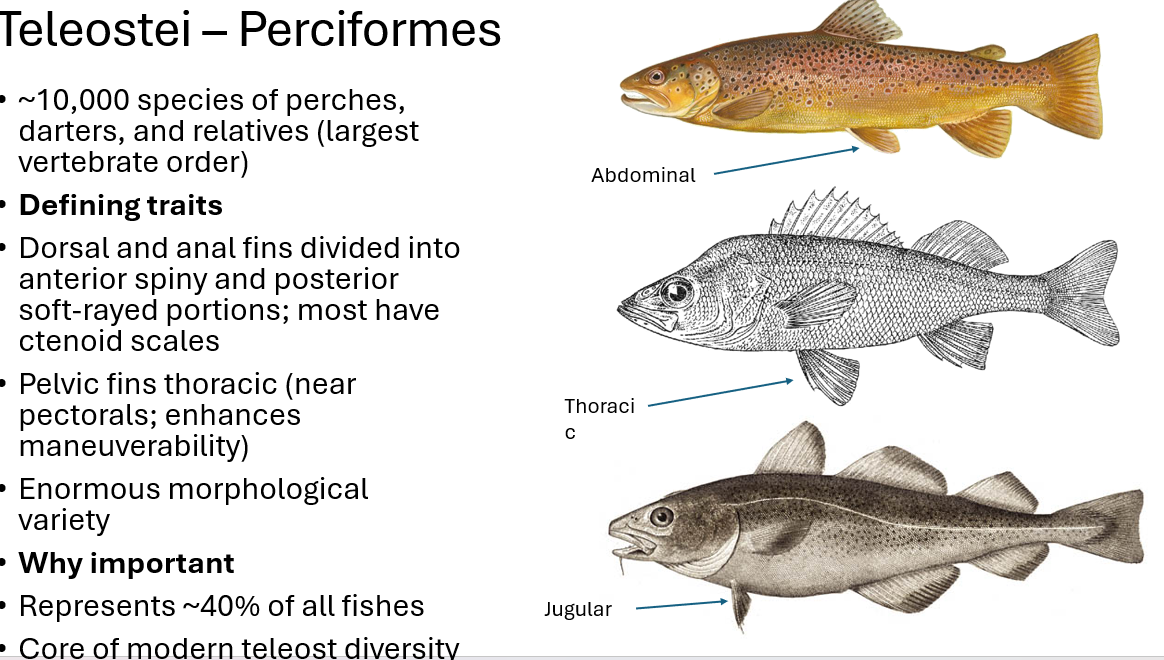
perciformes traits (DPE)
•~10,000 species of perches, darters, and relatives (largest vertebrate order)
•Defining traits
•Dorsal and anal fins divided into anterior spiny and posterior soft-rayed portions; most have ctenoid scales
•Pelvic fins thoracic (near pectorals; enhances maneuverability)
•Enormous morphological variety
•Why important
•Represents ~40% of all fishes
•Core of modern teleost diversity

what does this figrue show
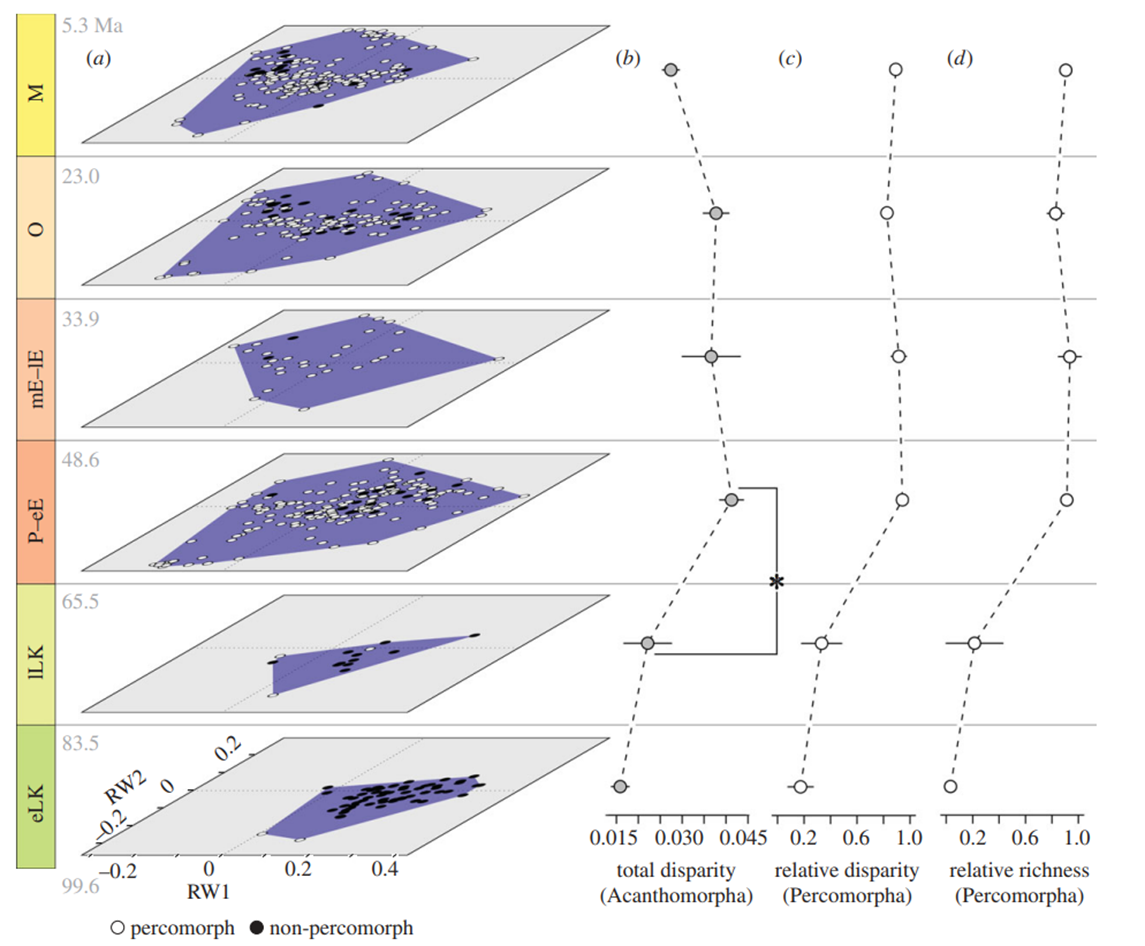
perciformes have radiated more than other groups throughout time
centrachidae traits (FCN)
•~40 species of sunfishes and basses
•Defining traits
•Freshwater, deep-bodied, laterally compressed
•Continuous spiny + soft dorsal fin
•Native to North America
•Why important
•Iconic sportfishes (bass, bluegill, crappie)
•Distinct North American evolutionary radiation
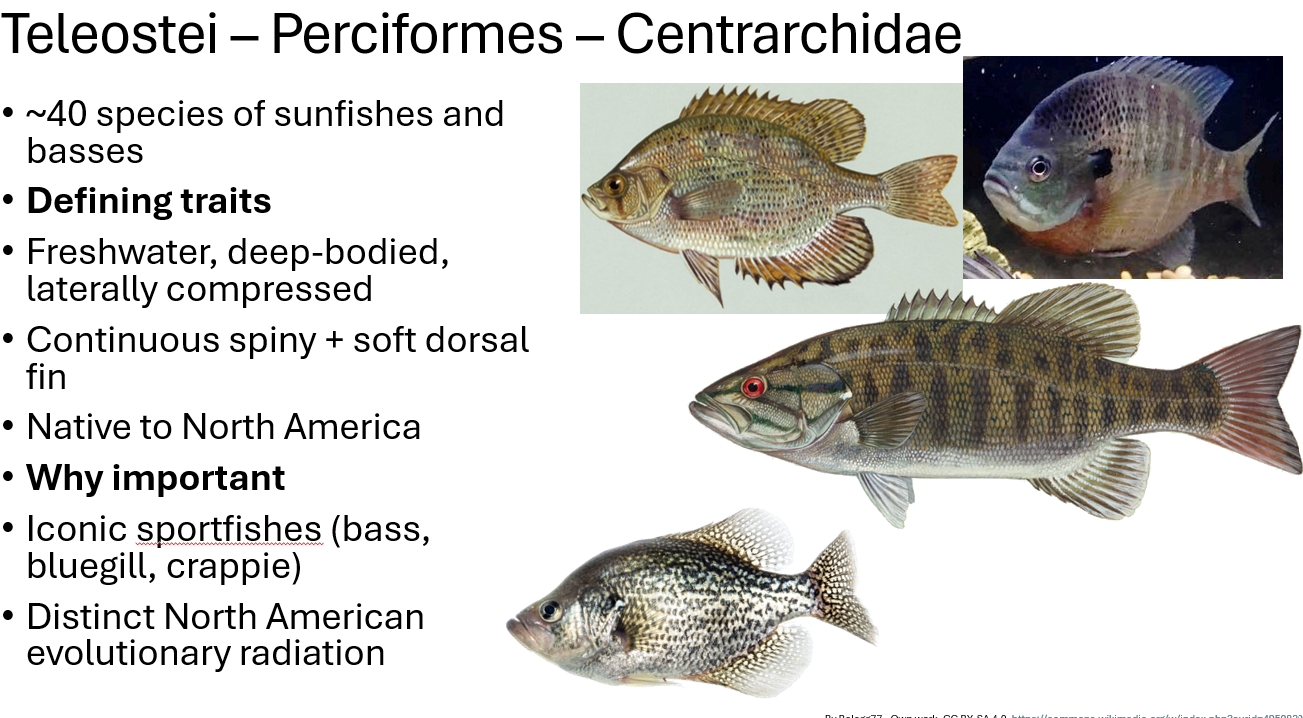
unlike the ancestral condition where fins are separated, centrachidae fins are
their fins have joined back together
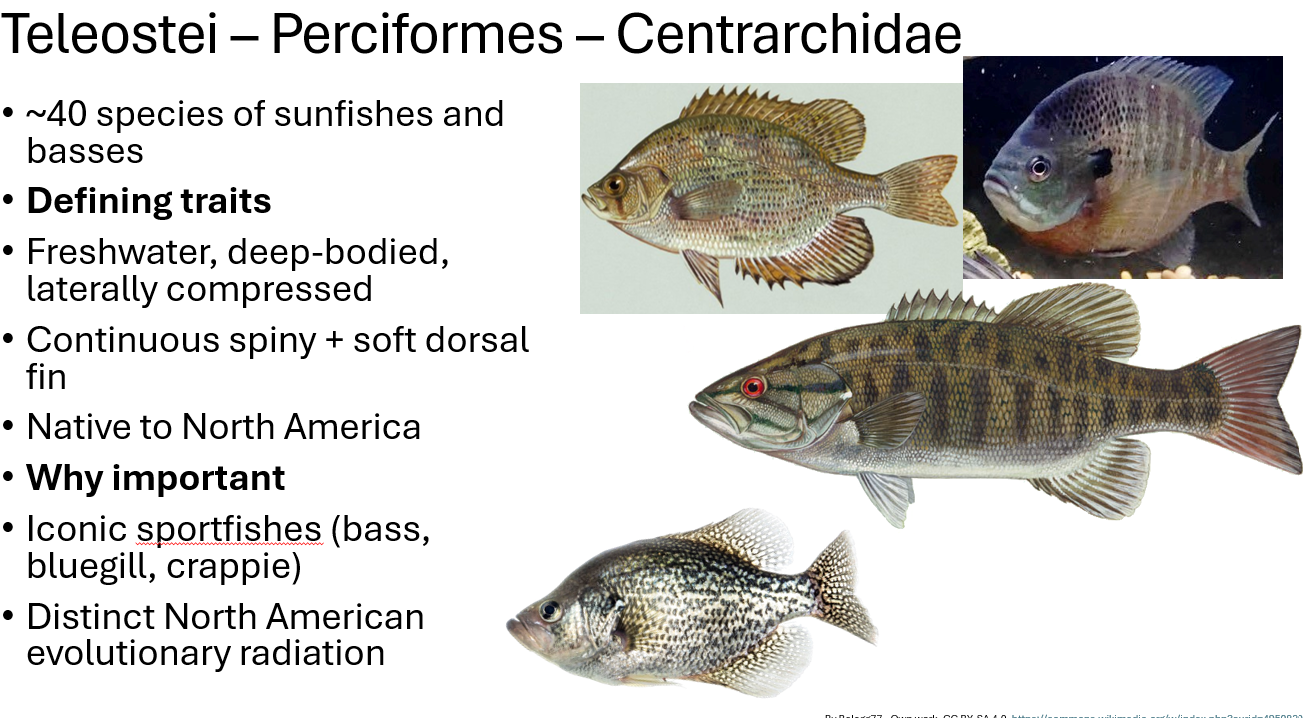
what does this figure show
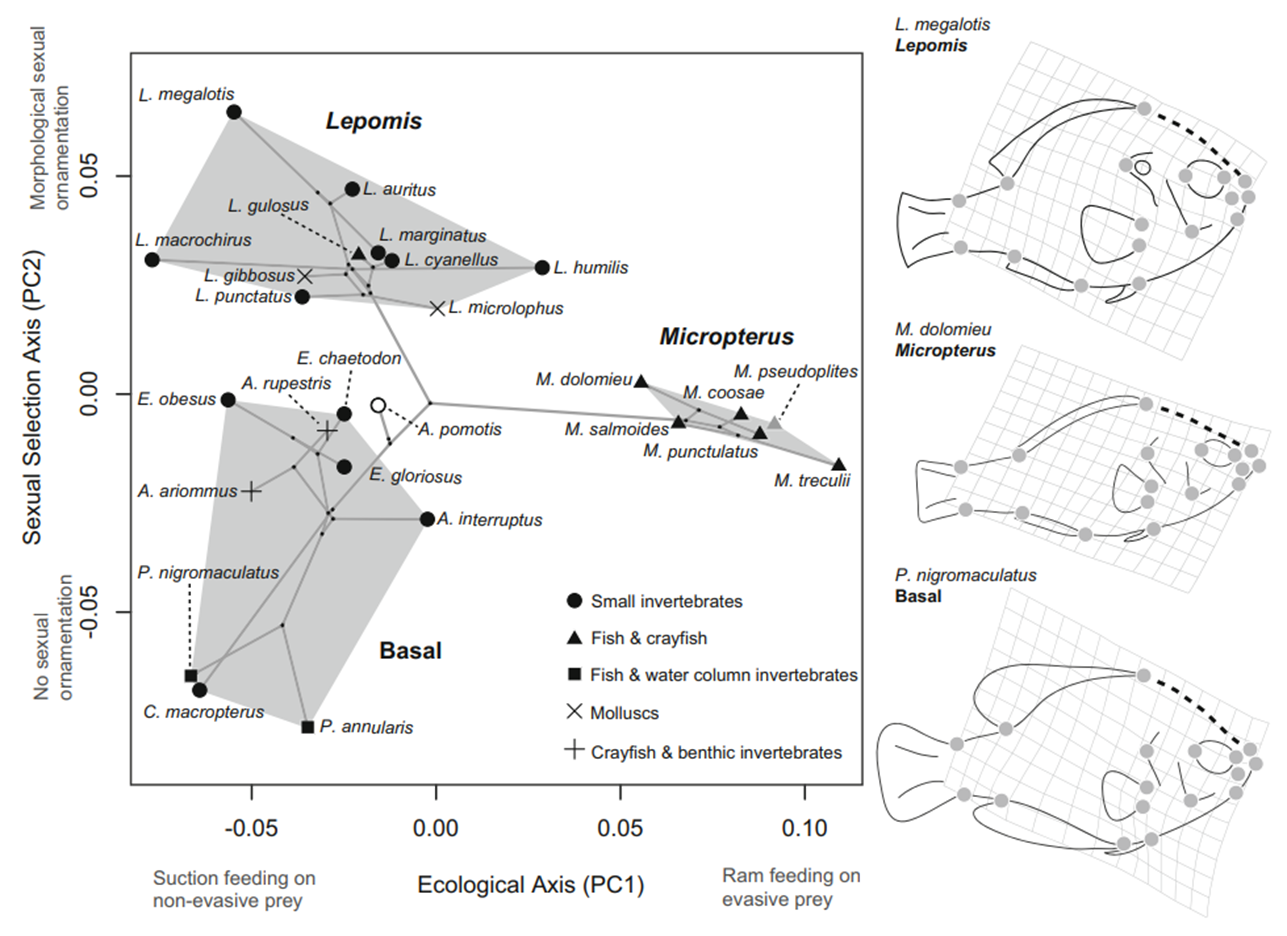
Smith et al. (2015) investigated body shape evolution in Centrarchidae/its ecological drivers and found divergence in body shape corresponded with divergence in feeding strategy (see PC1). The x axis increases from suction feeding to ram feeding
what are some differences between lepomis vs micropterus

micropterus ram feed more as seen with the increase along the x axis, lepomis have more morphological sexual ornamentation along the y axis, and lepomis eat more small invertebrates while micropterus eats more fish and crayfish according to the key
freshwater vs saltwater fishes
salt concentration larger inside their body vs outside (hyperosmotic vs hypoosmotic)
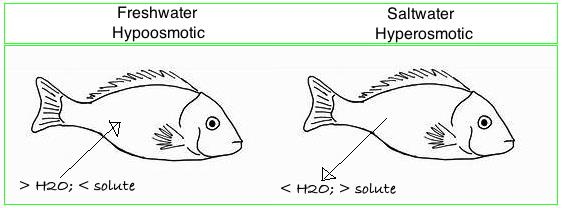
euryhaline means
both salt and freshwater
anandronous
when fish migrate between freshwater and saltwater
Migratory and coldwater fishes traits (LI)
•Life cycles spanning freshwater and marine realms — remarkable physiological flexibility.
•Include Salmoniformes, Esociformes, and sometimes Anguilliformes.
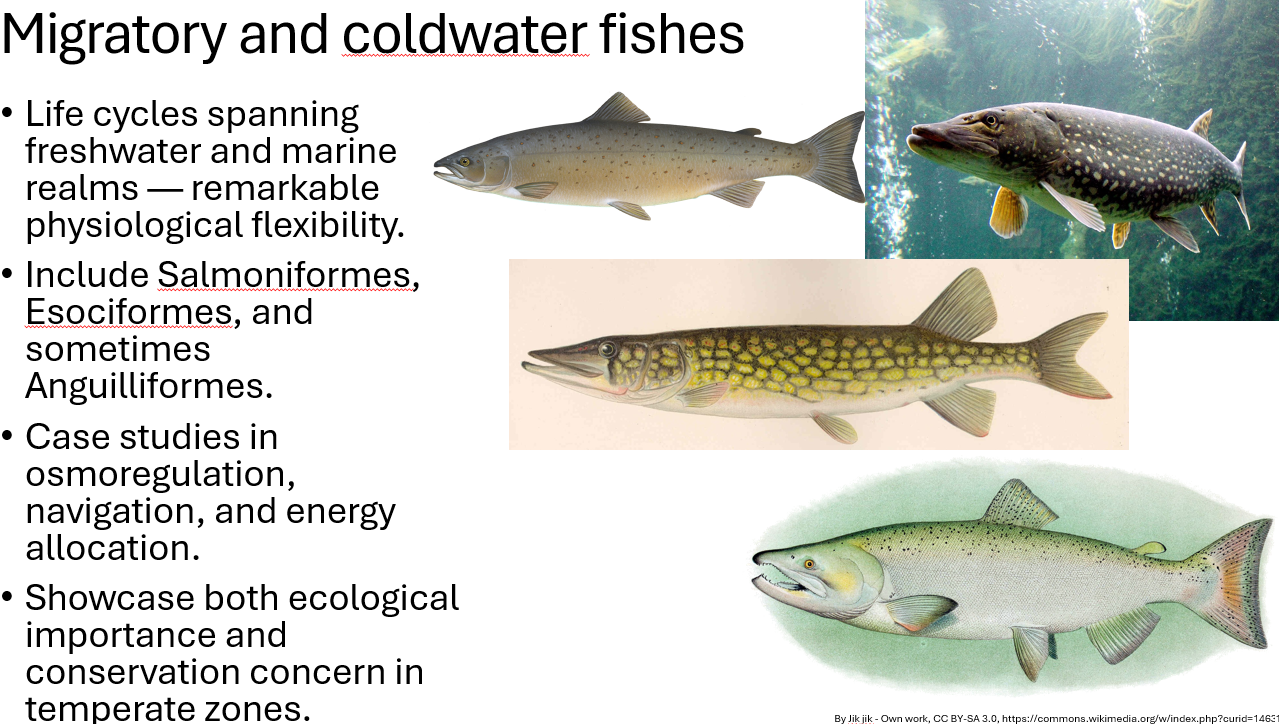
Esociformes traits (ENP)
•~10 species of pikes
•Defining traits
•Elongate body; dorsal and anal fins far back
•No adipose fin; freshwater only
•Physostomous swim bladder
•Why important
•North American endemics; top freshwater predators
•Sister clade to Salmoniformes

having pectoral fins up front and pelvic fins in the back vs pelvic fins up front adaptation
speed vs maneuverability
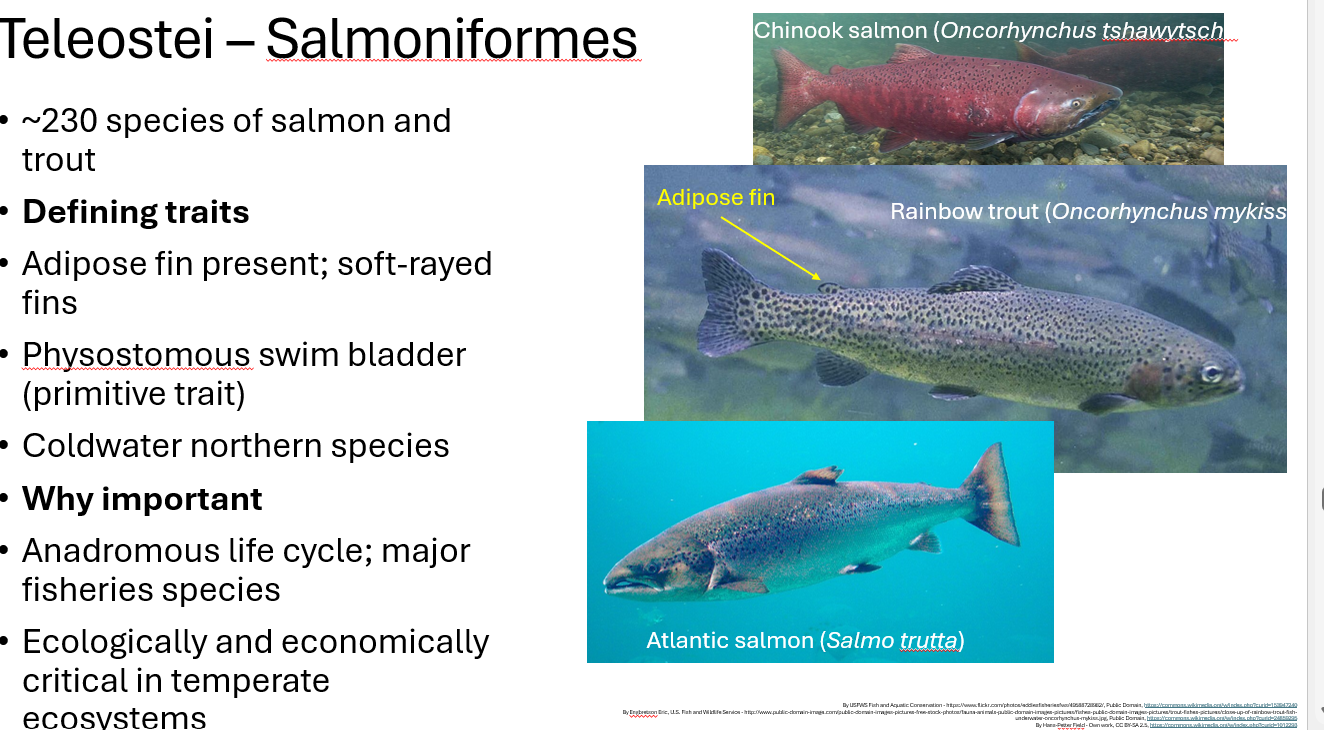
Salmoniformes traits (APCA)
•~230 species of salmon and trout
•Defining traits
•Adipose/rayless fin present; soft-rayed fins
•Physostomous swim bladder (primitive trait)
•Coldwater northern species
•Why important
•Anadromous life cycle; major fisheries species
•Ecologically and economically critical in temperate ecosystems
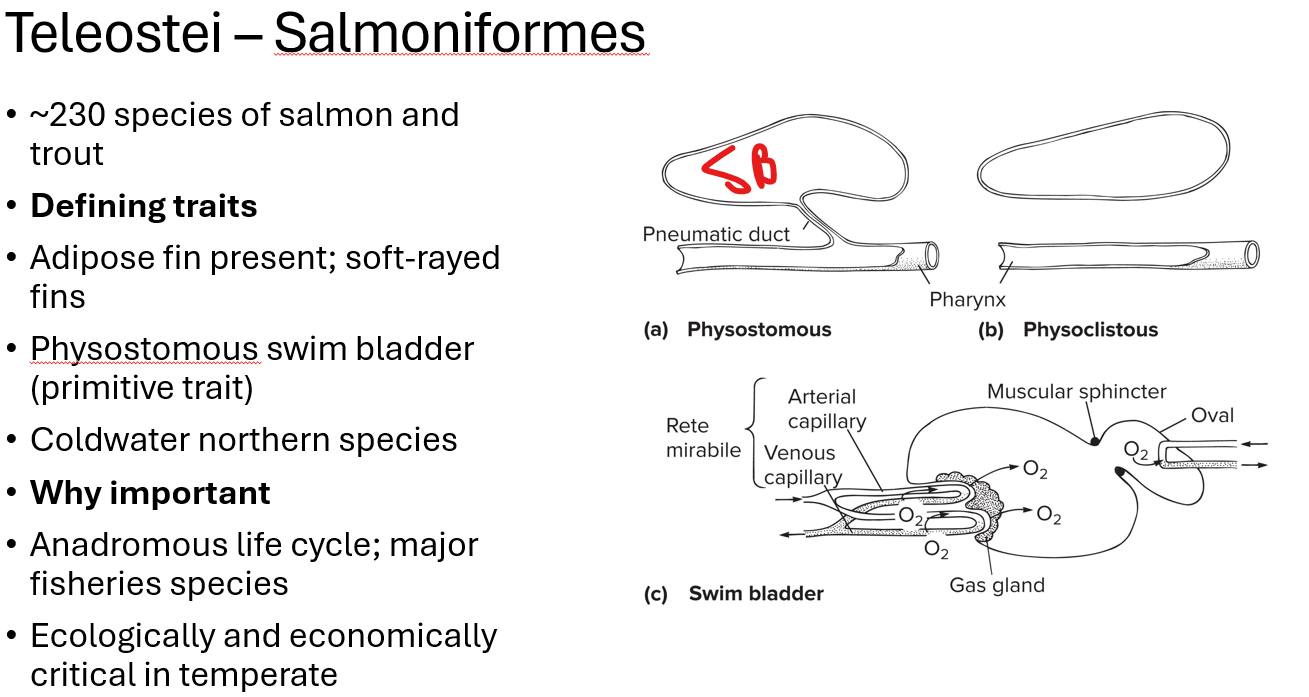
purpose of adipose fin in Salmoniformes
makes swimming more efficient
anadromous life cycle
type of fish migration where anadromous species are born in freshwater, travel to the ocean to grow and mature, and then return to freshwater to spawn
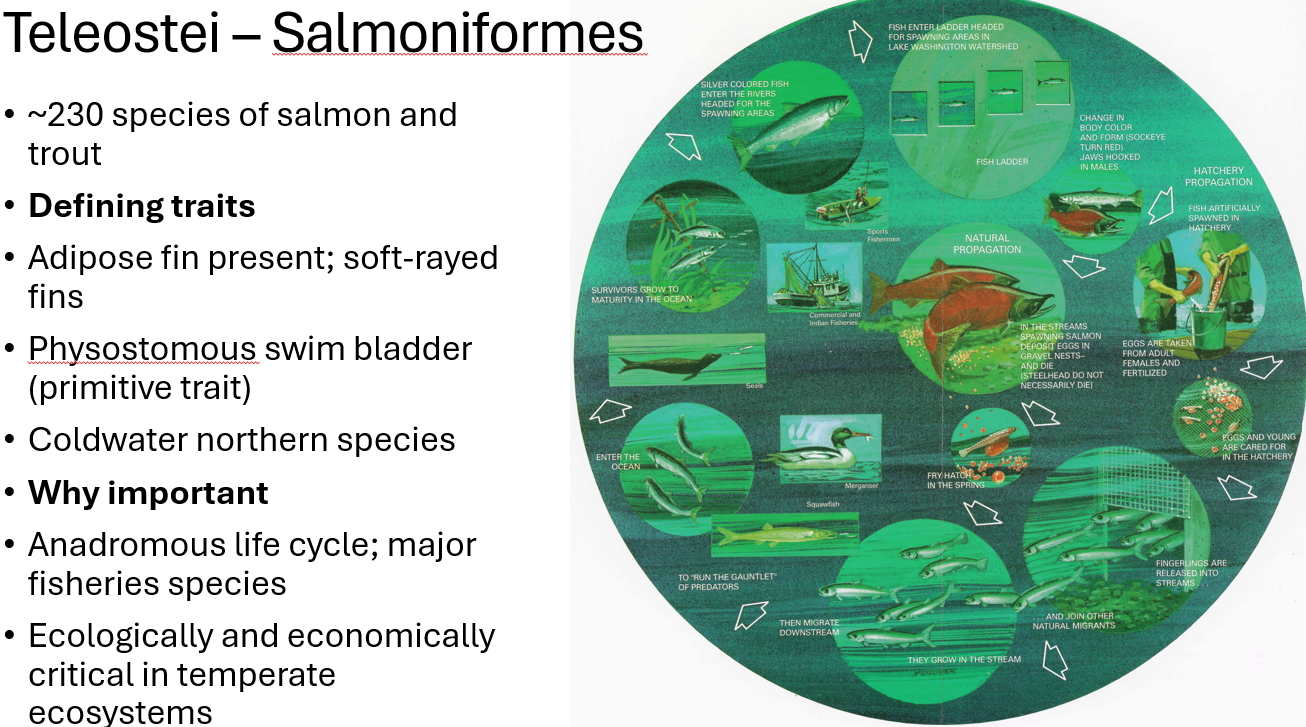
marine pelagic predators (SHSDG)
•Streamlined bodies,
•high metabolic rates
•specialized muscles for endurance and burst swimming.
•Dominant open-ocean hunters: Scombriformes (tunas, mackerels) and Gadiformes (cods).
•Global importance in commercial fisheries and marine ecosystems.
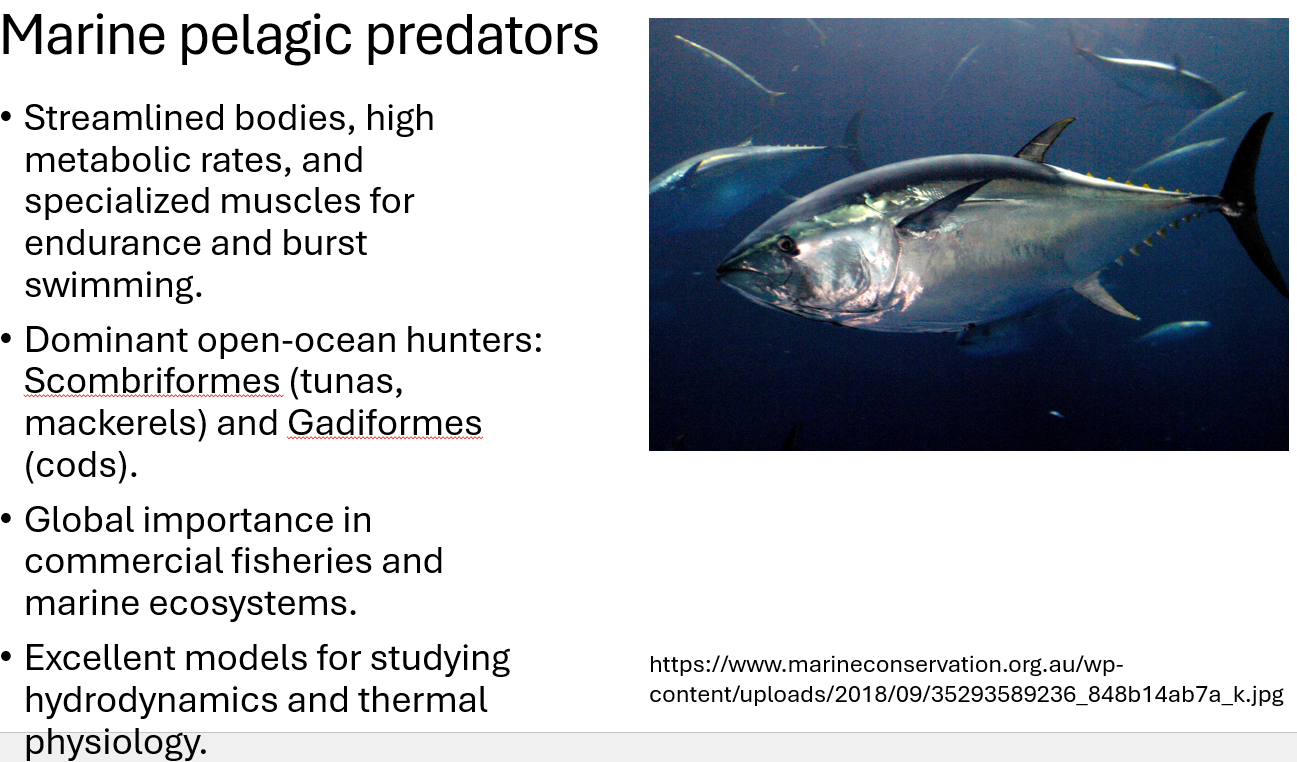
Scombriformes traits
• Streamlined body; finlets behind dorsal/anal fins
• High aspect ratio (width to depth of tail fin); fast- swimming morphology
• Some species regionally endothermic
• Peak adaptations for sustained high-speed swimming
• Tunas are among few endothermic fishes
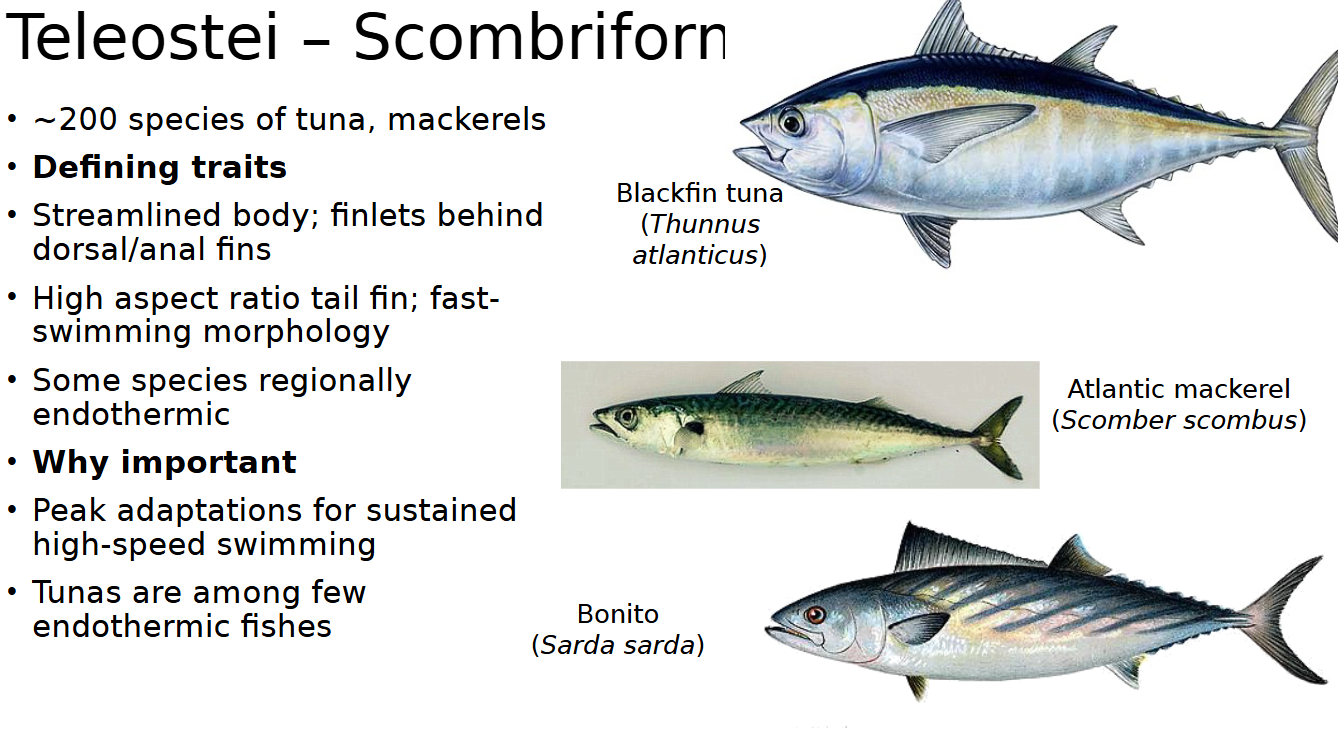
Gadiformes traits
~500 species of cod, haddocks, pollocks, burbot
• Marine (except burbot), often coldwater;
•3 dorsal + 2 anal fins
• Pelvic fins anterior under head
• Chin barbel often present
• Why important
• Enormously important commercial fishes
• Historical example of overfishing and population collapse
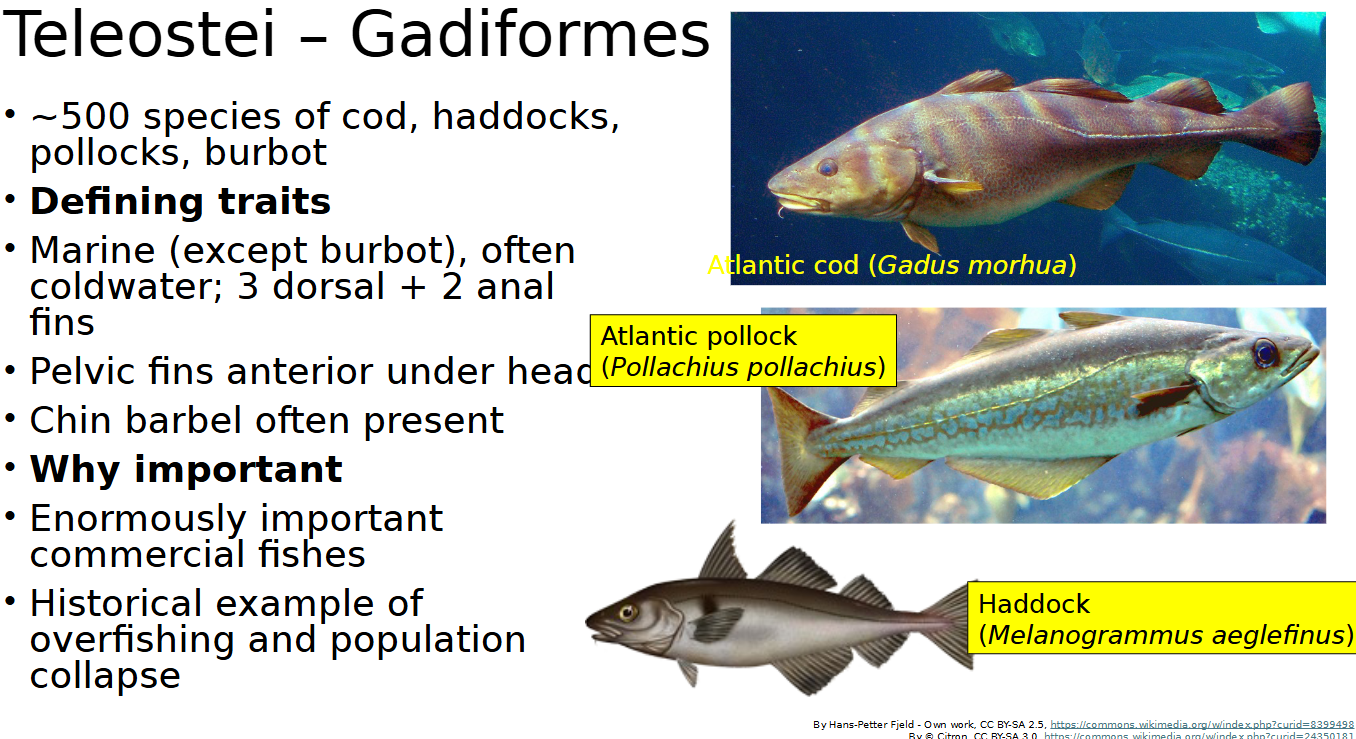
Cod overfishing
Industrial fishing and higher fishing power in the 1960s– 1980s drove cod SSB to catastrophic lows; evidence indicates overexploitation was the main driver.
• 1992 moratorium on northern cod; large socioeconomic impacts and long, uncertain ecological recovery.
• Ecosystem responses (e.g., increases in shrimp/crab) created new community states that may hinder recovery — illustrating fisheries’ ecosystem effects.
• Recovery originally expected by 2030; some fishing allowed now but very limited.
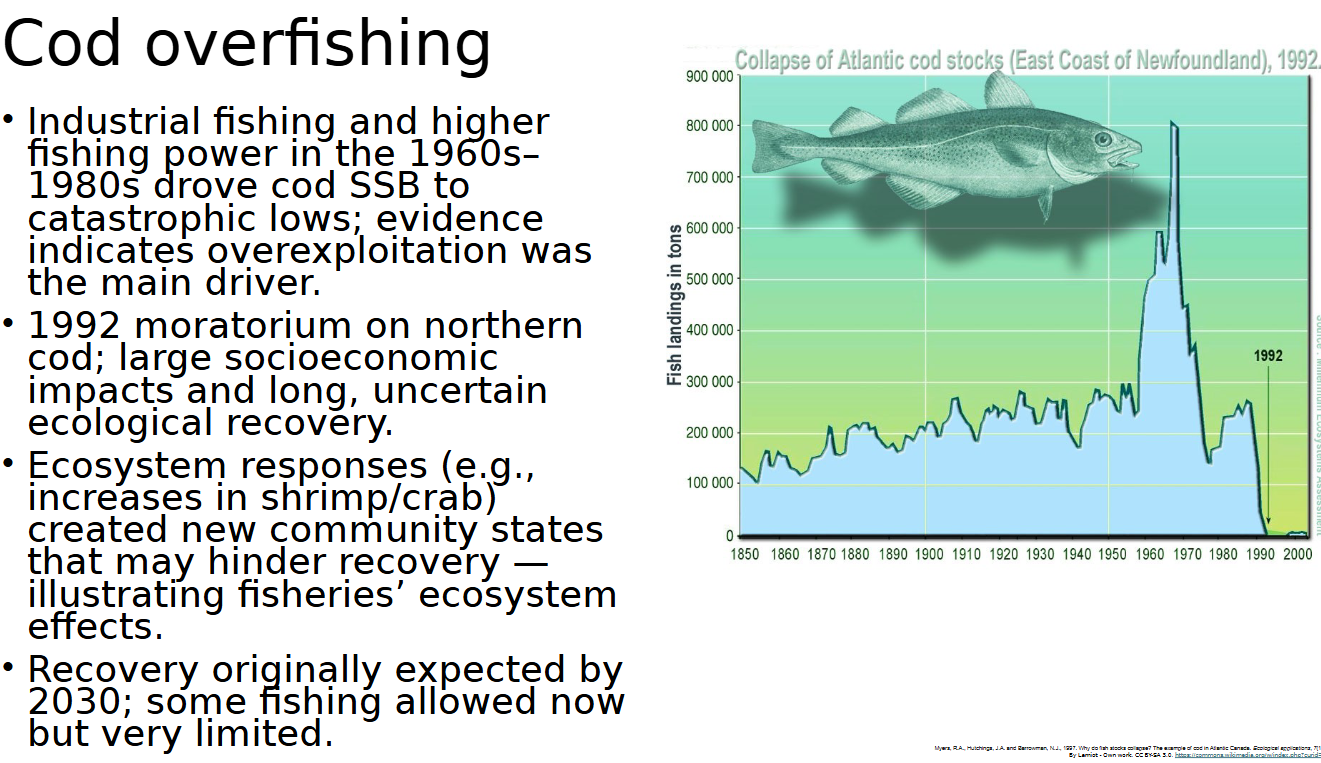
Benthic and deep sea specialists
Teleosts adapted to extreme or concealed habitats — flattened, camouflaged, or bioluminescent.
• Lophiiformes (anglerfishes) and Pleuronectiformes (flatfishes) exemplify radical body-plan modifications.
• Form follows function: lures, asymmetry, camouflage, and reduced light conditions.

Lophiiformes
•~350 species of anglerfishes
•Defining traits
•Dorsal spine modified as bioluminescent lure (esca)
•Enormous mouth and expandable stomach
•Mostly deep-sea or benthic marine
•males smaller than female
•Famous for sexual parasitism in deep-sea species (males burrows head into female and releases sperm)
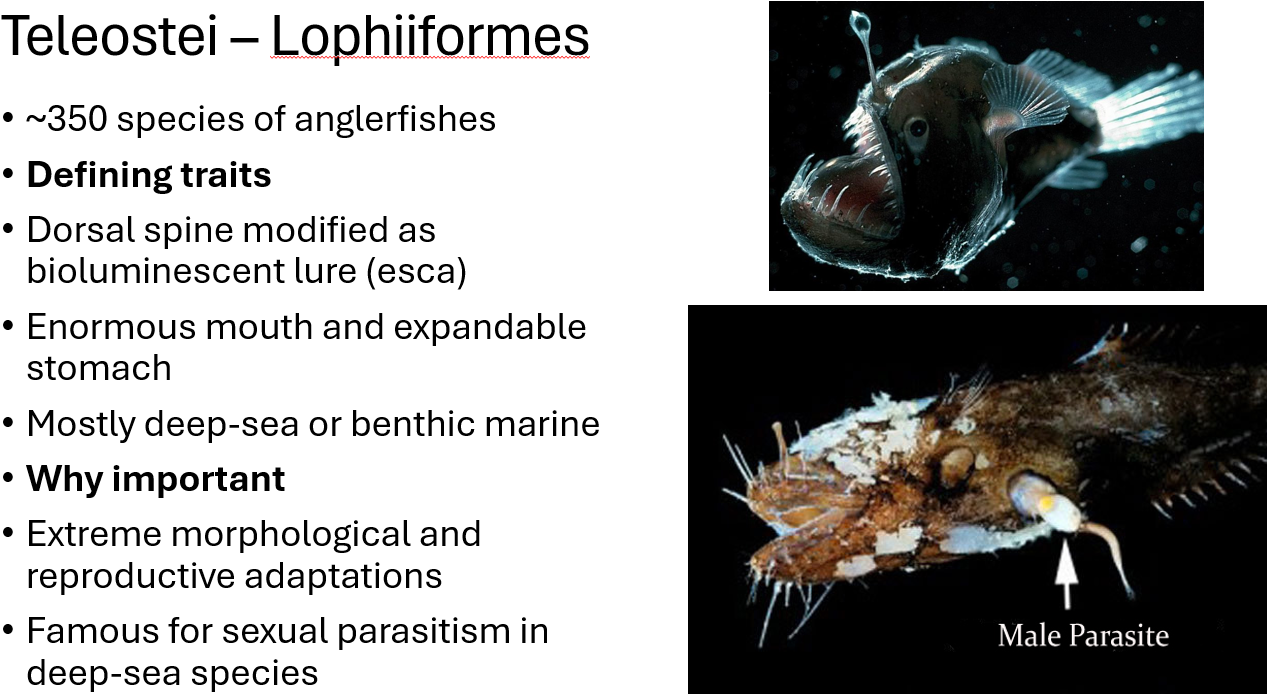
Pleuronectiformes
•~800 species of flatfishes
•Defining traits
•Asymmetric body; both eyes migrate to one side
•Dorsal and anal fins long, continuous
•Marine, bottom-dwelling
•Why important
•Unique developmental asymmetry (metamorphosis)
•Major commercial and ecological significance
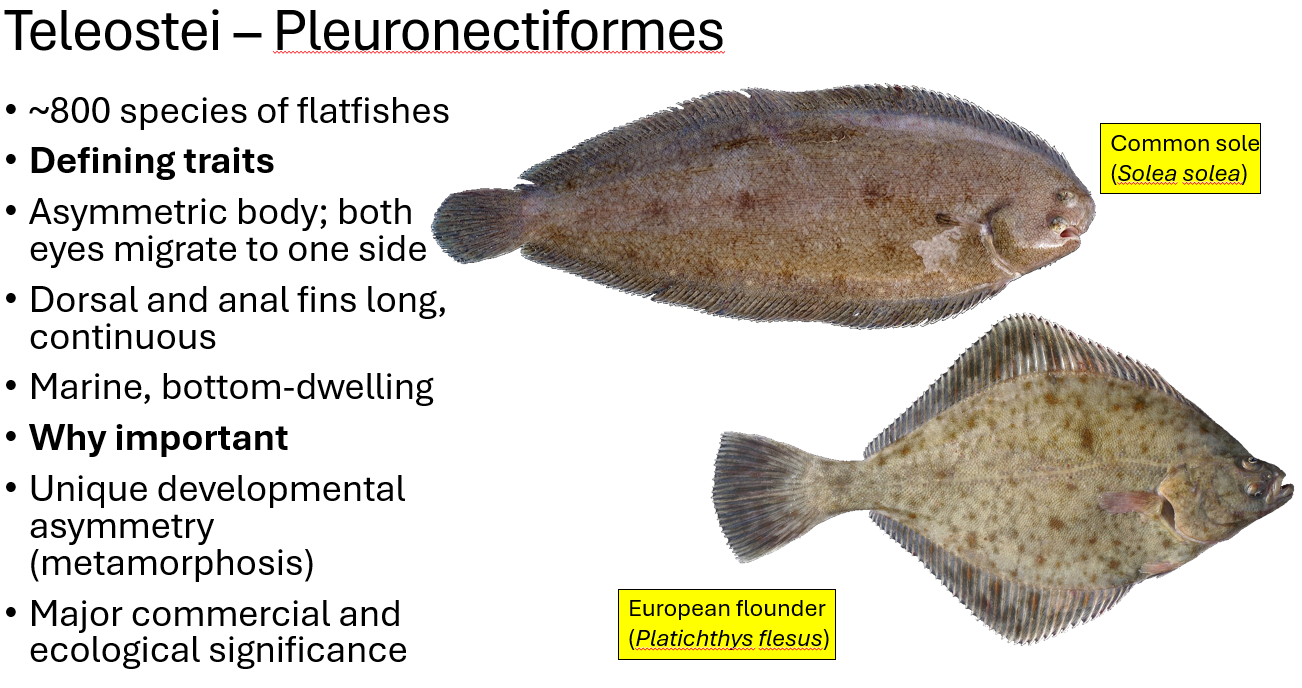
Pleuronectiformes begin life with symmetrical eyes like most fish, but undergo a dramatic metamorphosis where
one eye migrates to the other side of the head, resulting in the characteristic asymmetrical adult form.
Evolutionary experiments in body plan and behavior (ACP)
• Anguilliformes: elongation and fin loss — locomotor
specialization.
• Cichliformes: rapid adaptive radiation, behavioral
complexity, parental care.
• Perciformes: massive global radiation — generalist body plan gone universal.
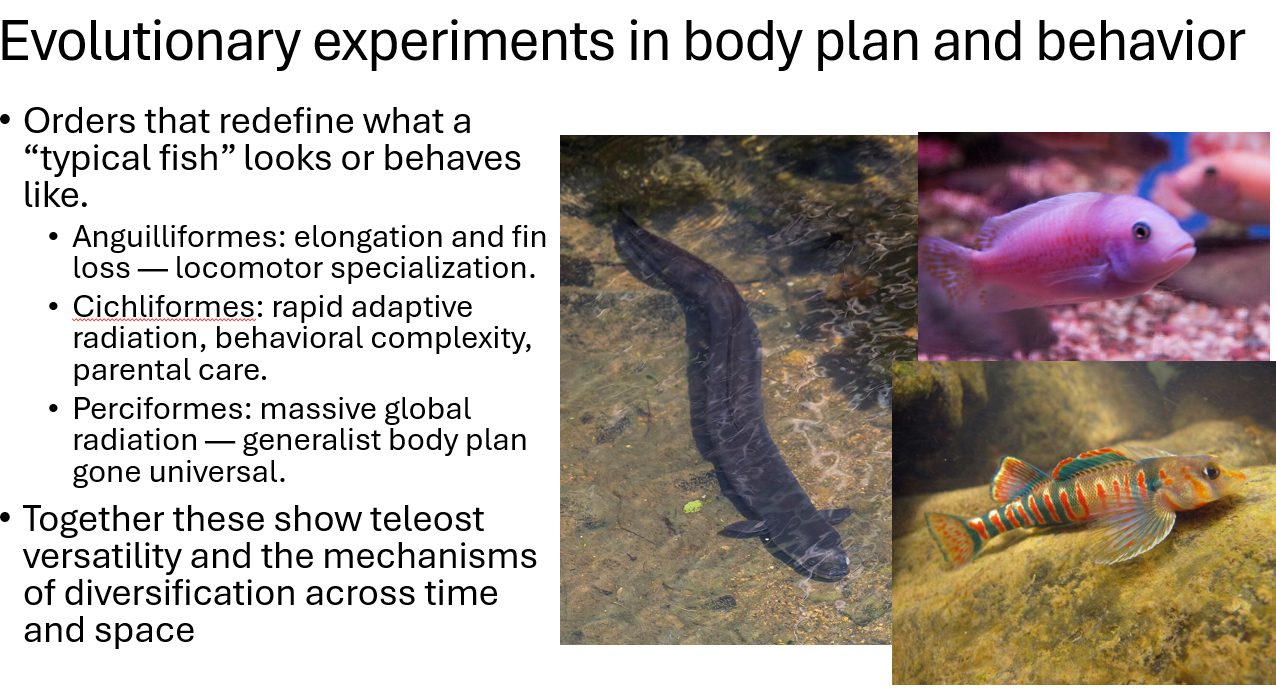
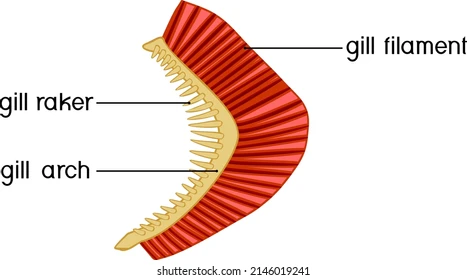
anguilliformes traits
•~800 species of eels
•Defining traits
•Elongate, scaleless or reduced-scale body
•Pelvic fins absent; dorsal, anal, and caudal fins continuous
•No gill rakers; extremely flexible vertebral column
•Why important
•Many have catadromous/opp of anadromous life cycle (spawn in saltwater but spend most of life in freshwater, river to ocean for spawning)
•Dramatic body elongation — convergent evolution with other elongate vertebrates
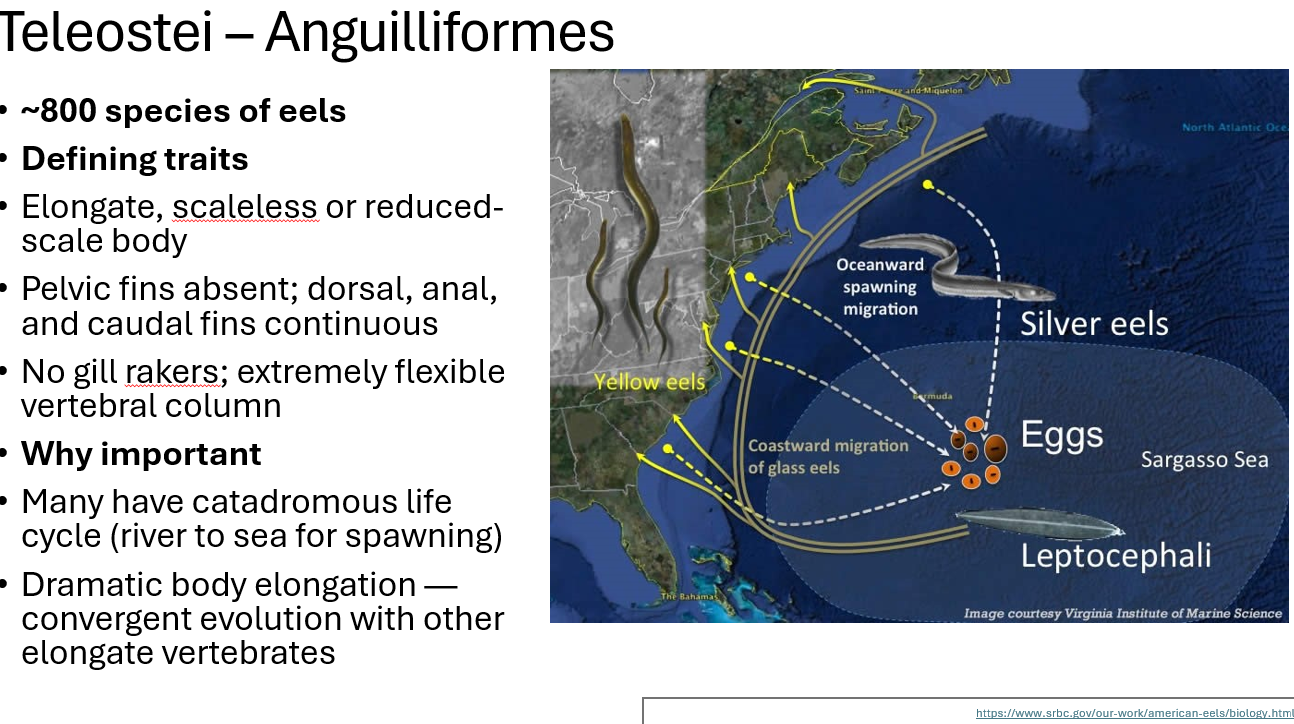
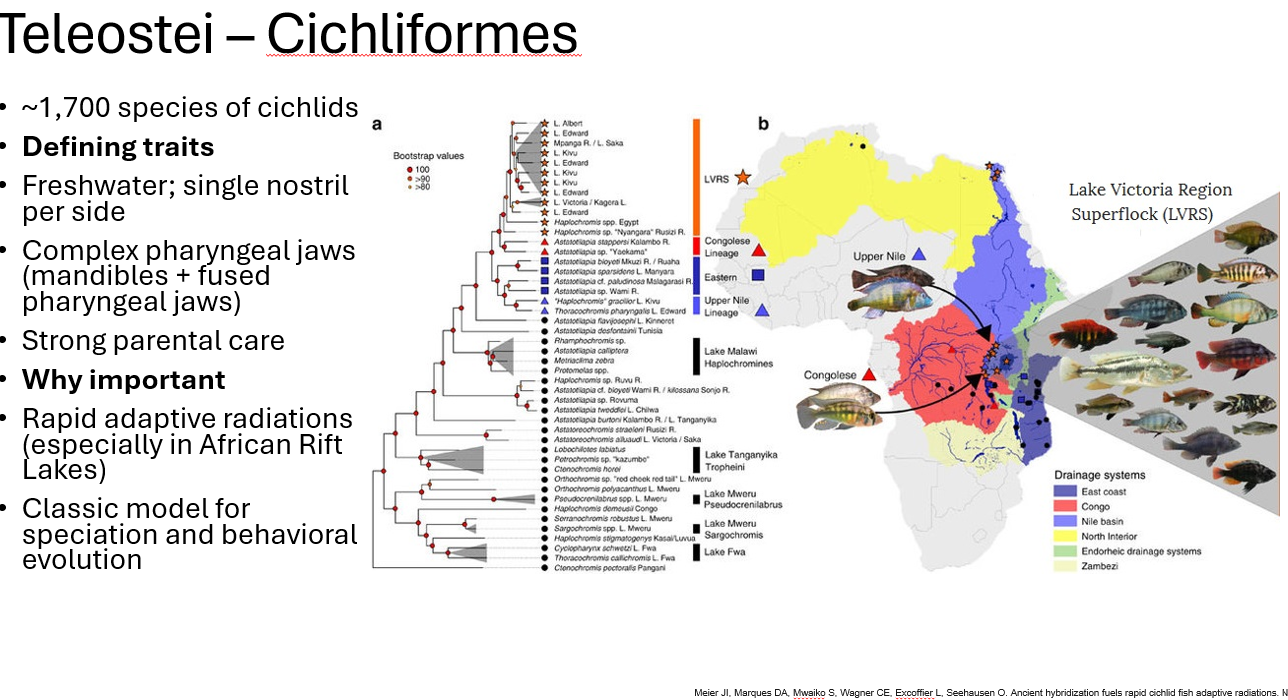
Cichliformes traits
•~1,700 species of cichlids
•Defining traits
•Freshwater; single nostril per side
•Complex pharyngeal jaws (mandibles + fused pharyngeal jaws)
•Strong parental care
•Why important
•Rapid adaptive radiations (especially in African Rift Lakes)
•Classic model for speciation and behavioral evolution, they each have a lot of niche partitioning by species differentiation to avoid competition
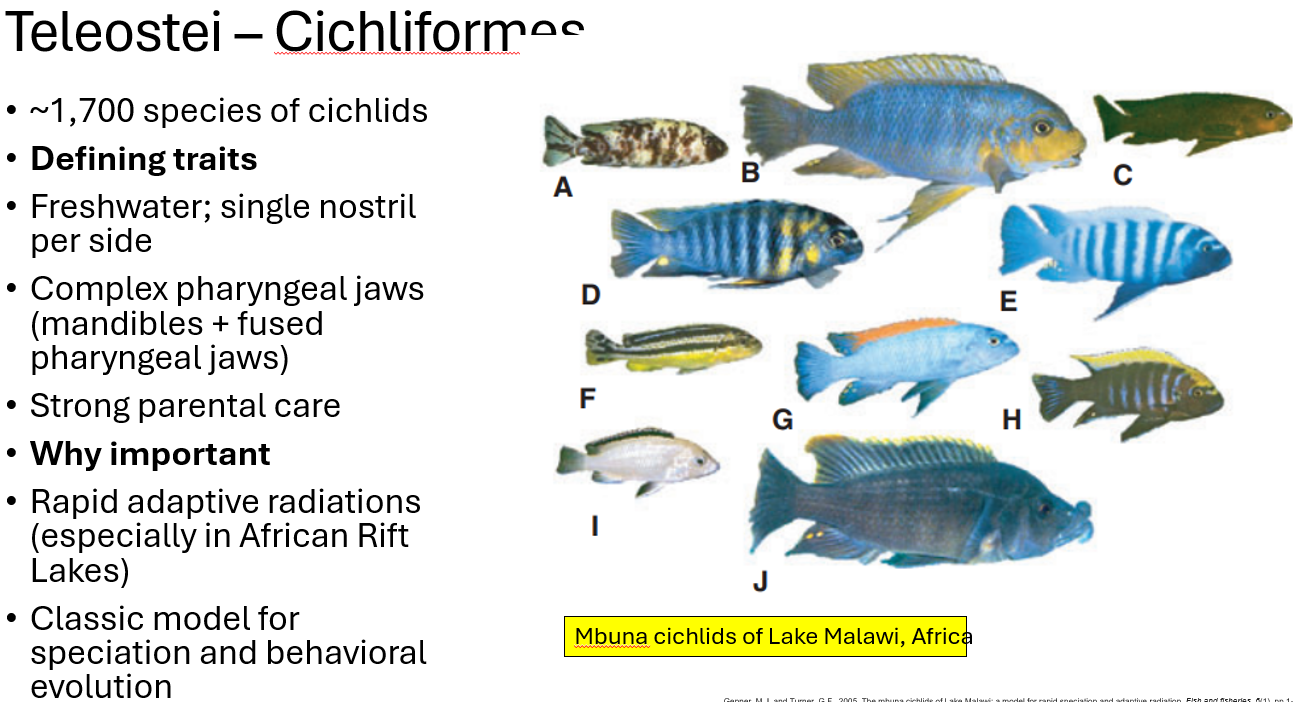
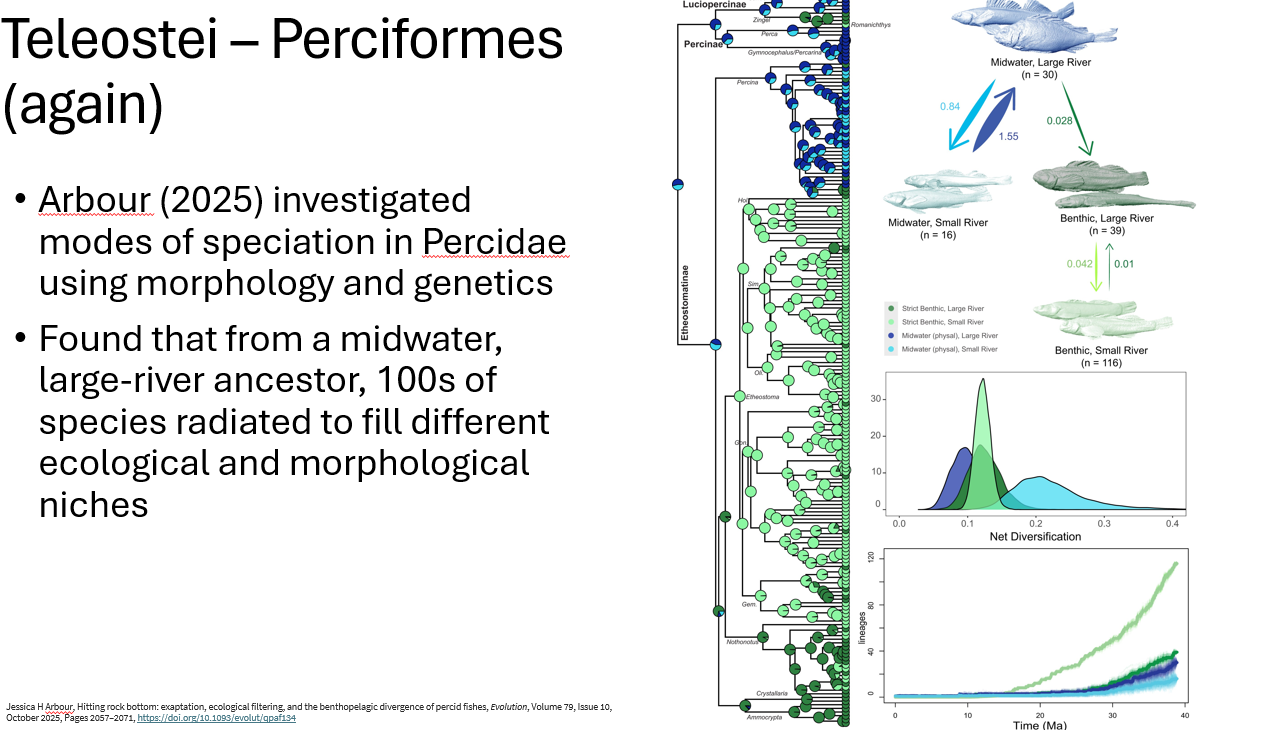
what does this figure show
•Arbour (2025) investigated modes of speciation in Percidae using morphology and genetics
•Found that from a midwater, large-river ancestor, 100s of species radiated to fill different ecological and morphological niches. the
Chondrichthyes are the gnathostome sister clade to what and Acanthodii (“spiny sharks”) are paraphyletic group basal to a stem group
Osteichthyes (outgroup shown here). crown chondrichthyans...i.e.,
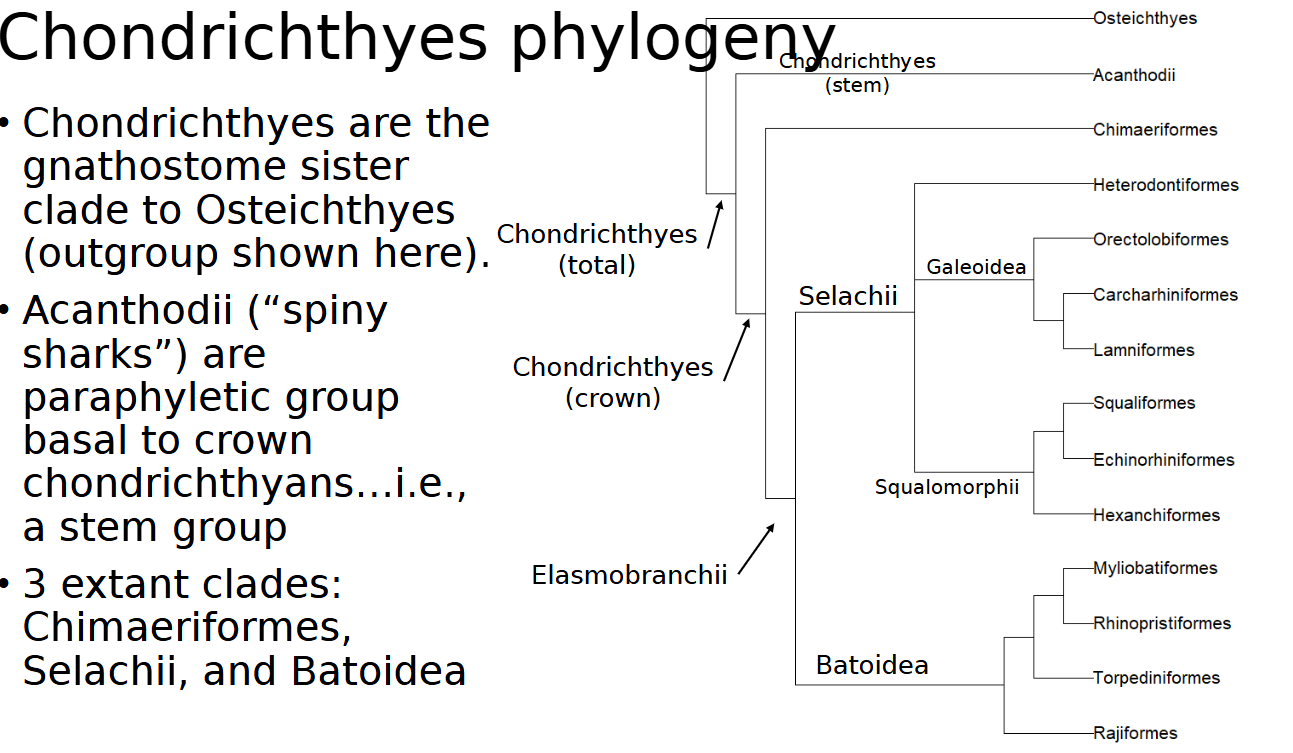
3 extant clades of Chondrichthyes
Chimaeriformes, Selachii, and Batoidea
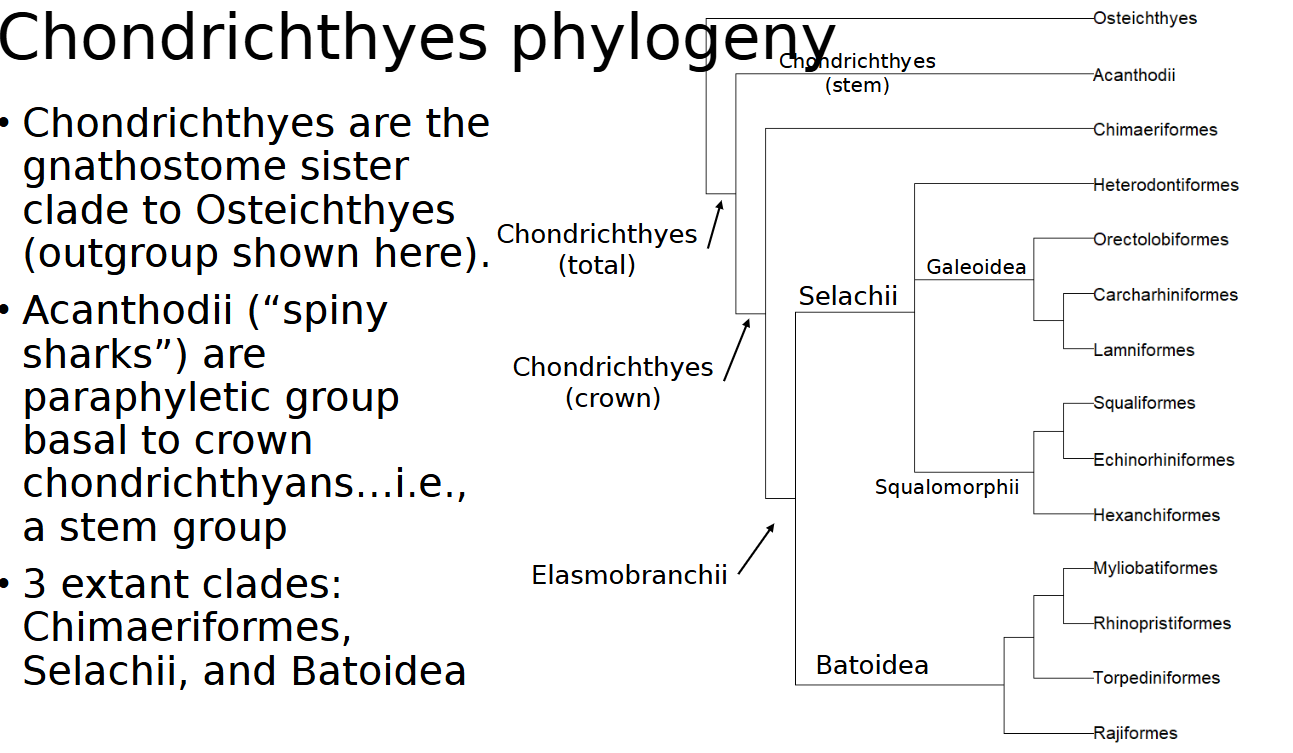
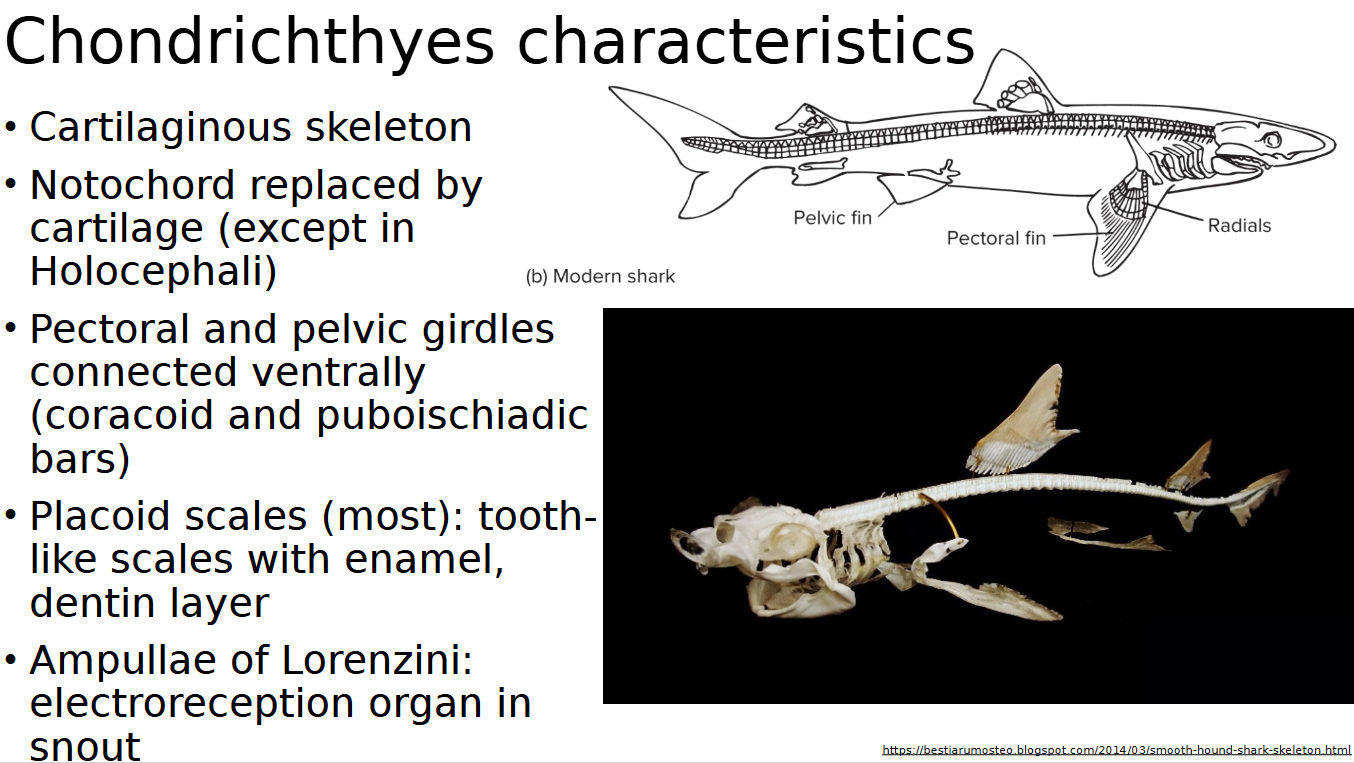
Chondrichthyes traits
Cartilaginous skeleton
• Notochord replaced by cartilage (except in
Holocephali)
• Pectoral and pelvic girdles connected ventrally
(coracoid and puboischiadic bars)
• Placoid scales (most): tooth- like scales with enamel,
dentin layer
• Ampullae of Lorenzini: electroreception organ in snout
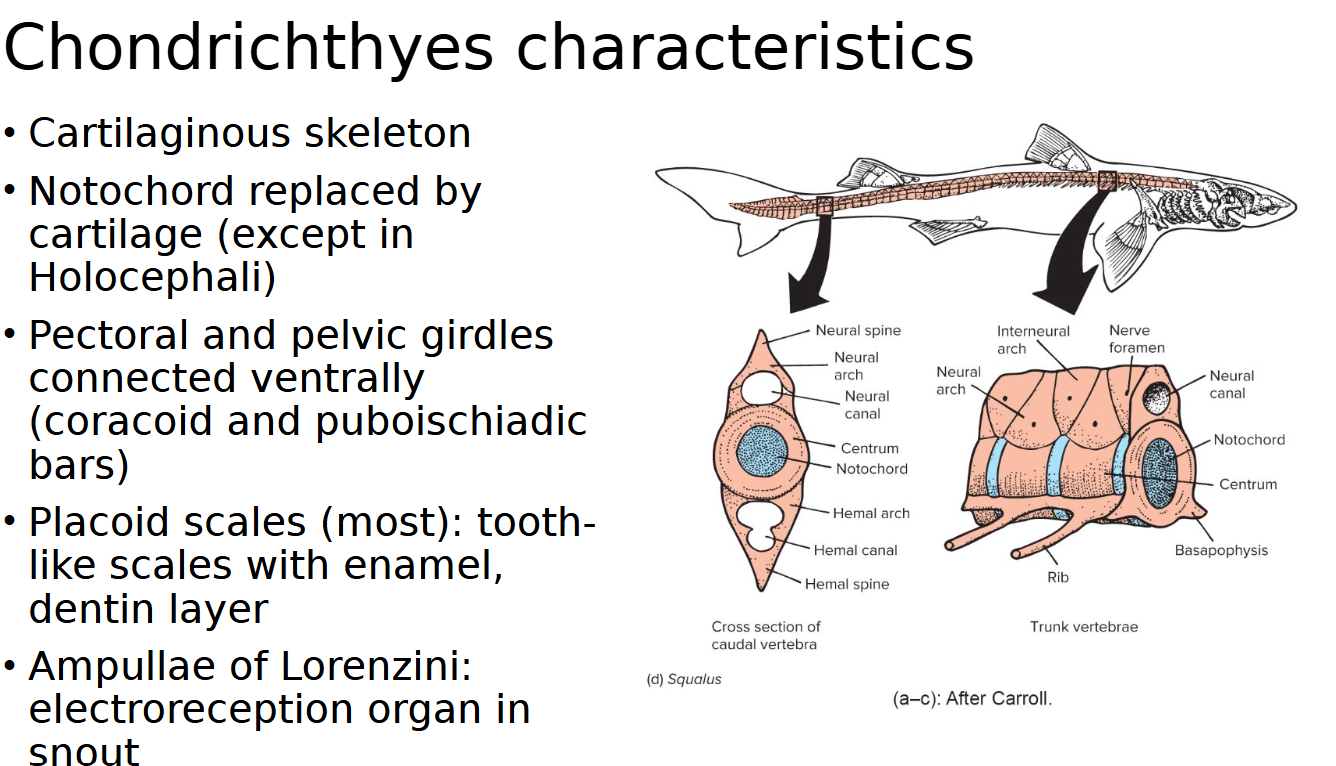
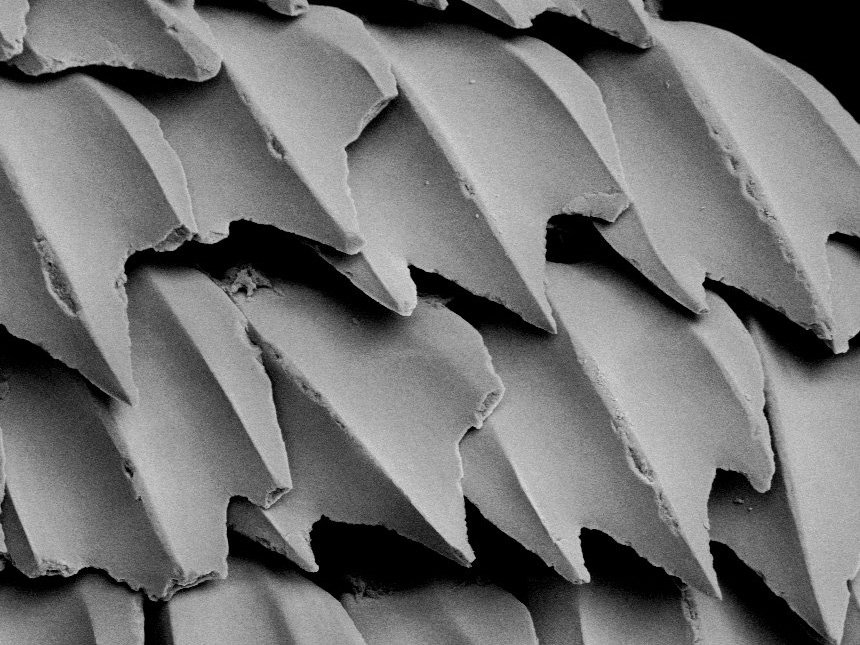
placoid scale made of
dentin and enamel; homologous with teeth
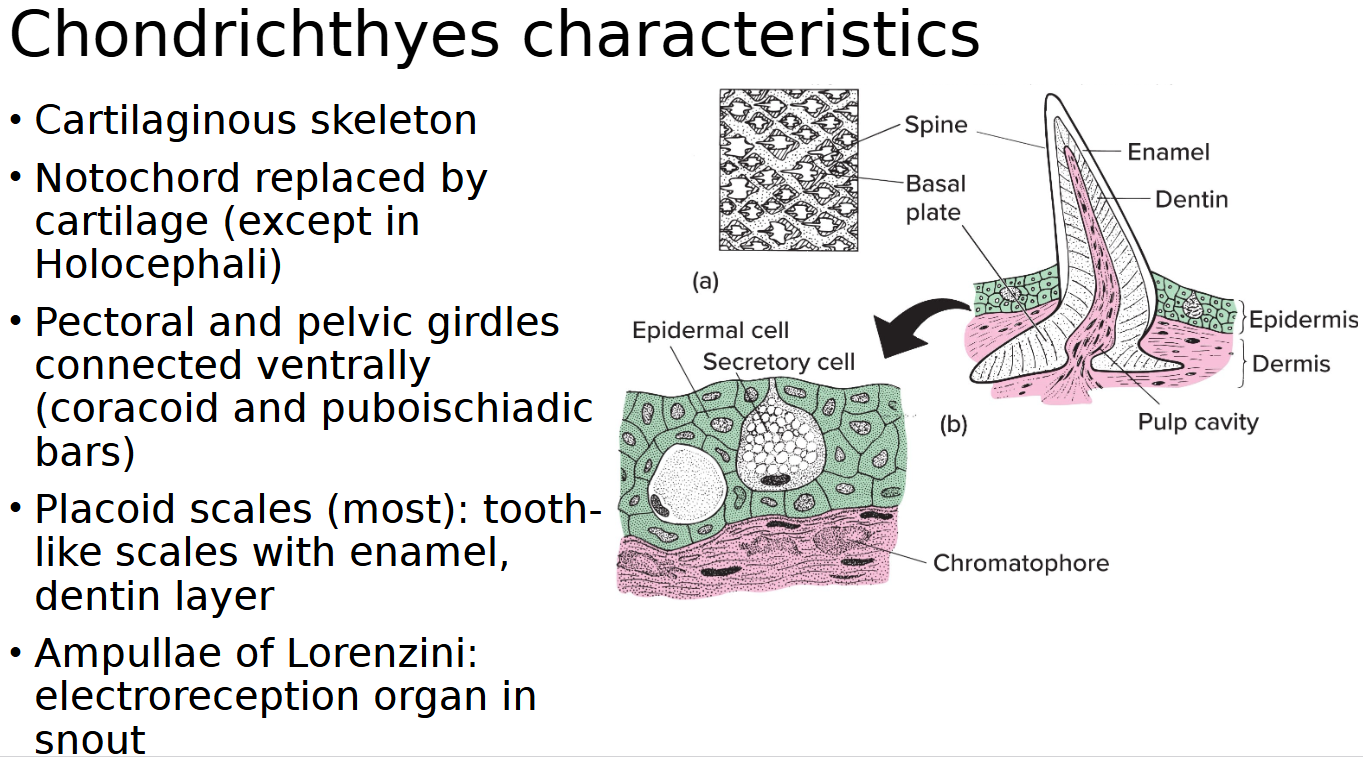
placoid scales important for
turbulence control where water moves faster while reducing drag
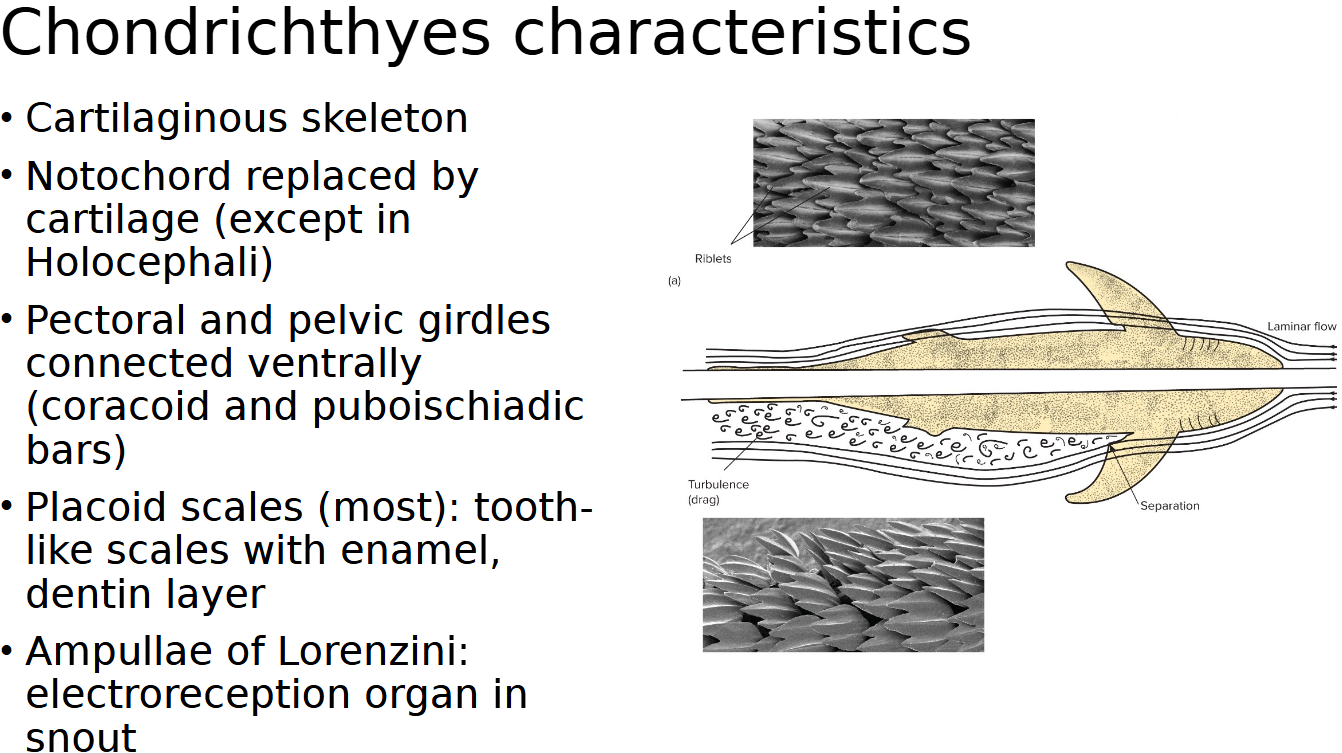
Ampullae of Lorenzini
organ that helps shark detect the electrical signal made during muscle contraction of other fish
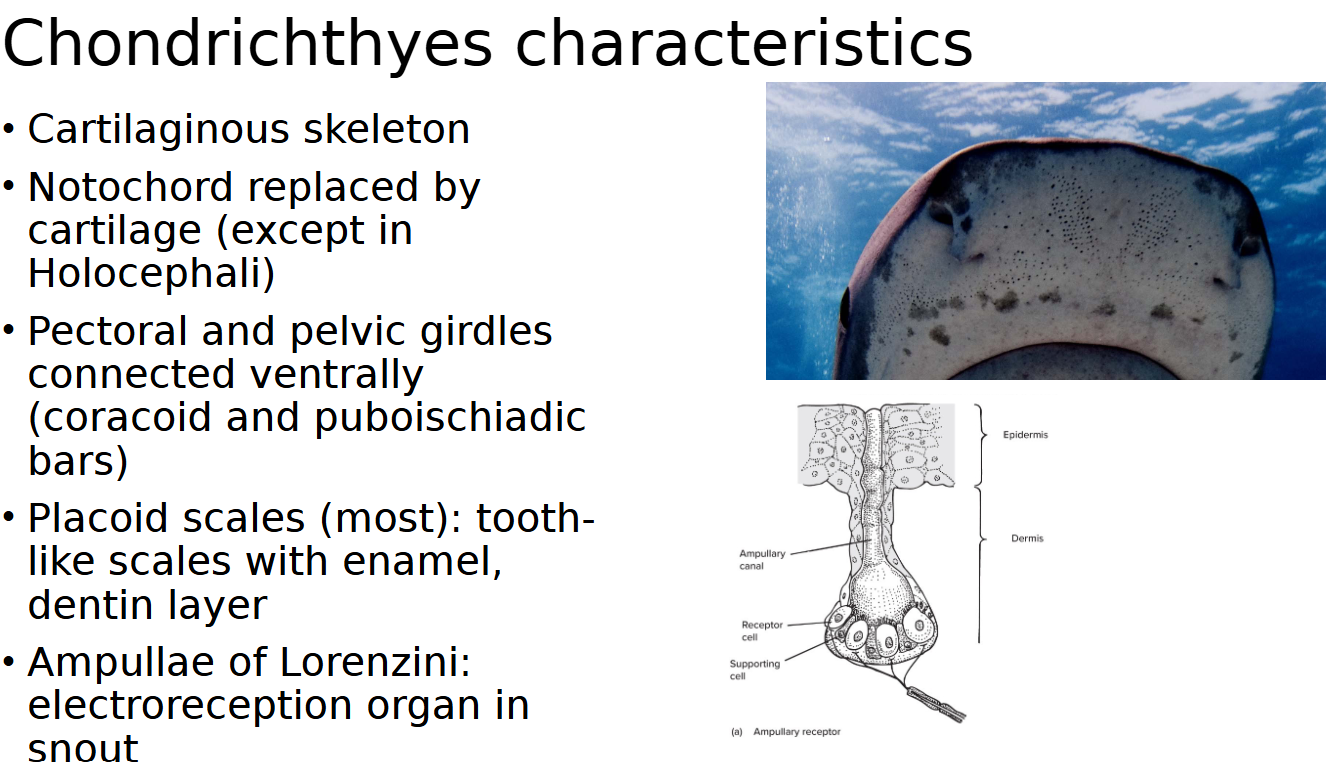
Chondrichthyes do not have a swim bladder instead they have
livers that produce an oil called squalene to help them with buoyancy
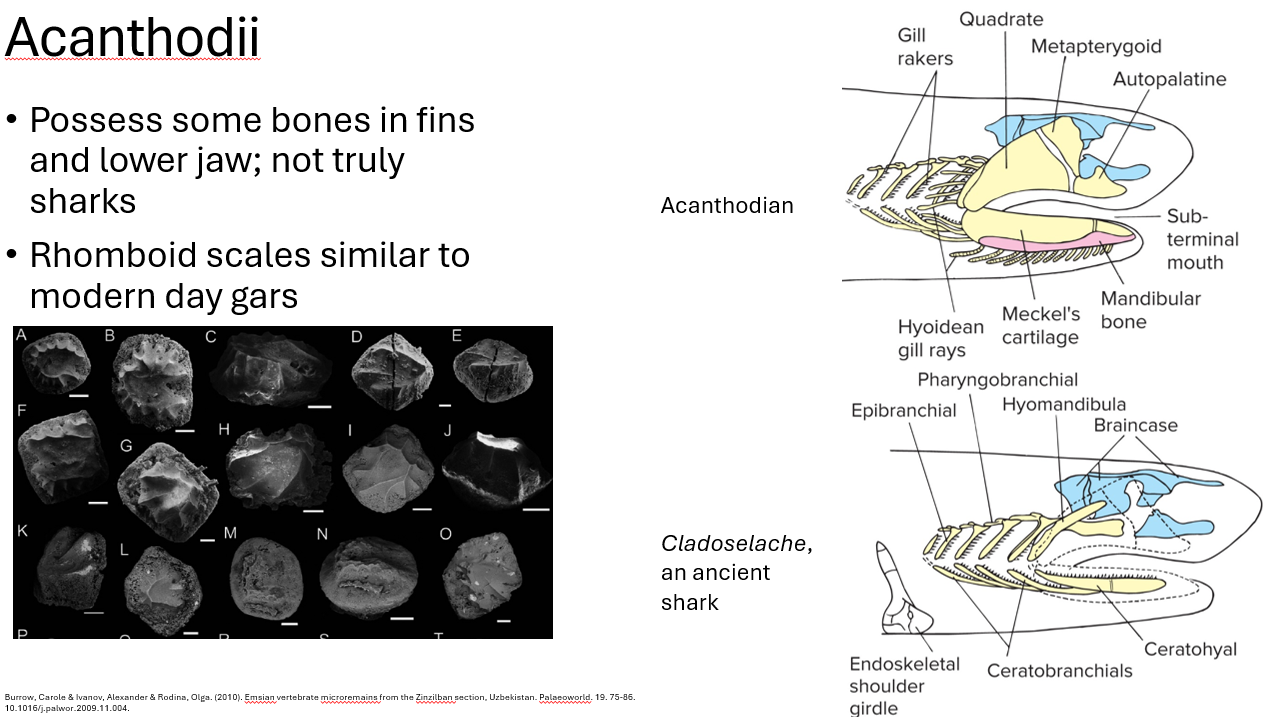
Acanthodii traits
“Spiny sharks”: extinct shark relatives from Silurian-Permian (440-250 Mya)
• Phylogenetic position uncertain; currently considered a paraphyletic grade basal to extant Chondrichthyes
• Possess some bones in fins and lower jaw; not truly sharks
• Originally all marine; some evolved to be freshwater
• Eventually outcompeted by bony fish
•Possess some bones in fins and lower jaw; not truly sharks
•Rhomboid scales similar to modern day gars
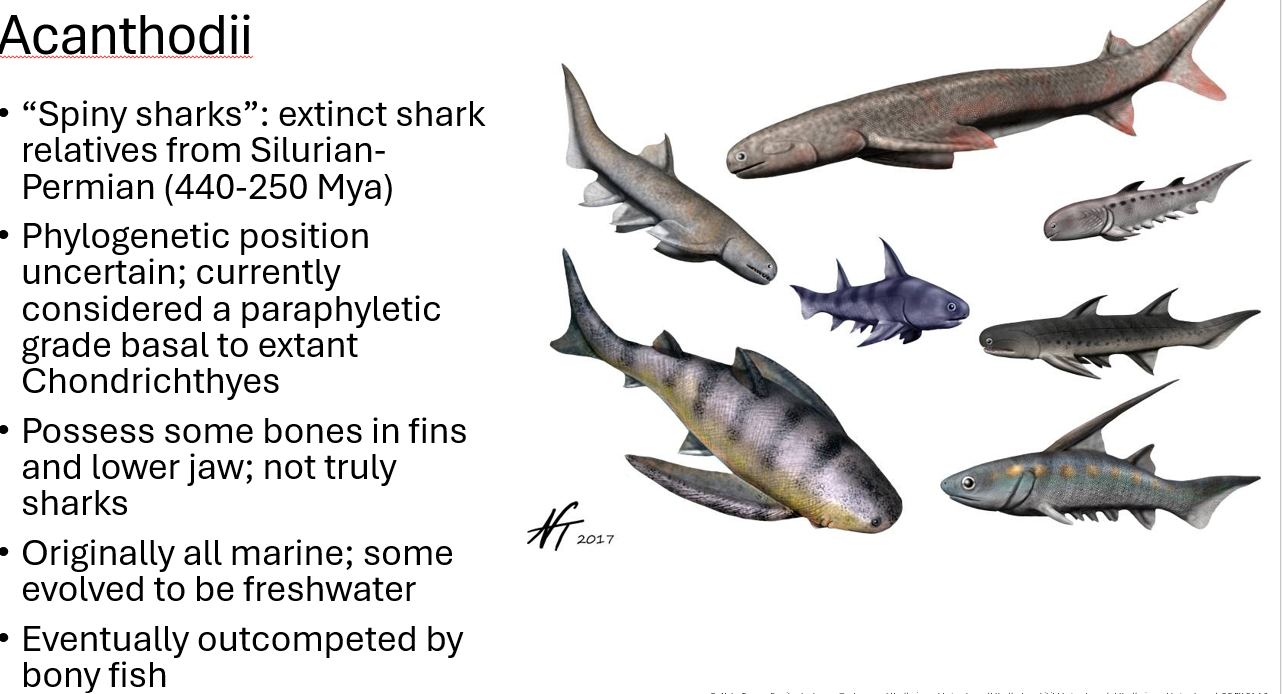
acanthodians have what apart of their jaws
meckel’s cartilage and a quadrate and mandibular bone
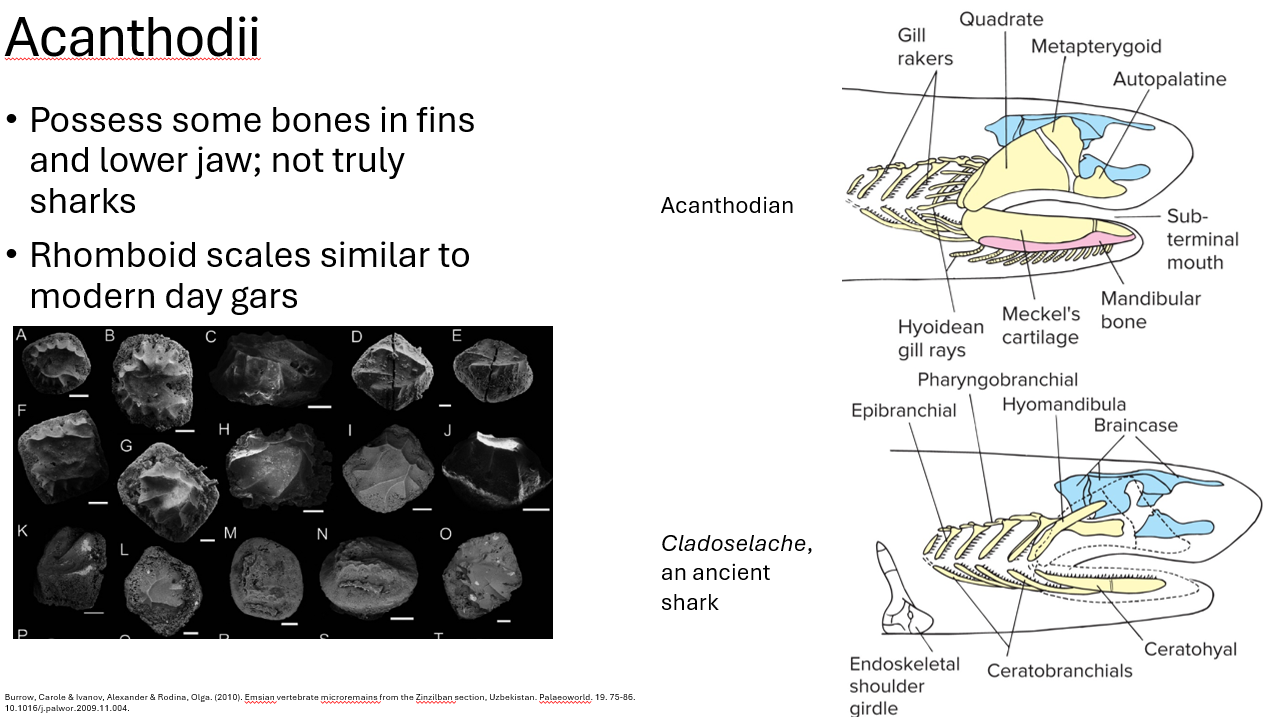
Chimaeriformes traits
•Diverged from elasmobranchs ≈400 Mya
•≥50 species of chimaeras (ratfish, ghost sharks, many names)
•Upper jaw fused to braincase
•Fleshy operculum (gill cover)
•Toothplates instead of teeth, different mineralization than enamel
•Males possess tentacula to assist in mating
•Forehead: hold female’s pectoral fins
•Prepelvic: hold female’s pelvic fins
•Separate anal and urogenital openings
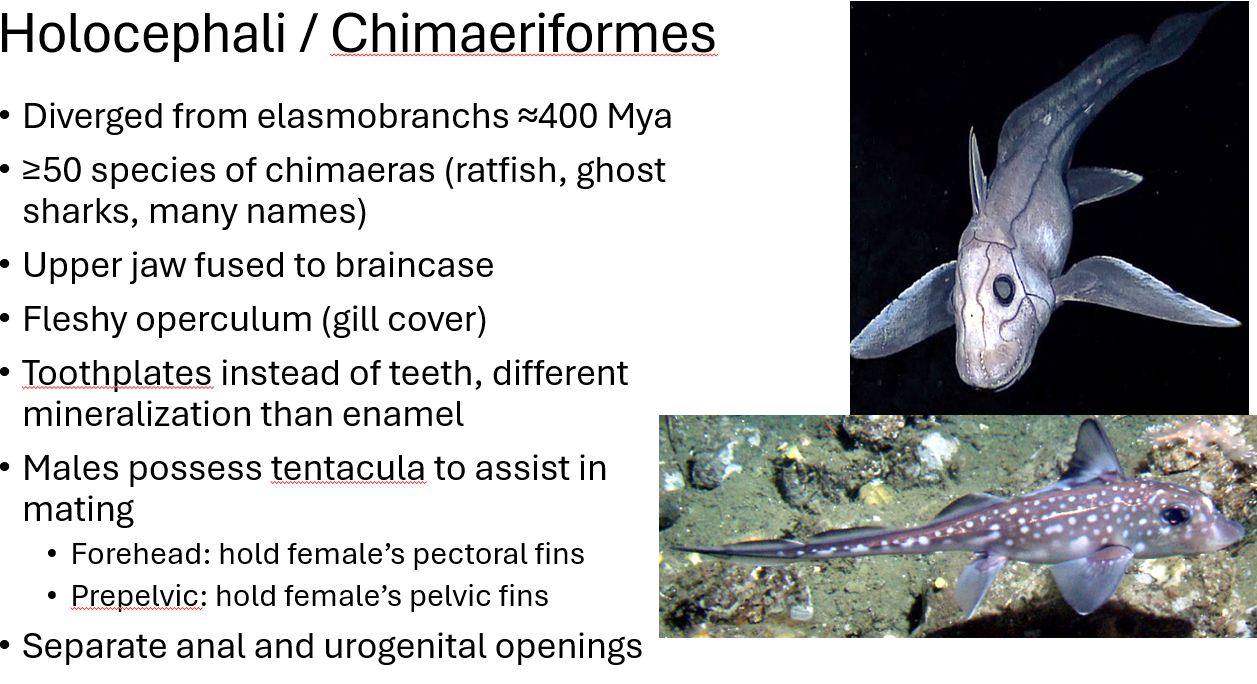
holocephali means
whole head
Elasmobranchii traits
•≥1125 species of sharks and rays
•Lack swim bladder
•5-7 pairs of gill slits, no operculum
•Small placoid scales
•Teeth constantly replaced
•Placoid scales
•Upper jaw not fused to braincase
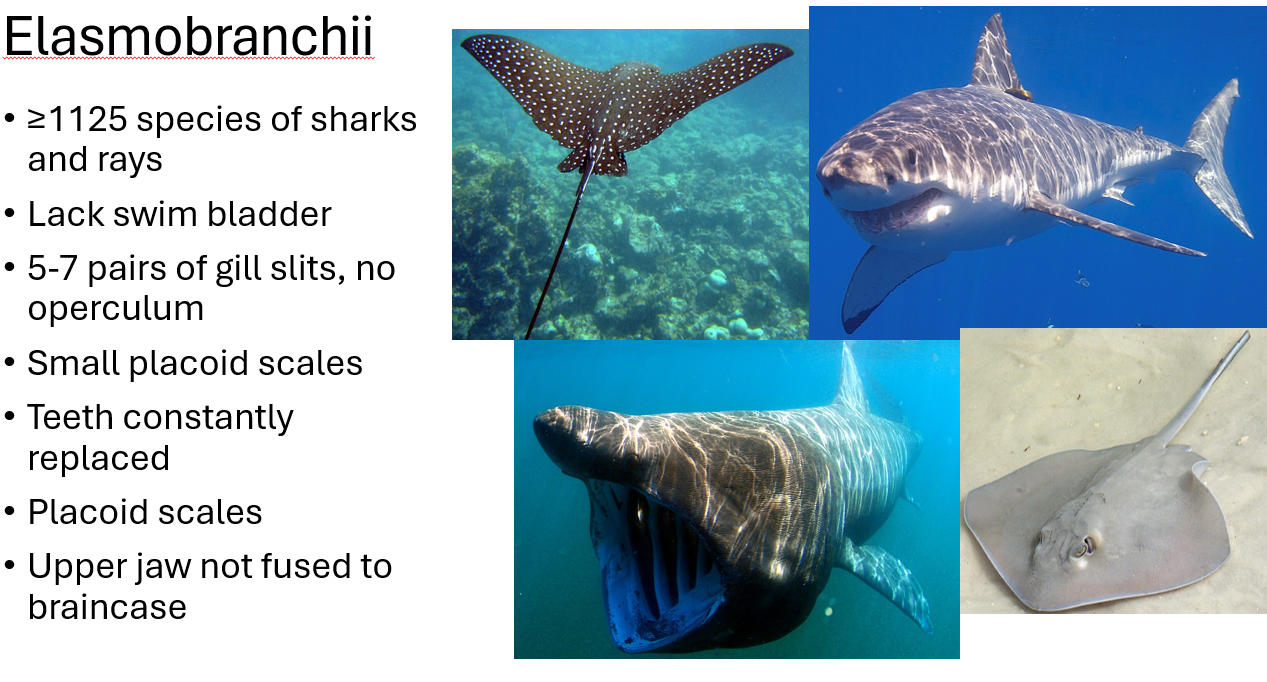
selachii traits
•≥557 species in 8 orders
•All but one species marine, but some can use freshwater habitats
•Streamlined body (vs. rays)
•Short digestive tracts with spiral valve intestine; can evert stomach to expel undigestible matter
•Internal fertilization; can be oviparous, viviparous, or ovoviviparous
•Dermal denticles (placoid scales) homologous with vertebrate teeth
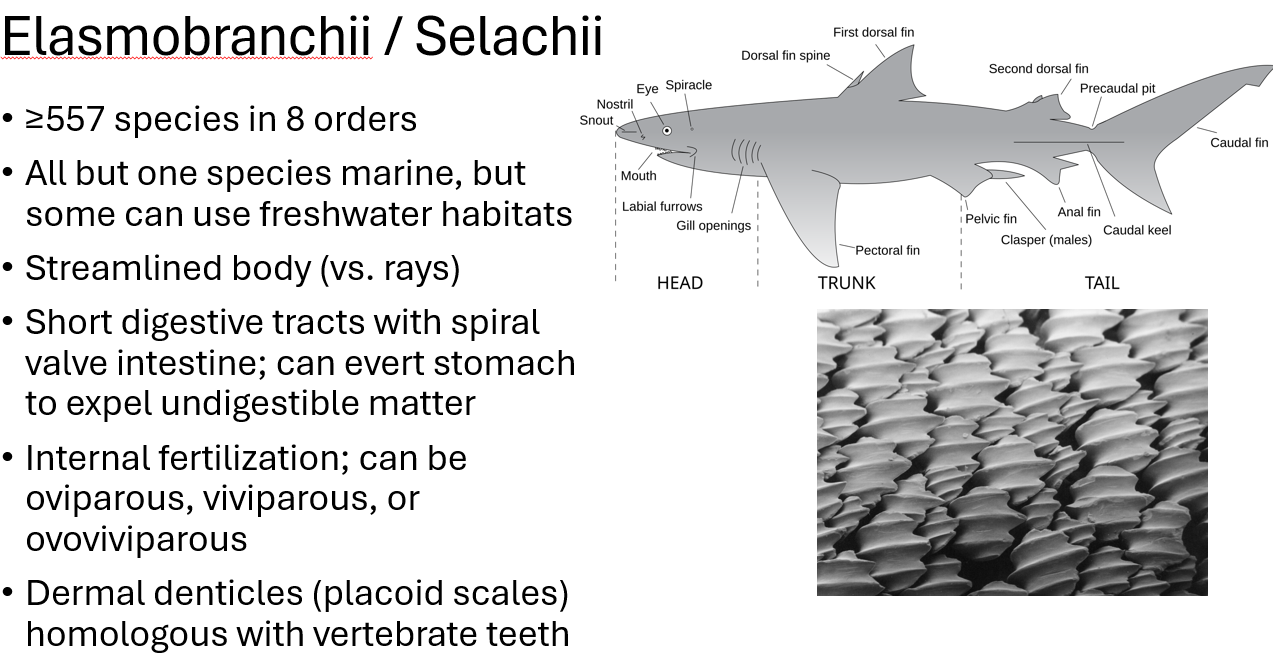
other clades’ penises vs shark casper
develops from cloaca vs develops from pelvic girdle, homologous because they both fertilize eggs
